Prelude: Current travels to round off 2023
Hello there from Ho Chi Minh City, Vietnam! We are already into the final days of 2023, and that can only mean that my massive seven-flight escapade across India and Vietnam (in the fashion of Ben from One Mile at a Time‘s globe-spanning review trips) to put the finishing touches on the year has begun. If 2022 was an extraordinary year in terms of personal aviation and travel, 2023 has been extraordinary times extraordinary. It wouldn’t be complete without the one and only Airbus A380 superjumbo, which I made the starting leg of my journey: SQ424 from Singapore to Mumbai, operated by 9V-SKV. The thrill and sensation of flying with a whole entire deck above you is something I am yet to be fully accustomed to.
After spending a half-sleeping, half-roaming but all-exciting night across Terminal 2 of Chhatrapati Shivaji Maharaj Airport — from the humble chairs and couches next to the sprawling and ornately beautiful check-in gates, to the luxurious Adani domestic lounge with its full breakfast array — I went to Bengaluru one more time for the Christmas weekend. That too on an aircraft that is not even a month old: VT-TQT, Vistara’s second-newest A320neo (flight UK851) at the time of writing. The stage was thus set for a continuation with Cathay Pacific Airways, VietJetAir and Vietnam Airlines across three cities whose names begin with the letter H (it’s easy to figure out which ones from that set of airlines) — a perfect bookend to a year that began in another H-city, Hyderabad. For the first time, all three alliances will be covered in a single trip.
I’ll be touching more upon the CX flights (A350 B-LRB from BLR to HKG, A321neo B-HPF to HAN) in summer 2024, but I’ll tell you one thing: CX might just have the most perfect brand system and typography of any airline in the world, all the more so because it is Chinese, and Northeast Asian airlines (yes, even the best ones, like EVA Air) tend to have awful and inconsistent brand images. HKG itself blew my mind with its Sky Bridge and its panoramic aircraft views, making me marvel at how one of the world’s biggest hubs has been bouncing back after a COVID-stricken three years and the protests before that. Vietnamese airports, on the other hand, are anything but modern and impressive — among the worst in Southeast Asia for their size — but VietJetAir and Vietnam Airlines promise to be perfectly pleasant, if not outstandingly exceptional (eCXeptional?), experiences flying through my last country for 2023.
Let’s get back to a memorable July evening with a cute little trip, then!
Introduction: Five hours in Kuala Lumpur (and only two in the city)
With the epic trip to Indonesia at the start of June now put behind — a KLM 777-300ER in the SkyTeam livery to Denpasar, two Garuda A330-300s on the return via Jakarta — it is now time for one last hurrah for 2023, with this flight 638 coming straight after Garuda flight 836 in order of publication. At the end of July I decided to wrap up some ‘unfinished business’ from my whirlwind weekend trip to Kuala Lumpur in May, specifically involving the Christine’s bakery, whose exquisite décor and packaging (a bag of which I’d taken from the Mid Valley Megamall outlet in May, but ended up losing) I wanted to keep a taste of. So, as soon as I cleared immigration at 6:30pm, I went to the Bandar Sunway township in the west of the city and, after briefly checking out the gigantic Sunway Pyramid mall as dusk fell, headed to the Sunway Geo Avenue branch of Christine’s to bag one before I returned all the way down to KLIA.
Having already flown Ethiopian Airlines’ late-evening fifth-freedom service from KL back to Singapore in May, I wanted to have a taste of the outbound, especially as it was being operated by the newer 787-9 on certain Sundays in the summer. That Africa’s largest airline, and one of the Star Alliance’s most global airlines, operates a bunch of fifth-freedom services in Asia (much like KLM) is a treat in itself, though I wish they were flown by A350s — whose only Asian destinations are Beijing and Shanghai — rather than 787s. Funnily enough, the 787-9 operating this very flight (ET-AUO, the airline’s first of ten so far) is itself called Beijing!
Also, I’d never flown Jetstar Asia Airways (3K) before, seeing as Qantas’ low-profile Singaporean offshoot has a very limited fleet of ten-odd A320ceos — and hasn’t enjoyed the glut of new aircraft that its Australian and Japanese counterparts have — and sticks to only some ASEAN cities, never venturing into India or Northeast Asia. Given that I’d flown Scoot’s A321neo on the outbound in May — not an experience I’d wish to repeat; it is one of my least favourite airlines in the world thanks to its irritating and snooty marketing — I wanted to find out how 3K was doing on the return at night. I’m afraid 9V-JSL was a very cramped aircraft, one of the tightest I’ve ever flown in — but otherwise the flight was perfectly decent for a no-frills carrier: no amenities but a wider food selection than IndiGo’s measly sandwiches and noodles, and without Scoot’s trying-too-hard-to-be-cool stupidity. I hope 3K grows further than its current state, since it has the potential to become much bigger than the minnow it currently is.
Another upside was that I’d seen the KLIA2 arrivals and KLIA main terminal departure experience in May, and now I switched them around, arriving at the full-service carrier terminal and departing from the low-cost terminal. Despite its immense distance south of the city — the furthest of any city in Southeast Asia — KUL (the main terminal, to be precise) remains one of my favourite airports in Southeast Asia after Changi, with Denpasar also up there. The year as a whole as been shaped by little trips like these, more than the big multi-flight itineraries, so let’s get straight into it!
Note: This trip was kept a secret from one and all, above all my family, who is always informed about my whereabouts otherwise. Also, this was the very first time I travelled without any checked-in baggage whatsoever, which is otherwise unthinkable.
Flight routing
- 1ET638 | Singapore to Kuala Lumpur | 30 July 2023 | 787-9 | ET-AUO
- 23K688 | Kuala Lumpur to Singapore | 30 July 2023 | A320 | 9V-JSL
Pre-departure: Ethiopian part 2
Sunday, 30 July. Ethiopian has ten 787-9s so far, nine of which are named after cities, with the following registrations and names: ET-AUO (Beijing), ET-AUP (London), ET-AUQ (Frankfurt), ET-AUR (Tokyo), ET-AXK (Tel Aviv), ET-AXL (Toronto), ET-AXT (Athens), ET-AYC (Bangkok) and ET-AYD (Brussels). (All are Star Alliance hubs, with home carriers ranging from Aegean to ANA to Lufthansa, except London and Tel Aviv.) The sole exception is ET-AXS, which is named after Al-Nejashi, the ruler of the Kingdom of Axum in the seventh century AD. Of these, the very first — built in October 2017 — would be serving today’s flight.
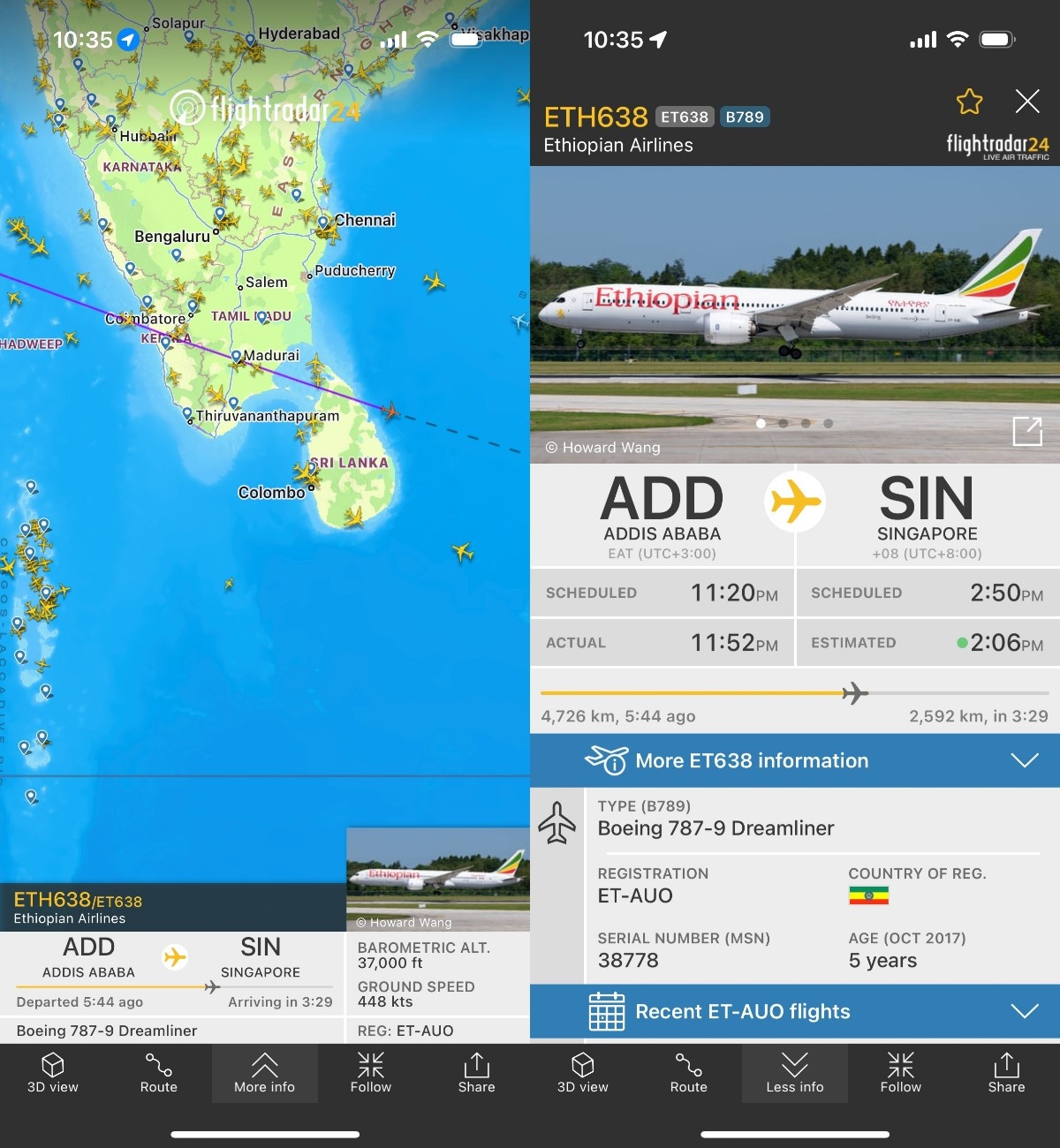
By the end of the day I would add to the collection of two magazines for the year, a Holland Herald and a Selamta, with another Selamta. Unfortunately none of the other non-Indian airlines I have flown this year have an inflight magazine any more, with the exception of the relaunched Cathay magazine, replacing CX’s Discovery magazine. (Indian airlines continue to maintain their inflight magazines, like the eponymous Vistara and IndiGo’s Hello 6E.)
At 1pm I sneaked out of the house and headed towards Bedok MRT station in the east end of Singapore.

A stop away was Tanah Merah, where you interchange for the train to Changi. Singapore does not have an ‘Airport Express’ train, unlike most other East Asian cities, since Changi is much closer to the city centre than KUL, the furthest of any Southeast Asian city.

At the Changi Airport station, a number of excited travellers pointed towards the flight information screens.
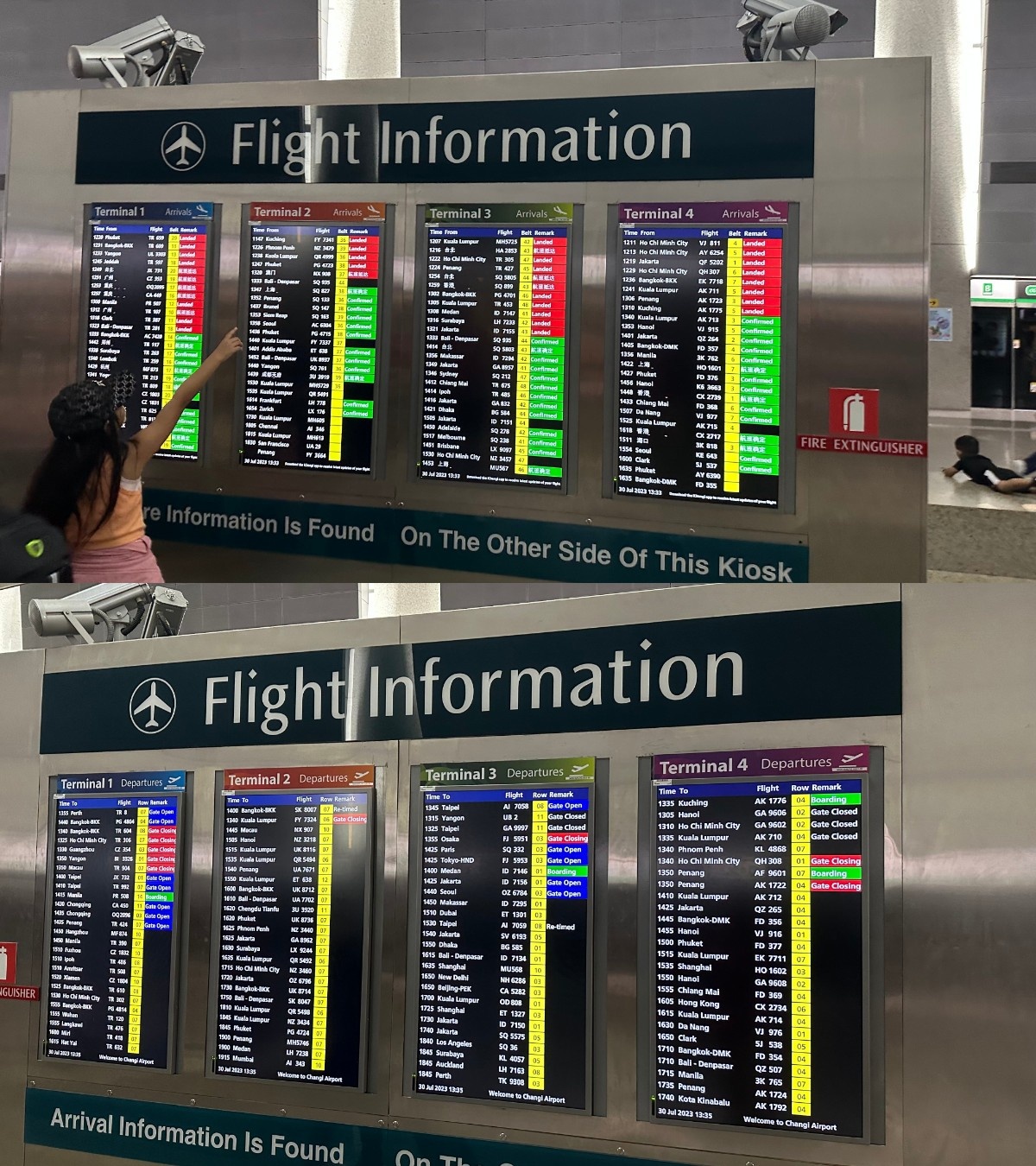
The grandeur of Terminal 2 lay in wait for one and all, though certain areas were still under construction, which were fenced off by classy wooden panels and ‘artist’s impressions’.

This is too beautiful, too indulgent a terminal for the rest of the world. Take that, Doha Hamad! Always trying to one-up us, aren’t you?
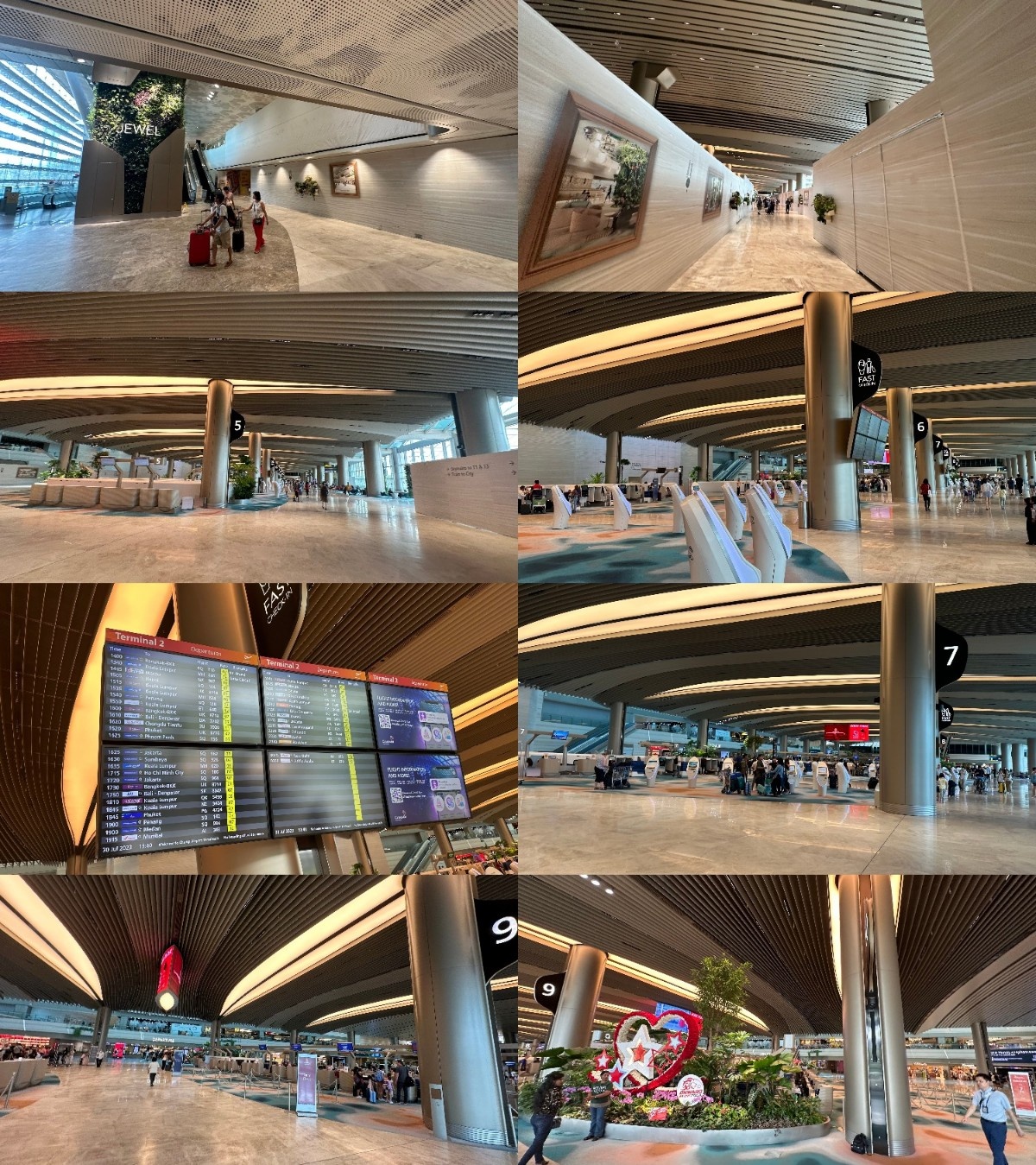
If fantasies of imagination took the form of concrete and steel, this is what they would look like.
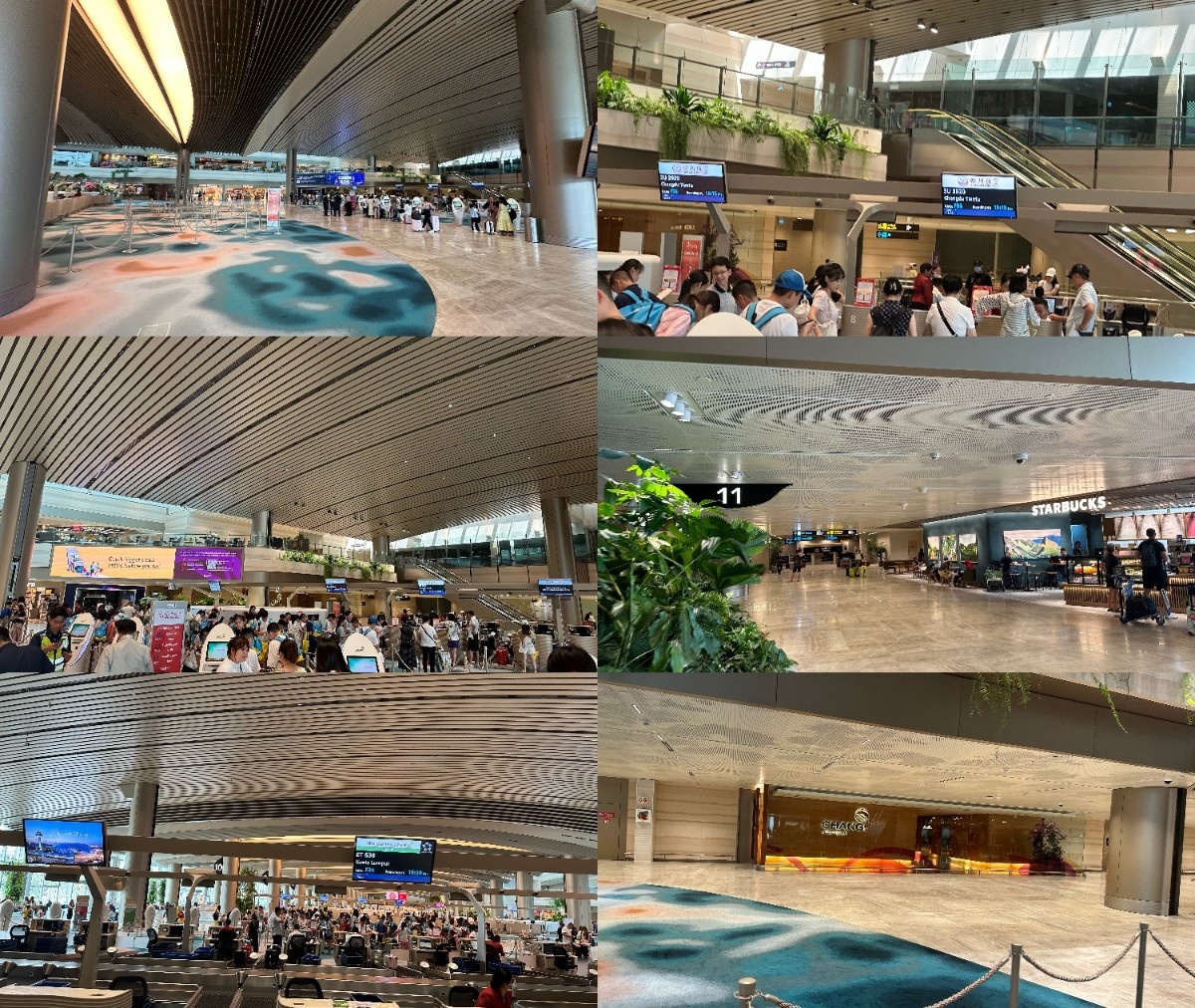
At the very end of the check-in islands was the counter for ET638, and this time around the boarding pass wasn’t the plain white version I’d got in May. Instead it had a cream-coloured background and the image of a smiling flight attendant! On the other side were some rather ungrammatical and, I should say, unfortunate-looking ads for Ethiopia, which do not at all reflect the high professionalism that this airline (and especially its magazine) show otherwise.
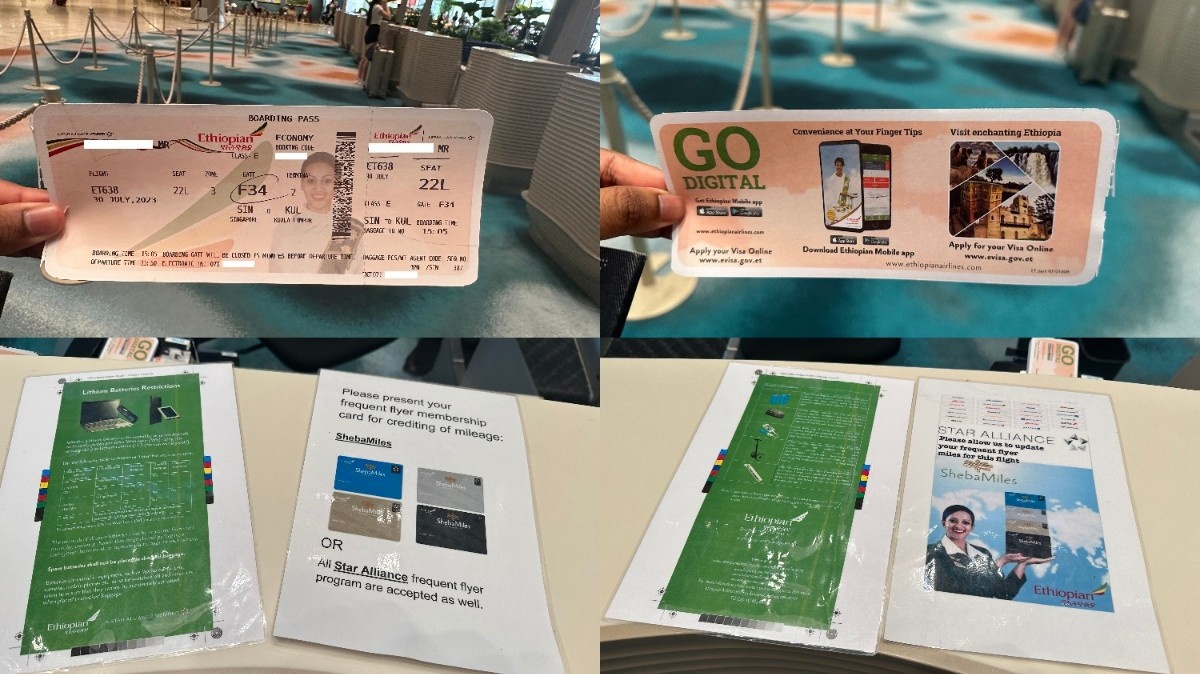
The beauty that is Terminal 2 — now with a Monet exhibition
I should mention that a number of Mainland Chinese airlines were having their check-in now, including China Southern Airlines, Chongqing Airlines and Sichuan Airlines, all of which fly A320neos or A321neos from their bases (CAN, CKG and TFU — formerly CTU — respectively) to Singapore. There was also the hard-to-find Air Macau, which has a daily afternoon flight (NX907/908) on a route that is also served by Scoot — with a very similar flight number (TR904/905) and by the same aircraft, an A320 or A320neo.
The Chinese aside, a number of other airlines had their check-in signages placed in the vicinity: Lufthansa and Swiss; Firefly, Malaysia Airlines’ subsidiary; and Royal Brunei Airlines, to name a few. Firefly also happens to be the only airline operating at Singapore’s second airport, Seletar (XSP) in the north, with its ATR 72s that fly to Kuala Lumpur’s nearer-by but turboprop-only SZB airport.
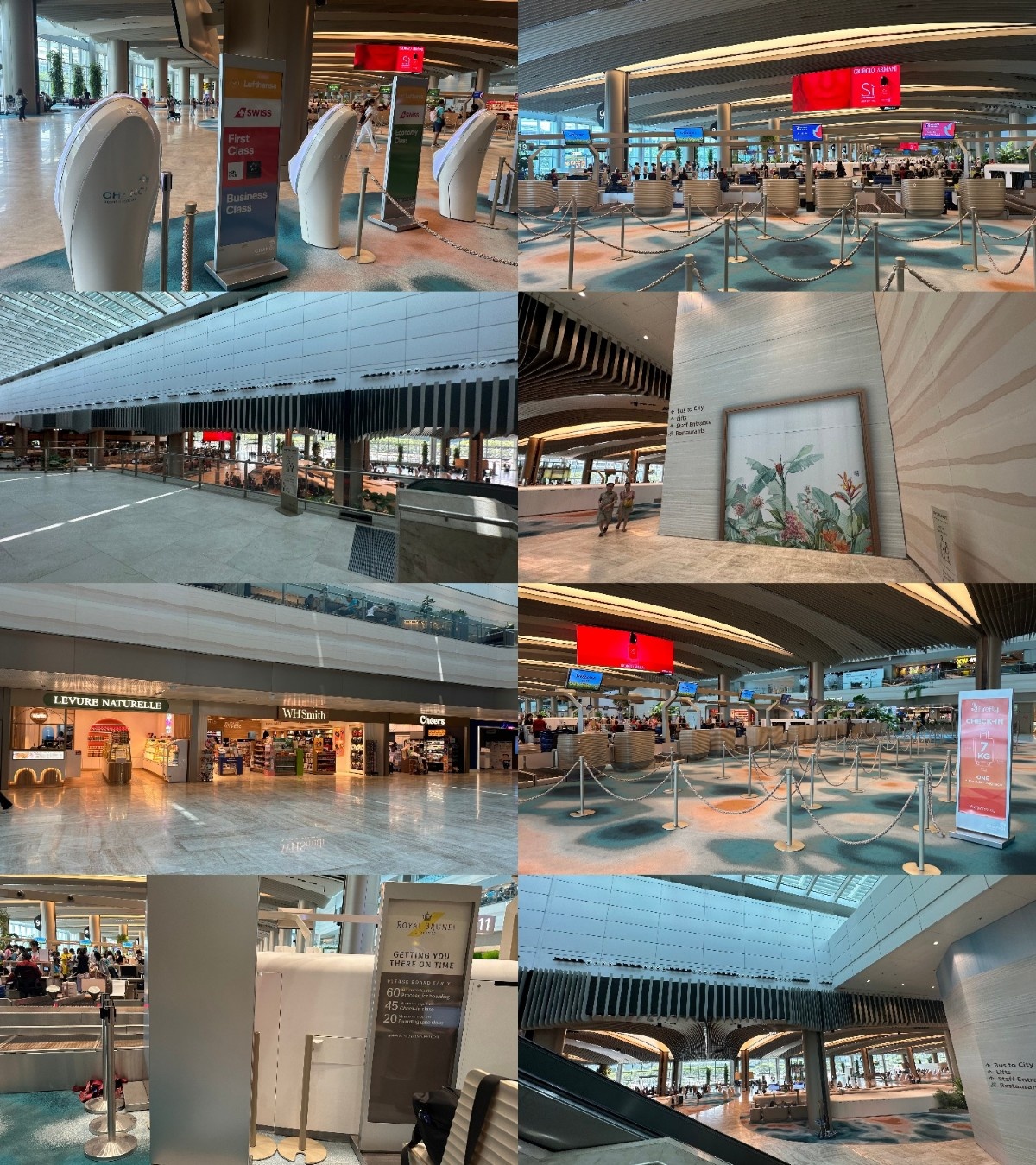
More intriguing was the fact that there was an exhibition entitled ‘Monet: A Journey through Seasons at Changi’ on the floor above, showcasing some of the works of French painter Claude Monet and his depiction of the seasons, brought to life by installations in myriad colours. A splendid treat for art aficionados and ordinary travellers alike! I spent a good fifteen minutes walking through this miniature forest filled with the artists’s sensual creations.
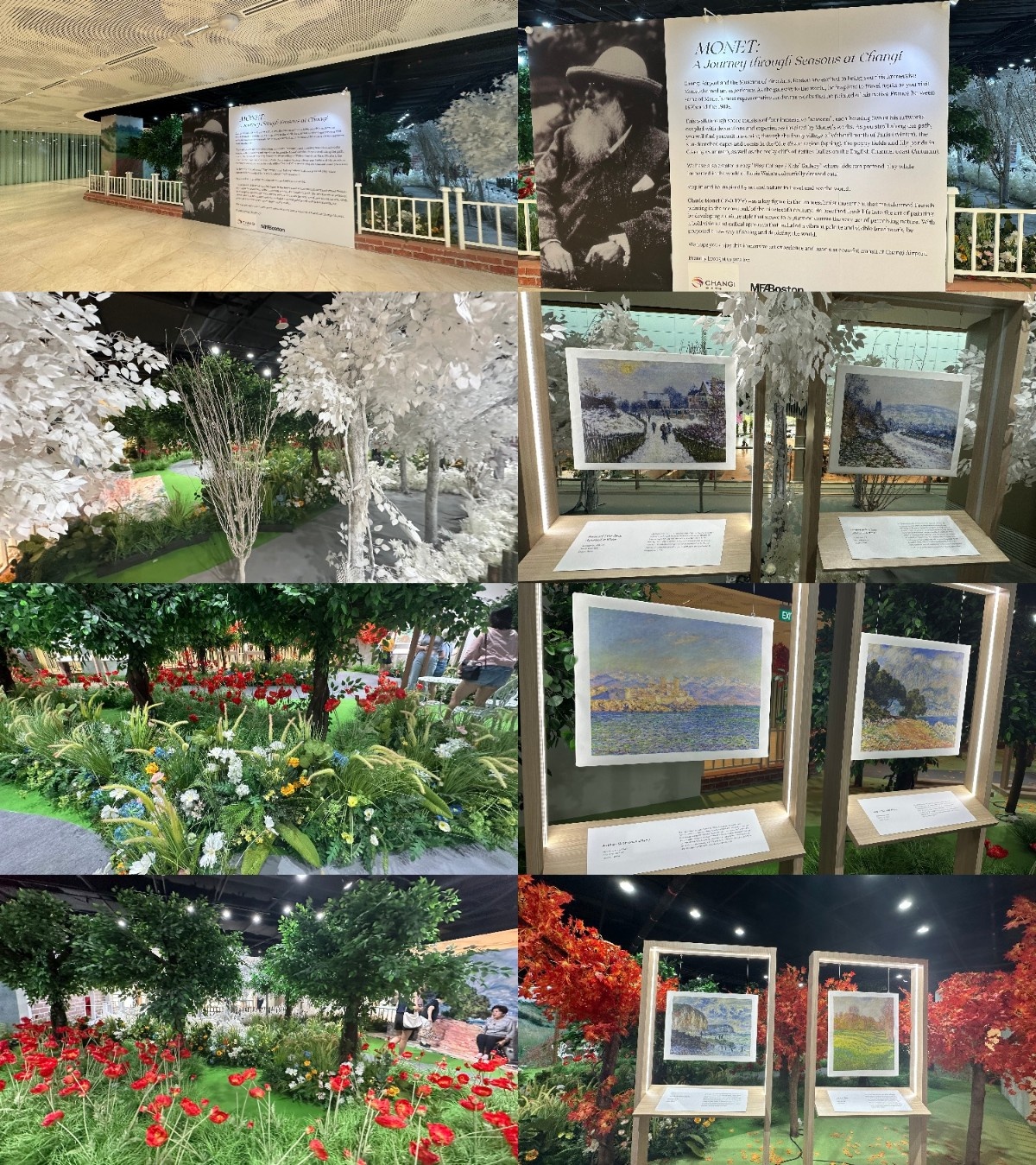
Onwards to the eateries, and these were a few of the most brightly lit ones.
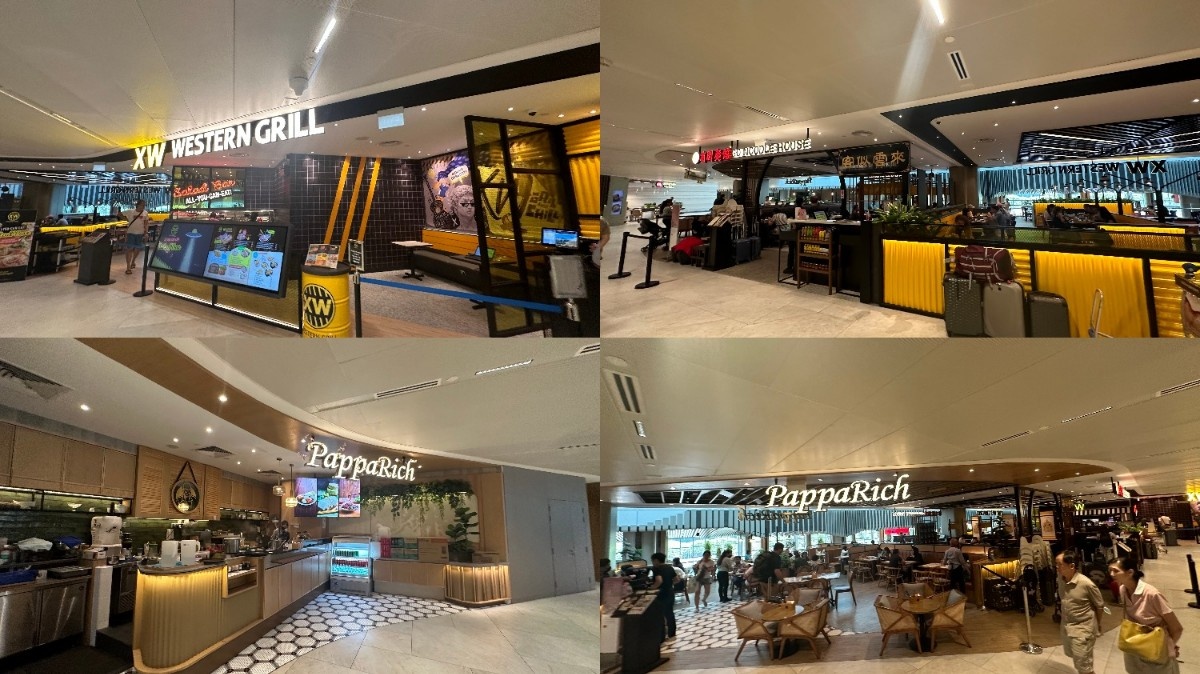
During my pre-COVID semester-break trips in 2018–19 — which were exclusively on IndiGo or Air India A320s between Singapore and Chennai — I would eat at Chutney Mary, a North Indian restaurant, before taking the AI347 morning or 6E52 (now 6E1004) afternoon flight to Chennai.
Given that Terminal 2 was mostly closed for renovation from the pandemic outbreak in 2020 to the end of 2022, this would be the first time I’d eat here — and what a meal it was, a cost-effective one at that: a heavenly butter chicken and naan set. Pure Punjabi bliss!
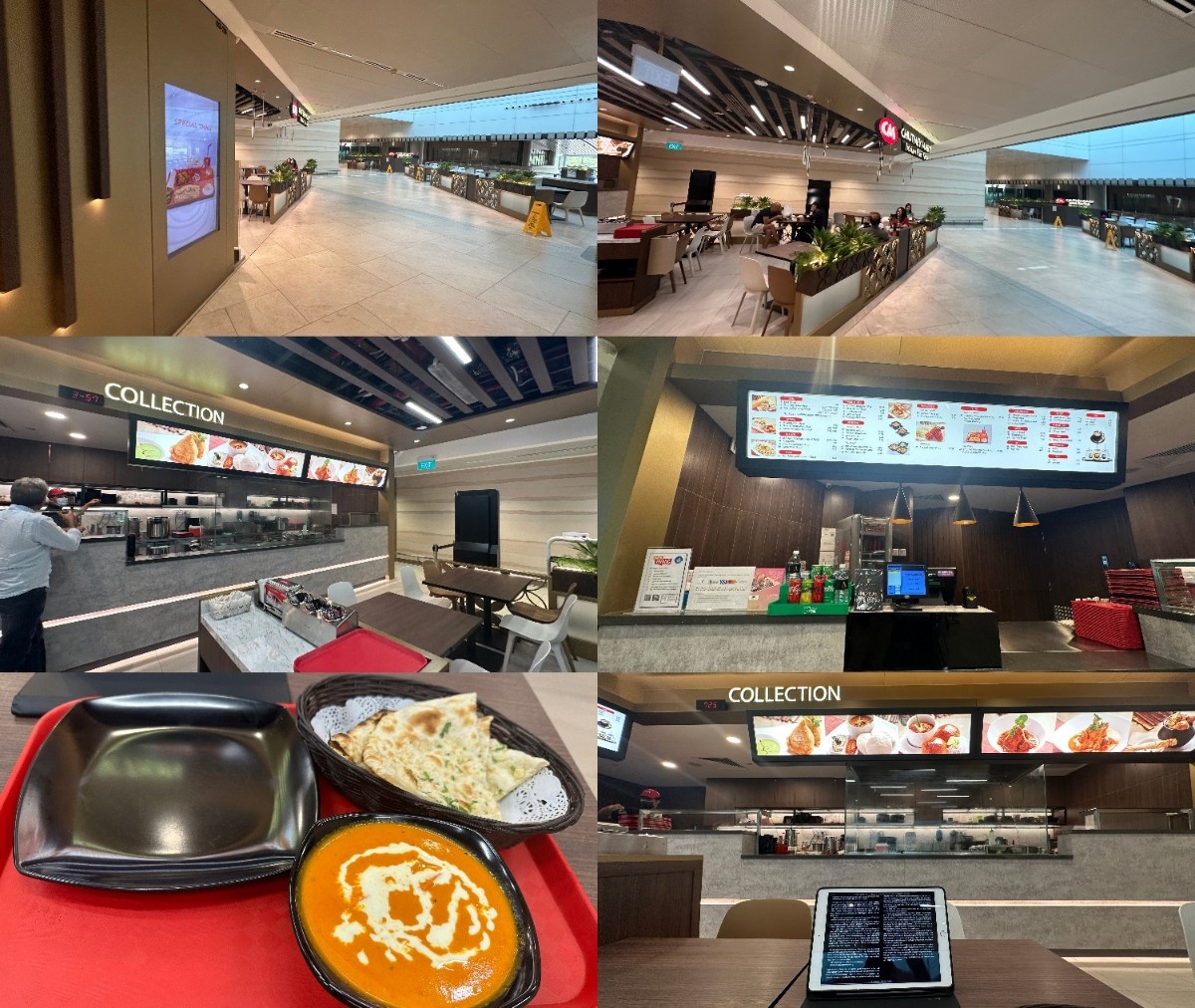
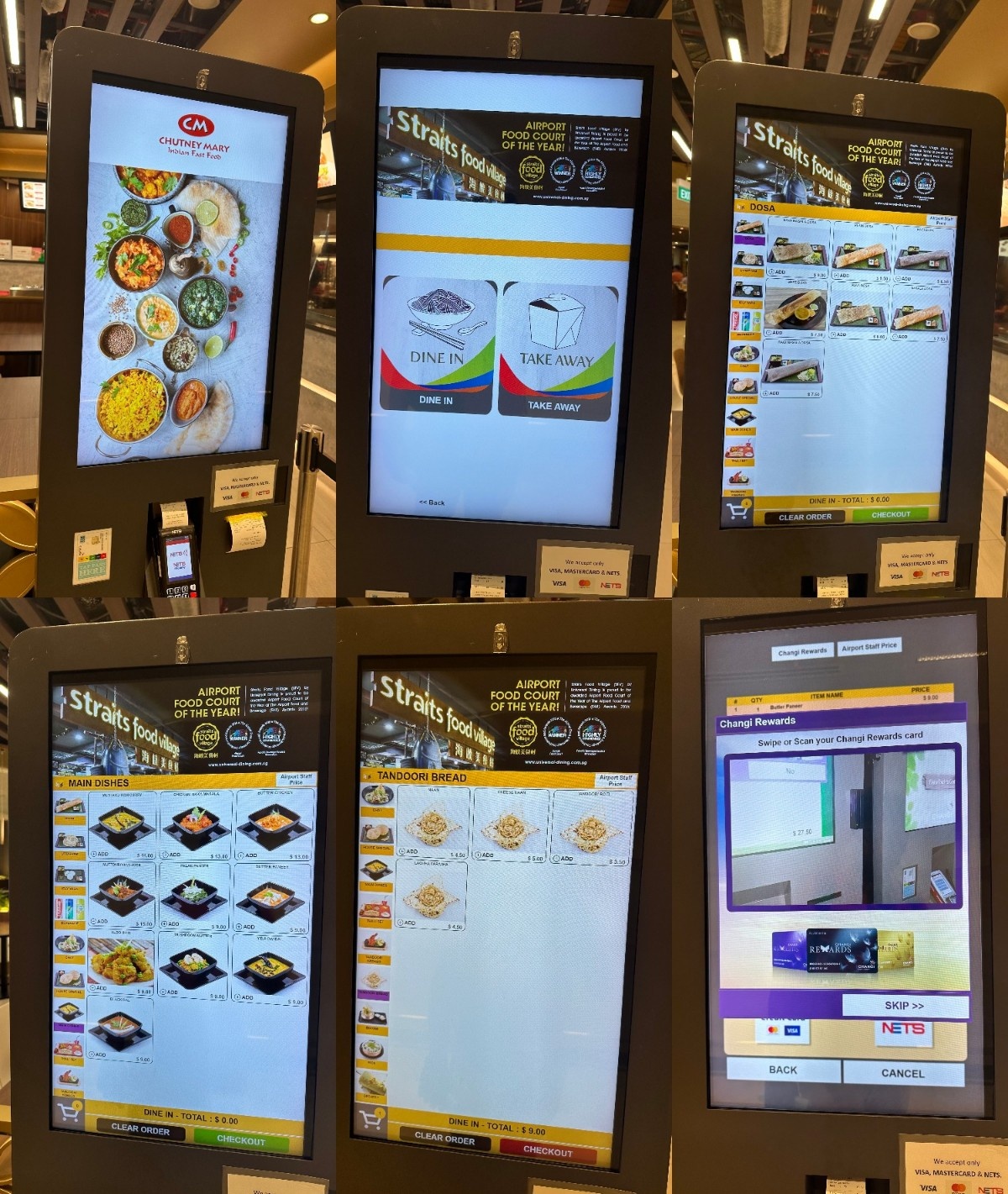
This list was enough proof that most of the non-9V/9M registration prefixes were Chinese (or Macanese) B- prefixes. A China Cargo Airlines 777F (B-222H), a Xiamen 787-9 (B-1567), the aforementioned Air Macau A320neo (B-MBO), an Air China 737-800 (B-5198), a Chongqing Airlines A321neo (B-30E8), a China Southern A321neo (B-1091) and — if I were to consider Taiwan — a Starlux A350 (B-58503) all came from Sinophone territories. By all means avoid this if you’re not a diehard avgeek.
The B-prefixed aircraft aside, some noteworthy ASEAN arrivals were PK-LZV and LZS, two Batik Indonesia 737-800s; RP-C7782, a Philippine Airlines 777-300ER; XY-ALT, a Myanmar Airways International A320; and VN-A226, a Bamboo Airways A320neo from Ho Chi Minh City. (There was also HS-THG, a Thai A350 from Bangkok, and I flew HS-THL on that very route in June 2022.) There were also several interesting cargo aircraft, including N115FE, a FedEx 767F as FX18 from Hong Kong that would continue to Osaka, Japan, and Indianapolis in the US; LX-VCH, a Cargolux 747-8; and B-LDS, an Air Hong Kong (operating for DHL) A330F.
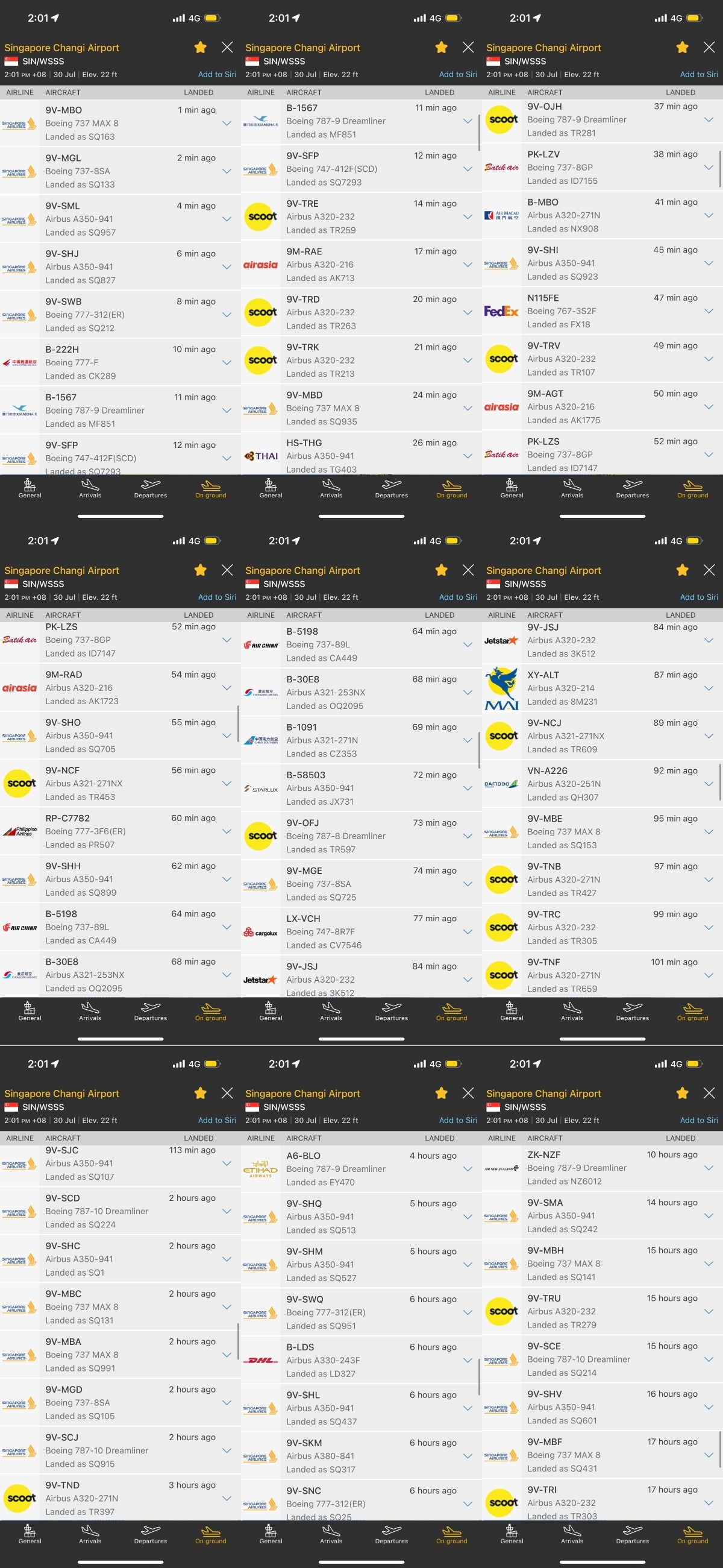
All that aside, I next decided to check out where the ‘Hub & Spoke’ café was located, but though I was unsuccessful in this regard — as I actually had to step outside the building and into a carpark — I still managed to find a most interesting wall decoration there.

And the splendour continues
I went to the Immigration counters, and en route on the escalator I captured some spellbindingly, astonishingly panoramic views of the ornate opulence that is Terminal 2. No wonder then that two of my other favourite terminals of all time — both in India (BOM and BLR) — are also called Terminal 2, but this one is too magnificent for even those.
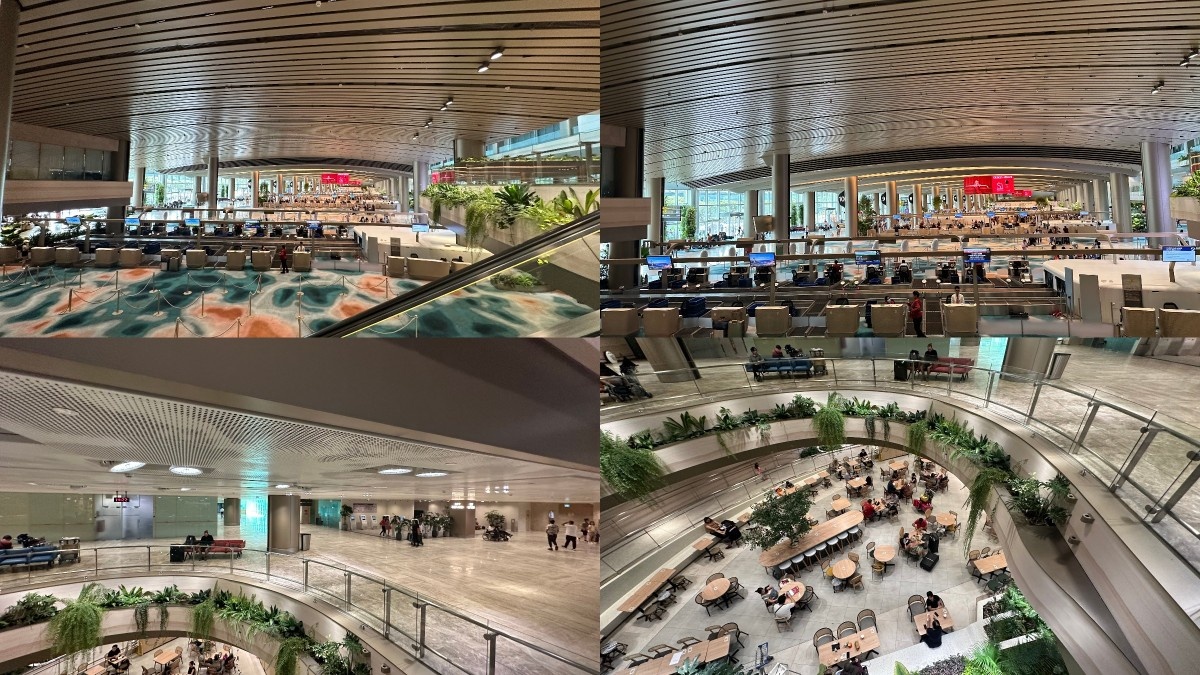
These were some ads near one of the WHSmiths, including a tourism ad for Hong Kong which has been desperately trying to stage a comeback after the pandemic and the 2019 political protests before that.
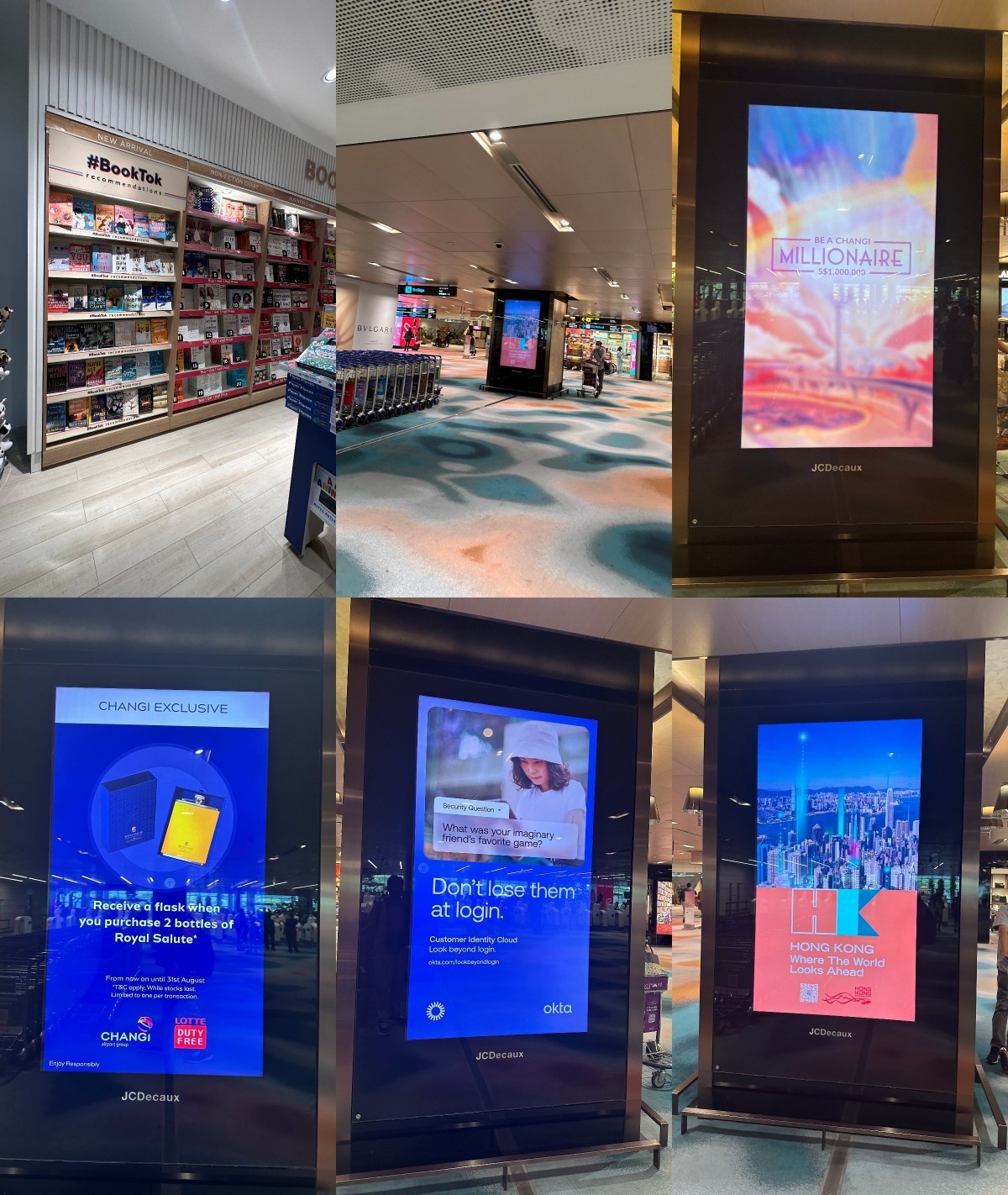
These were some of the departing flights and the electronics and souvenir shops next to them — best looked at from a distance unless you want to overpay by tens to hundreds of dollars compared to the retail price.
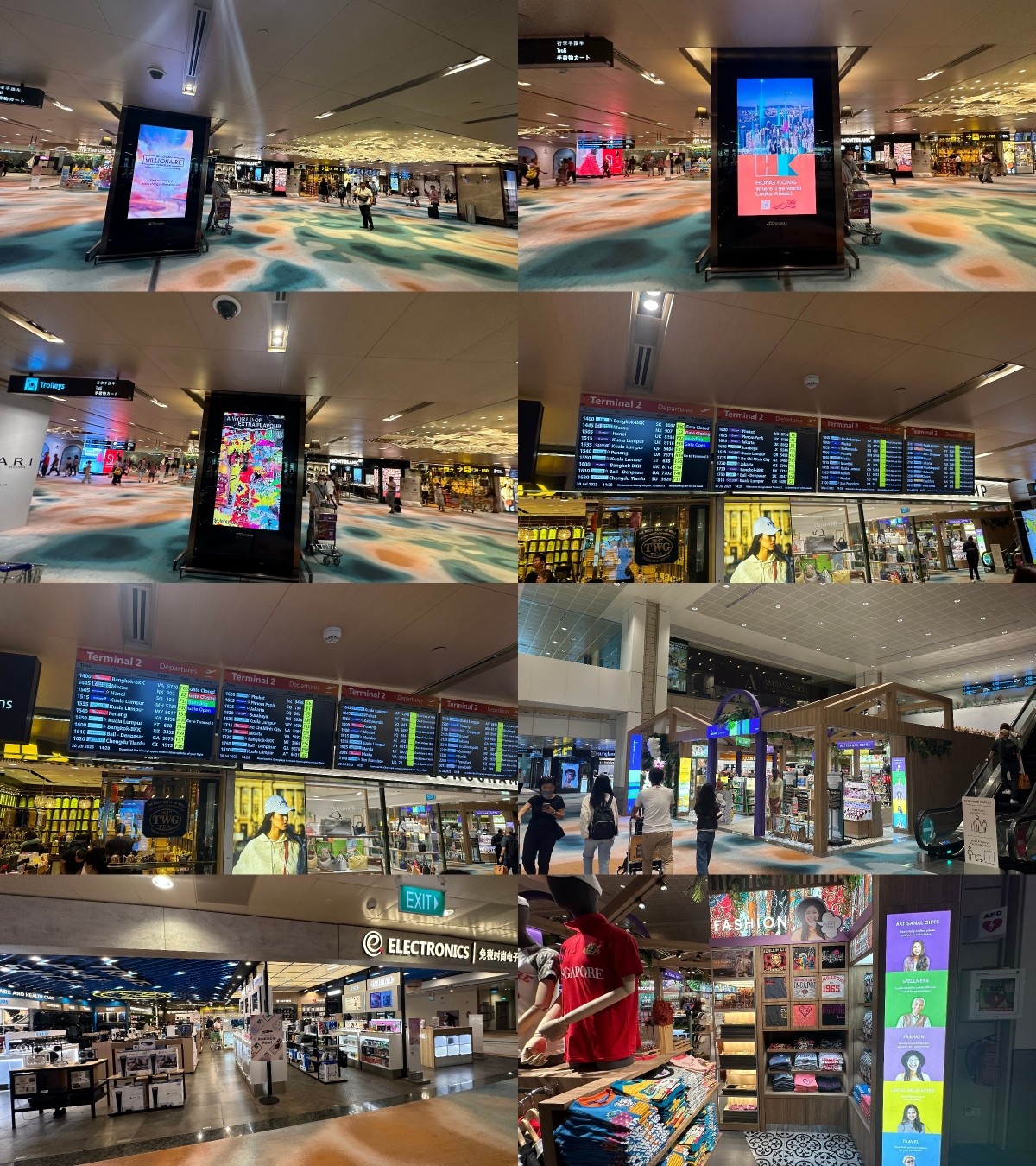
Some more shops included Gassan, a jeweller-cum-horologist from Amsterdam, all of whose outlets outside the Netherlands are here at Changi! Nearby, SQ186 to Ho Chi Minh City and SQ116 to Kuala Lumpur — the former on the A350 Regional, the latter on the 737 MAX — were nearing departure.
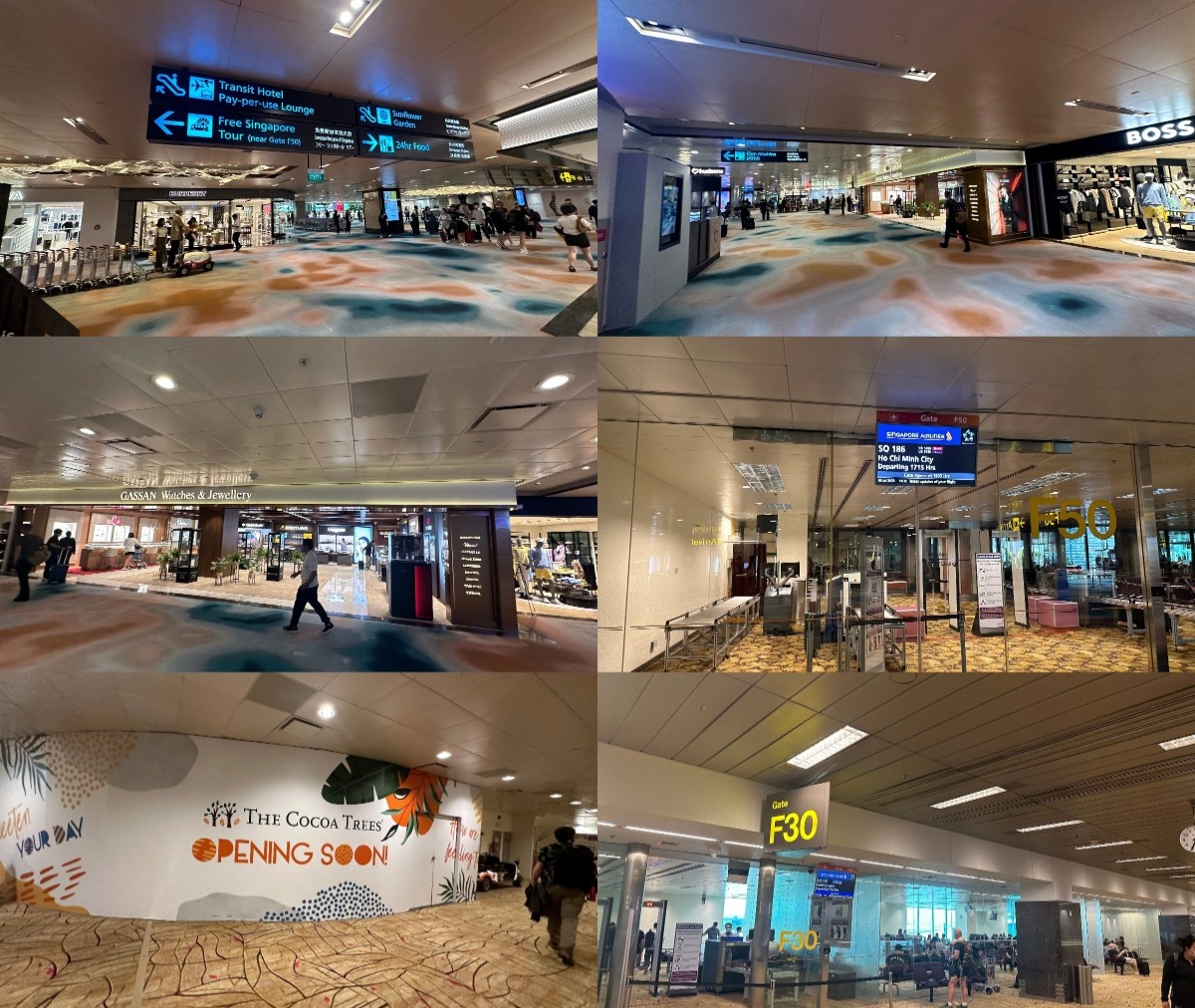
Approaching the deprture gates, I managed to catch a view of B-MBO, the Air Macau A320neo, before reaching my own gate.
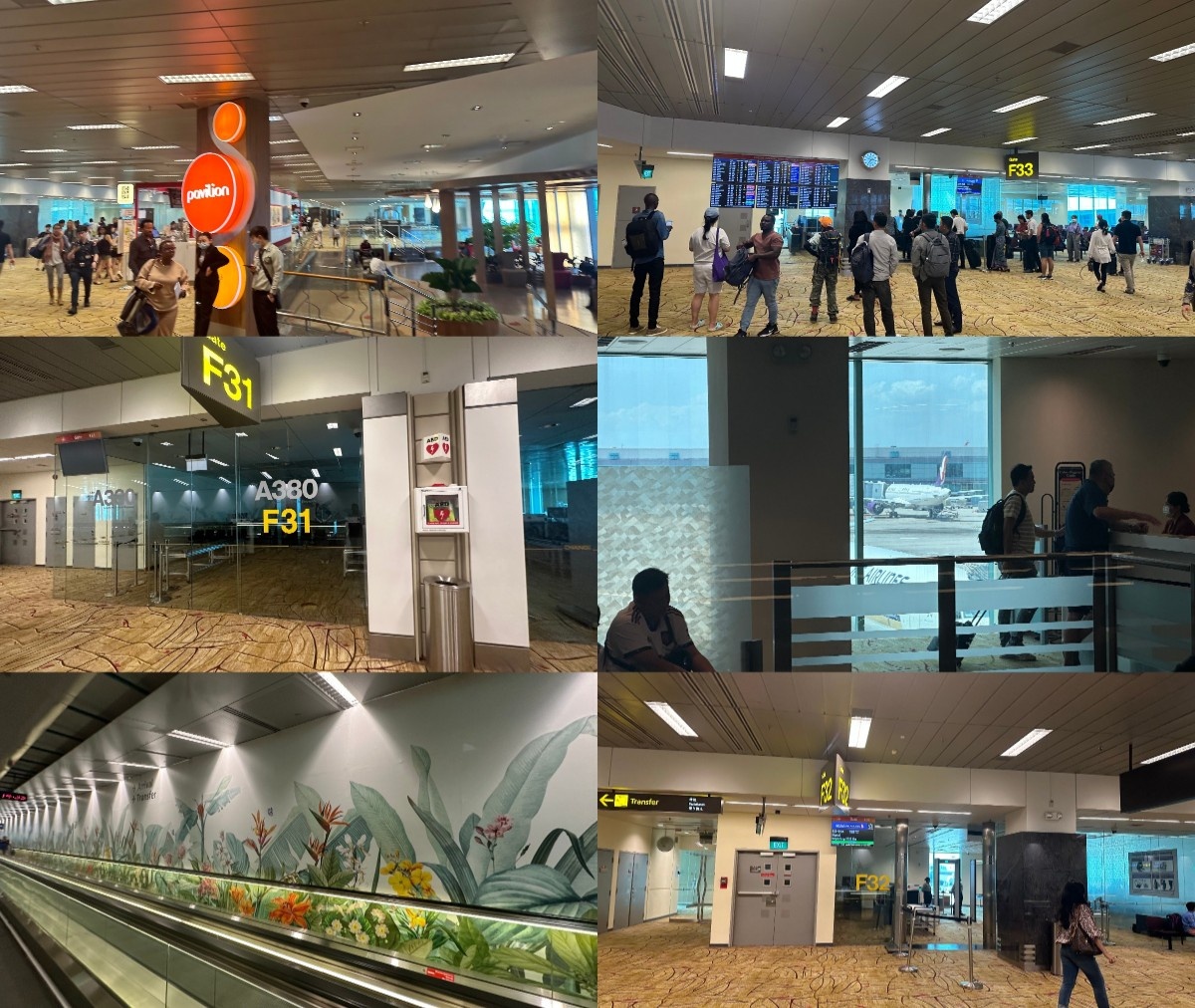
Yet more Chinese arrivals popped up: B-5706, a Xiamen 737-800 — in addition to the 787-9 earlier — and B-324C, a Juneyao A321neo. This really was peak hour for flights to the People’s Republic. Other Mainland Chinese airlines flying to Singapore include Hebei Airlines, Shenzhen Airlines (Star Alliance member) and Chengdu Airlines — none of whose names I bet you’ve ever heard. The early check-in facility in Terminal 1 is dedicated to six such Mainland Chinese airlines, including Star Alliance ‘mother and daughter’ Air China and Shenzhen.
It was only fitting, then, that my own Ethiopian 787-9 (ET-AUO) be named after the Chinese capital. There were also PK-GNM, a Garuda 737-800, and B-16713, an EVA Air 777-300ER, among the recent arrivees, as well as PK-LZQ — a third Batik Indonesia 737-800 in quick succession — and S2-AHO, a Biman Bangladesh 737-800, a rare non-ASEAN/Northeast Asian arrival.
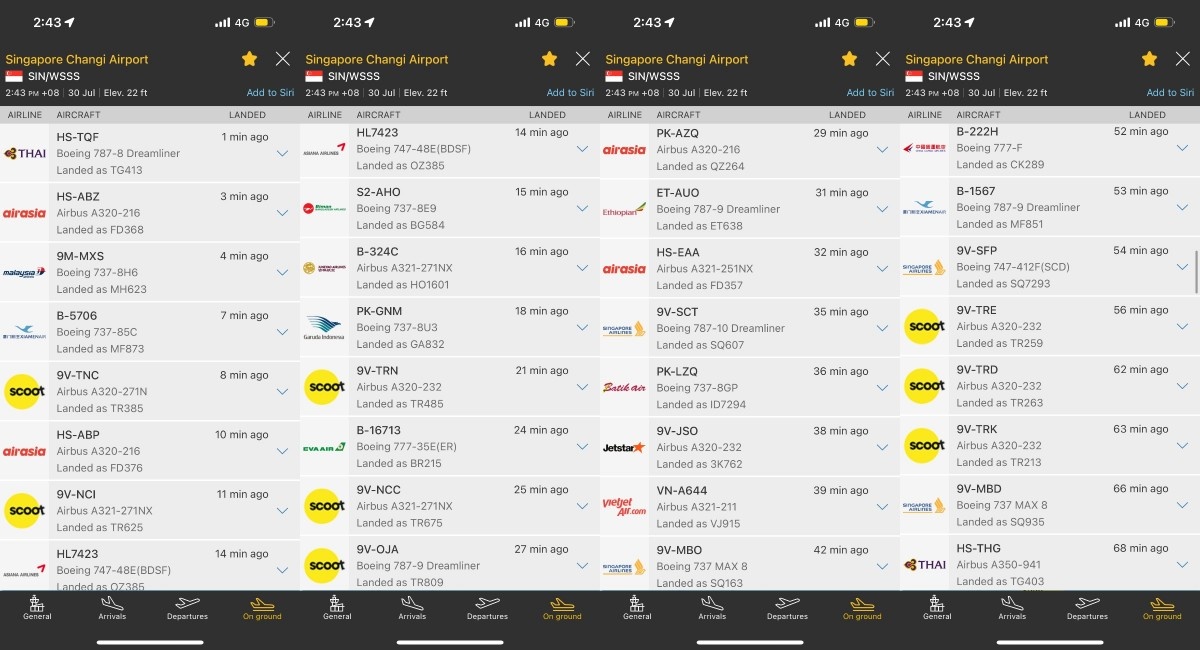
Anyway, enough with Chinese airlines: here instead was the striking beauty of an aircraft named after the Chinese capital, but one that never flies there, for PEK — and PVG (Shanghai) — are Ethiopian’s only two Asian destinations that receive the A350 instead of Boeing aircraft.
Ethiopian’s twenty A350s typically fly to Europe and North and South America (as do the 787s) — but the Airbuses do not serve Asia outside those two Chinese cities; here the 787s are the most common aircraft, in addition to the 737 MAX for closer-by destinations like Bengaluru and Chennai in southern India. ET also has four 777-300ERs (ET-APX/APY and ET-ASK/ASL) and six 777-200LRs (ET-ANN/ANO/ANP/ANQ/ANR and ET-AQL) in its passenger widebody fleet.
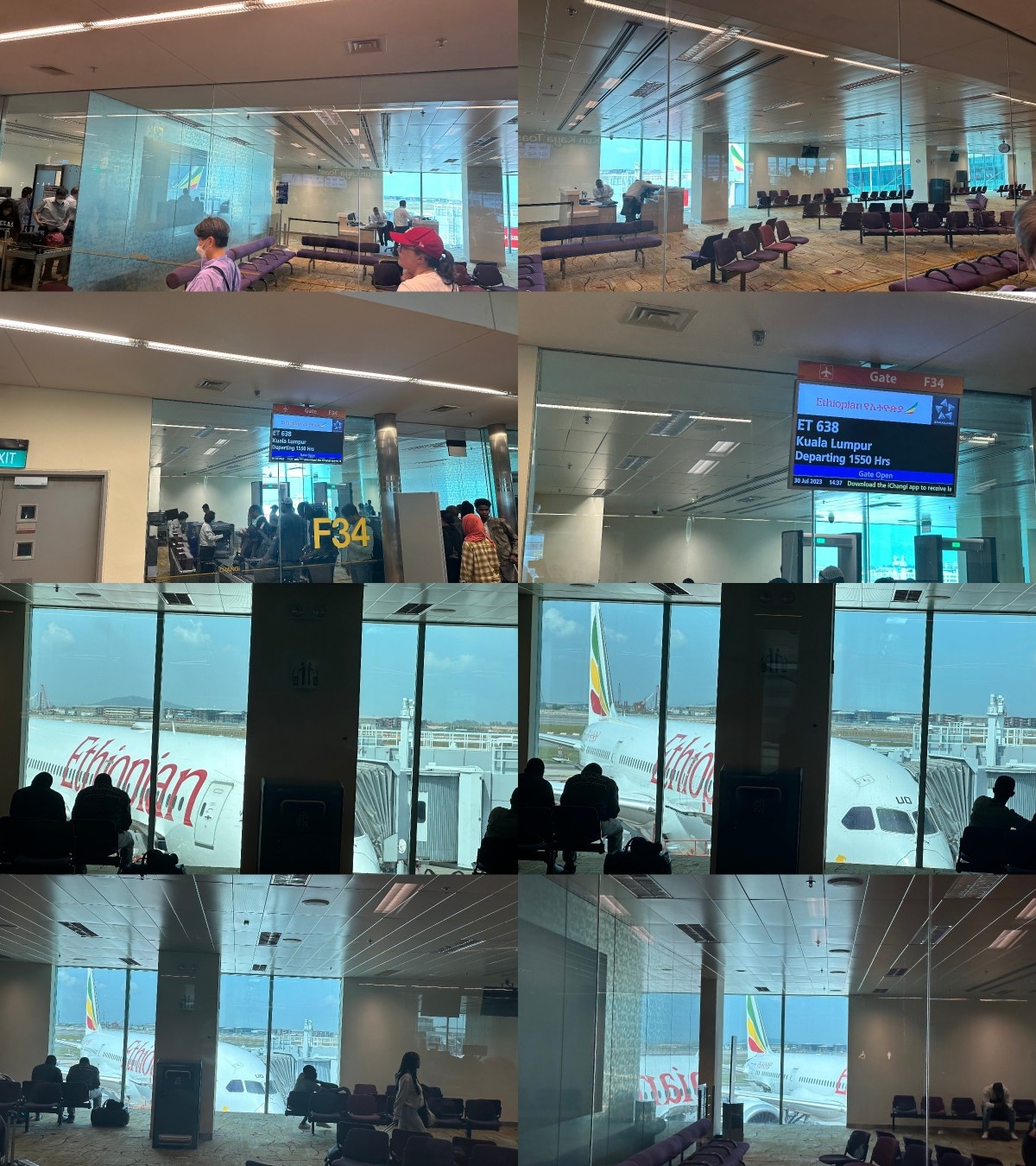
Text your health and happiness updates, texted my mother, and ordinarily I would have done so, filling in all the details of the flight. Today, however, was an exception as I kept mum about the whole mini-trip, not breathing a word!

It is difficult to beat or even match Terminal 2’s brilliance, but ET-AUO gave her best shot at it, and the Boeing looked every bit a stunner from whichever angle you chose to see her.
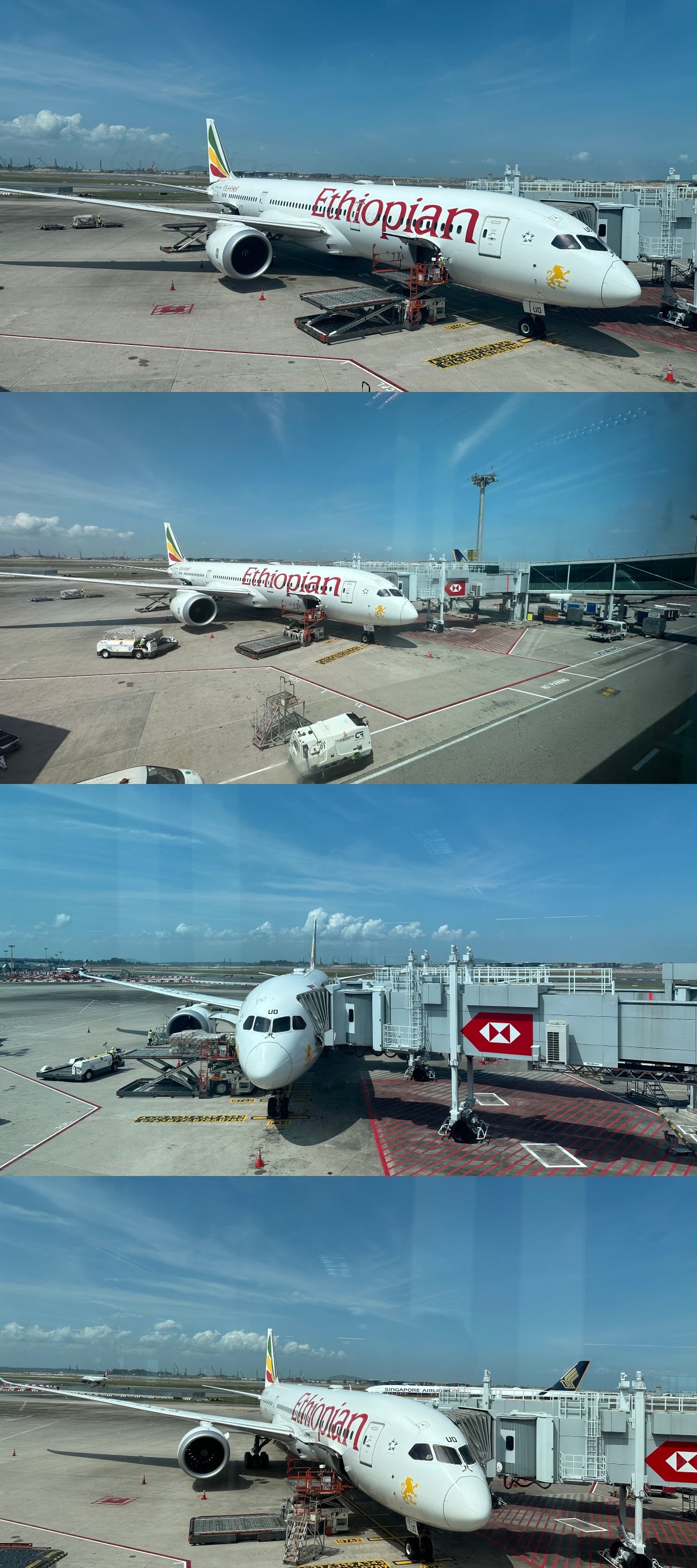
Some more planes passed behind: B-MBO as NX908 to Macau followed by A350-900 9V-SHA as SQ186 to Ho Chi Minh City.
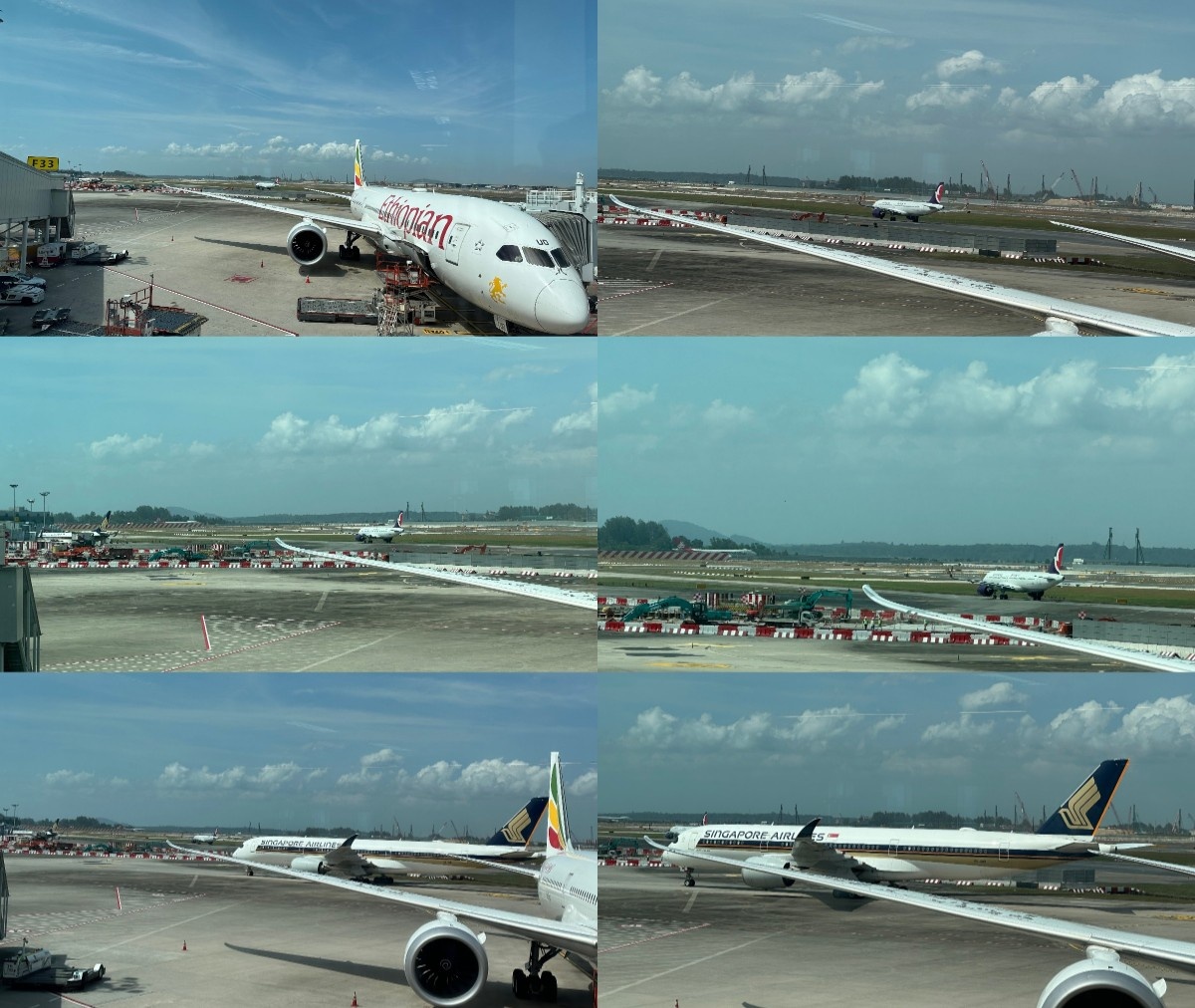
Some more arrivals and departures within East Asia, ranging from heavyweights (pun intended — especially for that Cargolux 747) like Bangkok, Hong Kong and Tokyo to smaller ones like Hanoi, Yangon and Phuket.
You will notice here that a few Air Macau A320/1s are actually flying for Air China, from its Chengdu–Tianfu (TFU) base; this has been the case since 2021.

Yet more narrowbodies passed by: 737-800 9V-MGM as SQ727 to Phuket — mercifully replaced by the 737 MAX on HKT routes in the winter season — followed by two A321s, VietJetAir’s non-neo VN-A644 as VJ916 to Hanoi and Thai AirAsia’s neo HS-EAA as FD356 to Bangkok–Don Mueang. All along, the relatively whiter Dreamliner continued to command the scene with her majestic presence.
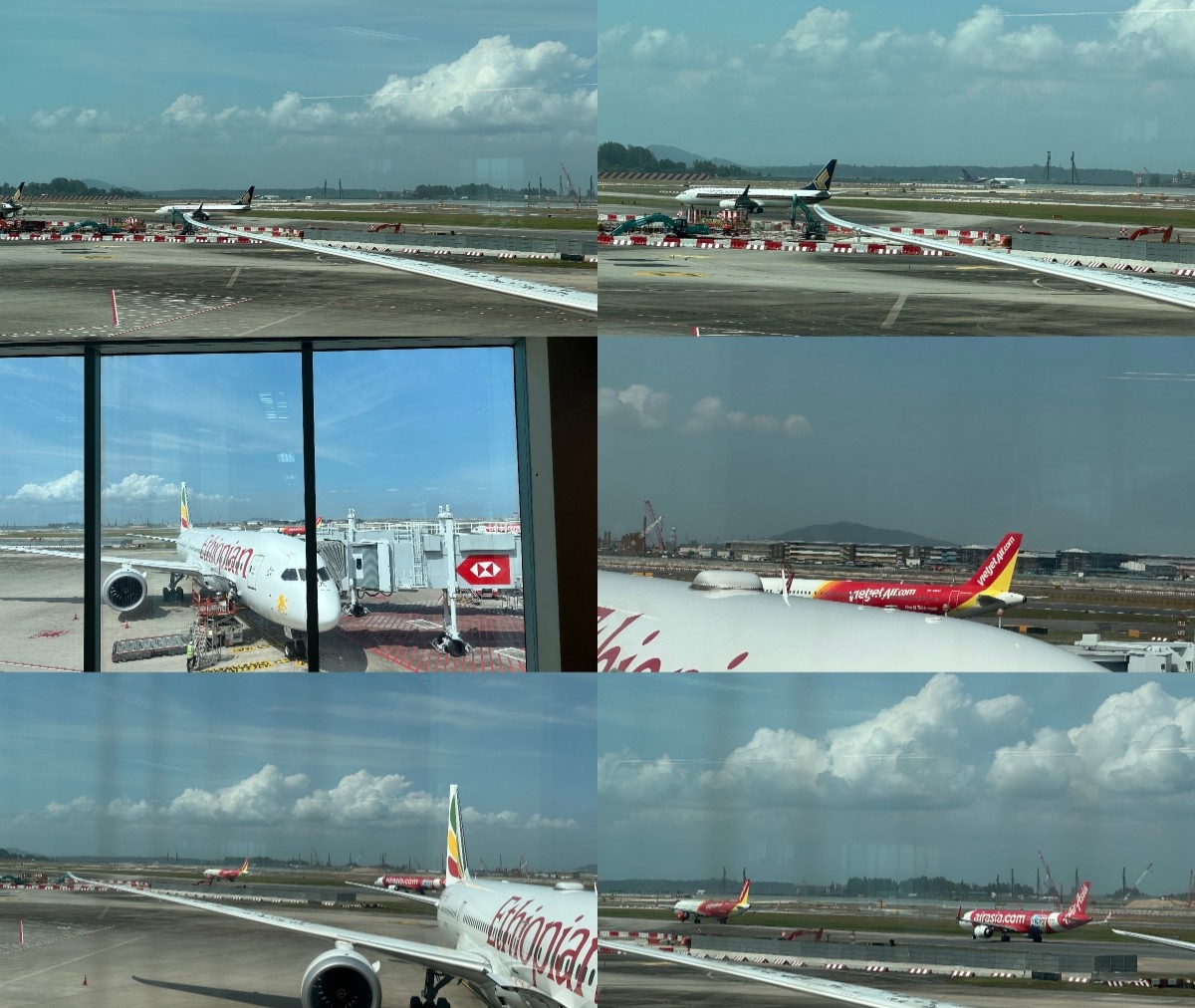
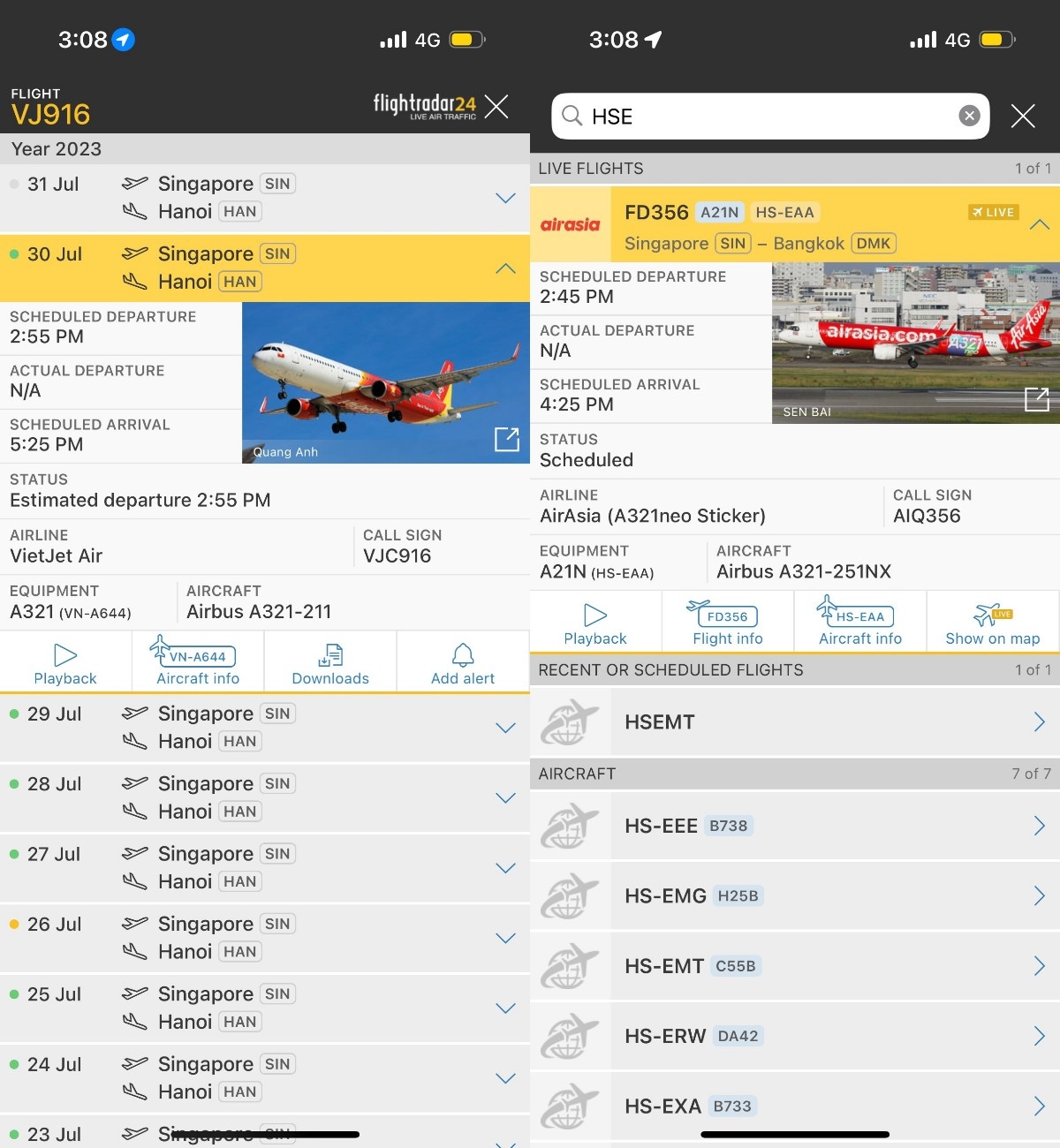
I took a picture of what I’d written on my iPad when publishing my Thai Airways 787-9 review in July 2023, teasing this very Ethiopian 787-9 flight. Indeed, this was my second time on the 787-9 — and I’d only ever flown the Dreamliner on Star Alliance members (AI, SQ, TG and ET) until November, when I flew the non-aligned Bahraini flag carrier Gulf Air’s 787-9 A9C-FC, as GF166 from Bangkok to Singapore.
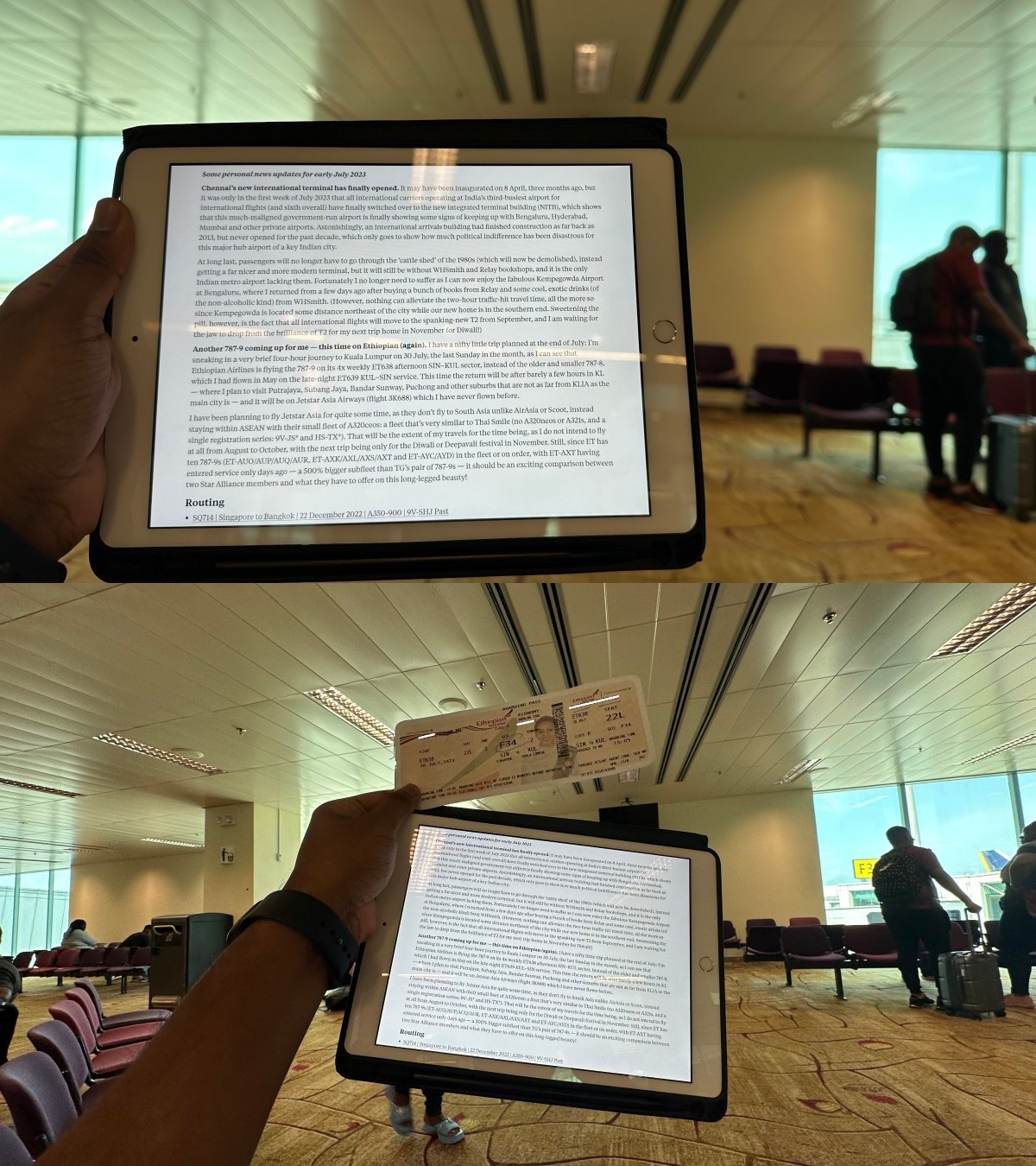
Before long I was on board, past the inspirational HSBC advertising, in the middle of a glorious summer afternoon — though of course not as momentous and tremendous an occasion as stepping on the SkyTeam-liveried KLM 777 nearly two months before; it will be very hard to top that!

The flight: Boarding and Selamta magazine
Flight: Ethiopian Airlines ET638/ETH638
Date: Sunday, 30 July 2023
Route: Singapore Changi (WSSS/SIN) to Kuala Lumpur International (WMKK/KUL)
Aircraft: ET-AUO, Boeing 787-9 Dreamliner, named Beijing
Age: 5 years 9 months at the time (built: 13 October 2017, delivered: 26 October 2017)
Seat: 22L (starboard side, window)
Boarding: 3:15pm SGT/MST (GMT +8)
Departure: 3:55pm SGT/MST (GMT +8)
Arrival: 5:00pm SGT/MST (GMT +8)
Duration: 1 hour 5 minutes
Notes:
• Second flight on Ethiopian Airlines, after ET639 on ET-AOV (787-8) in May, and on the Boeing 787-9, after Thai Airways’ TG337 on HS-TWB in December 2022. In fact, both HS-TWB and ET-AUO were built and delivered in the same month — October 2017 — but while ET has taken delivery of nine more 787-9s since, HS-TWB remains TG’s second and last 787-9 unless it places an order for more.
• Seventh flight overall on the 787, including flights on two other Star Alliance airlines, Air India (two 787-8s, VT-ANX/ANO) and Singapore Airlines (two 787-10s, 9V-SCD/SCL). The first non-Star Alliance 787 came in November 2023: non-alliance airline Gulf Air’s A9C-FC (third 787-9 overall) as GF166 from Bangkok to Singapore, continuing on to Bahrain. The A350, too, has been flown only on two Star airlines so far — SQ and TG — with the first A350s on other airlines coming in the end of 2023: Cathay Pacific (Oneworld) and Vietnam Airlines (SkyTeam).
The seat fabrics here were the same as on the 787-8: the seats were a yellowish-green shade, while the pillows were a bright light green. However, by all accounts this was a superior aircraft to the 787-8 in terms of the IFE and other amenities, with the sleek black screen (though with big bezels) and no remote below the screen — but there was one in the armrest, as posted further below.
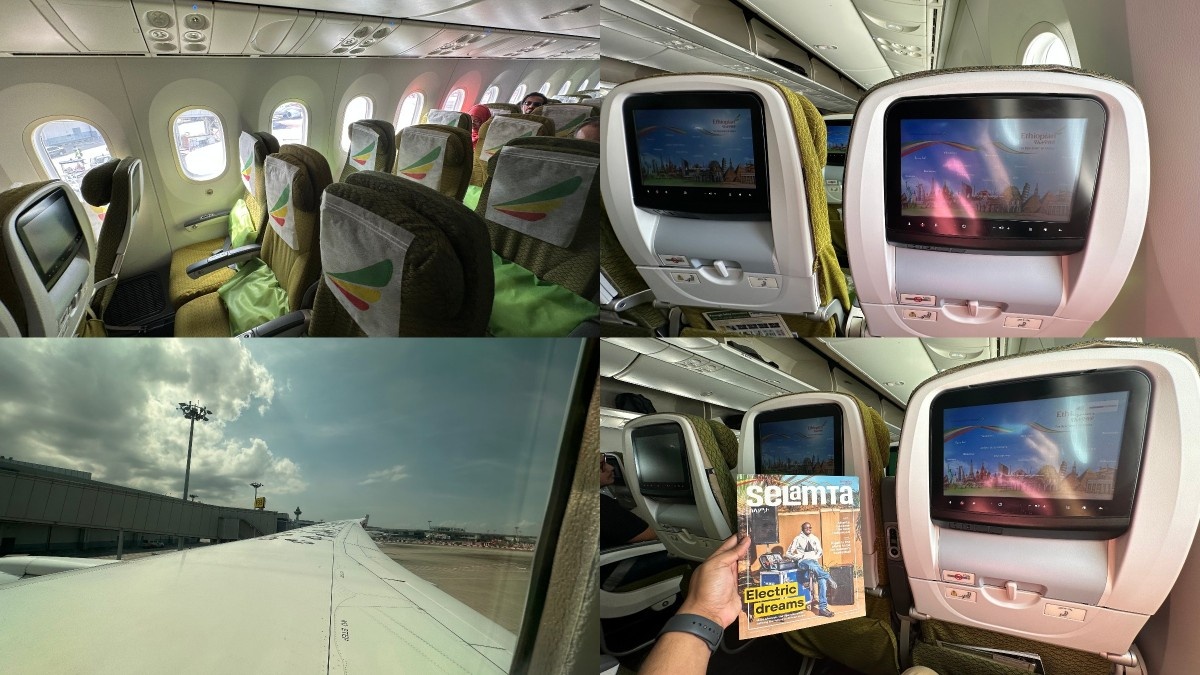
Unlike East Asia and the Gulf, African airlines have mercifully not ordered the mass murder of their inflight magazines, and so I gleefully held another copy of Selamta in my hands. This is one of the best, most colourful guides you can have to the continent and beyond, with Kenya Airways’ Msafiri being another outstanding specimen — but Africa’s only SkyTeam member has one-fifth the size of ET’s fleet (around 30 as compared to 150+) and continues to bleed.
What you will definitely find on airlines that have slaughtered their inflight magazines — like Singapore Airlines — is the duty-free catalogue, and ET has the Sheba duty-free guide as well, for those who would like to part with their hard-earned money.

The CEO’s welcome was as crystal-clear a proof as any of the advances ET has made with respect to being the continent’s best airline, in terms of not only its fleet and route network but also the massive Ethiopian Skylight Hotel, Africa’s largest hotel and one of its most luxurious. No wonder it’s been sweeping awards left and right, from Skytrax and otherwise.
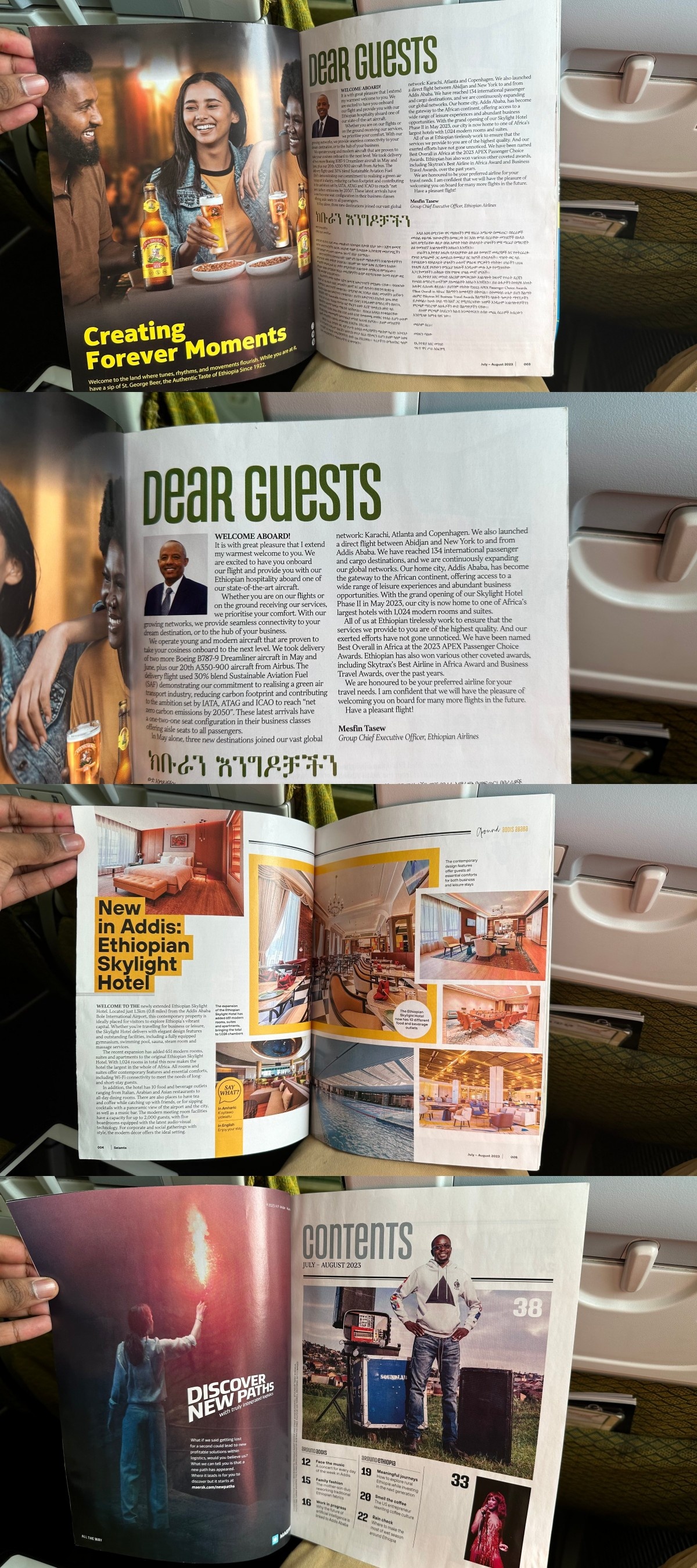
Some of the article topics included women’s basketball in Rwanda and the filmmaking industry in Atlanta. As diverse as it gets!
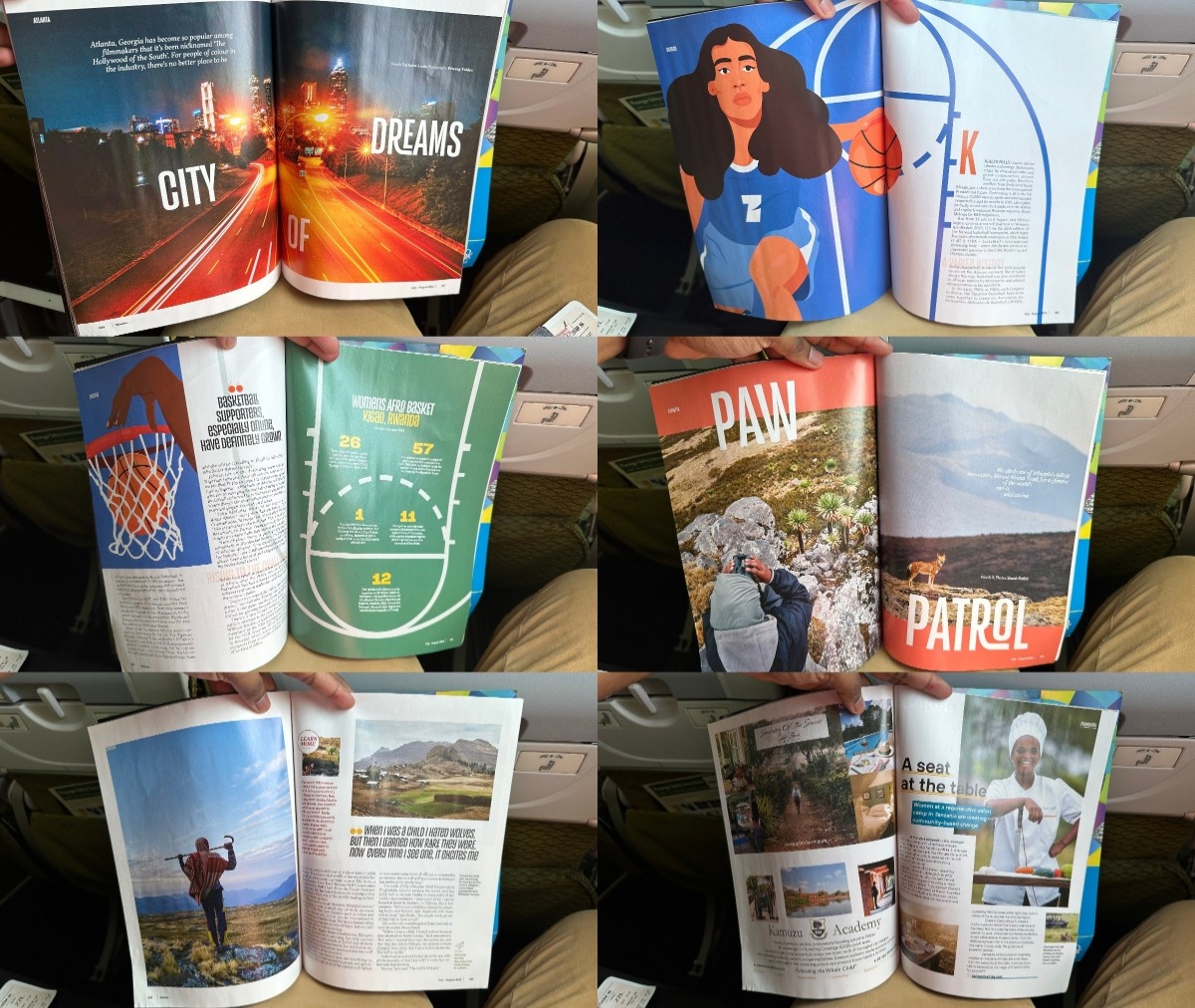
The fleet had now swelled to 149, as against 144 in the previous (May–June) issue, with the additions of two 787-9s (ET-AXT and AYD), an A350-900 (ET-AZN) and two 737-800s for its Togolese subsidiary Asky (ET-AZY and AZZ). More new aircraft have been delivered to both ET and Asky in the new ET-B** registration series, including 737 MAXes ET-BAL and BAN (Ethiopian) and ET-BAQ and BAR (Asky), and a new freighter 777, ET-BAA.
In terms of routes, ET had recently launched Copenhagen, Denmark; Atlanta, United States (whose film feature was mentioned above); and Karachi, Pakistan, in addition to a direct route from Abidjan (ABJ), Côte d’Ivoire — continuing from Addis Ababa — to New York City. Given that you can’t fly nonstop from ADD to the US due to the high altitude of Bole Airport, Lomé (LFW) in Togo has been the airline’s preferred West African gateway (in addition to being Asky’s hub) but ABJ is a new addition for its transatlantic flights.
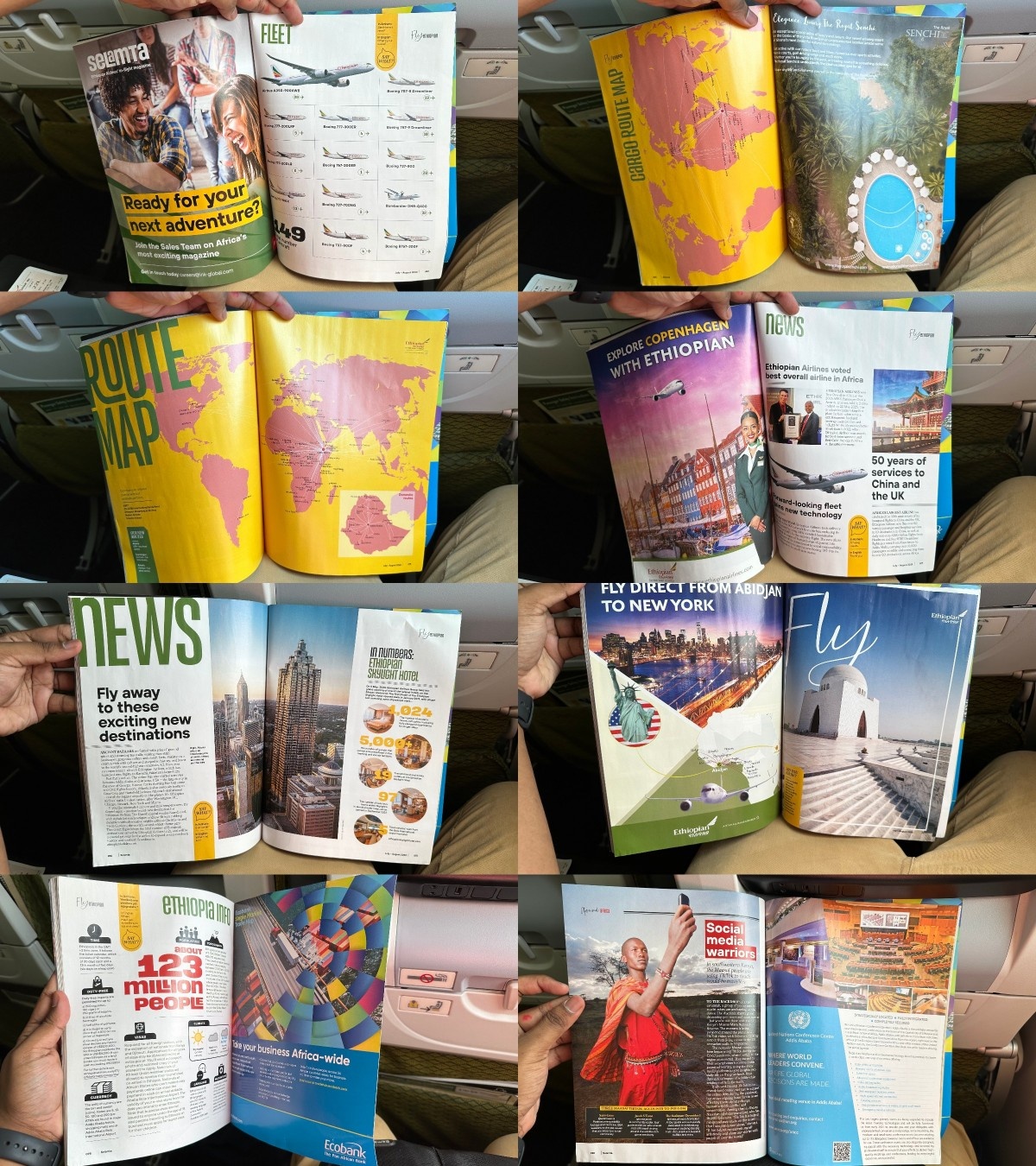
Before I bore you further with the magazine, these were some of the featured article snippets for the month that go to show how well-presented it is.

Chinese and other visitors during departure
At a quarter to four, ET’s safety video played: a rather safe and humdrum one without any exotic themes, but of note is the fact that it features this very aircraft, ET-AUO.
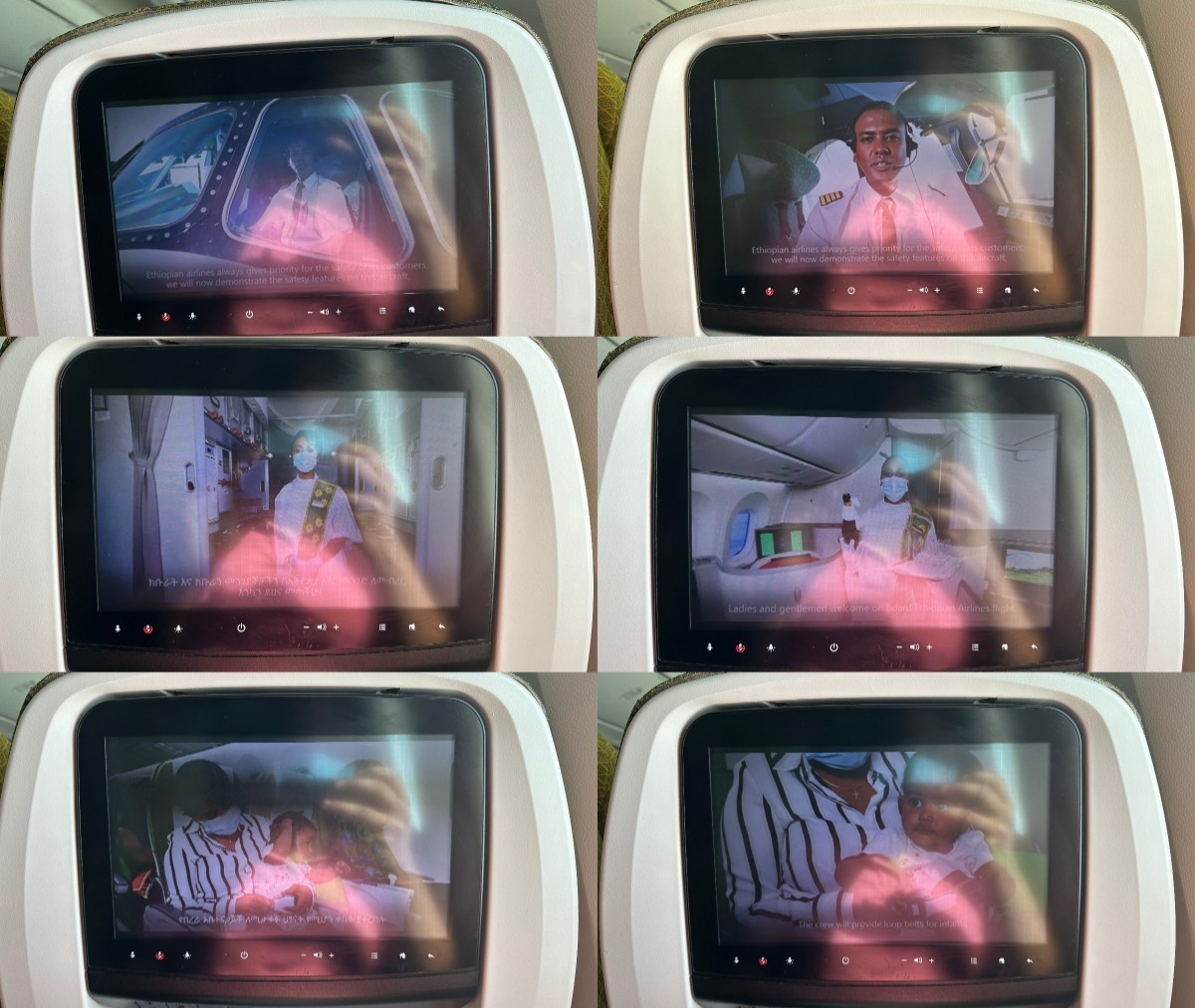
Children and adults alike were consistently seen wearing masks, except for one occasion when a flight attendant removed hers and showed those sparkling whites of hers.

At the end, ET-AUO took to the skies — no, I’m sorry, that was replaced by A350 ET-ATY — followed by a number of computer-generated people bringing out placards with the words ‘Have a pleasant flight’ in English, Amharic and presumably other languages, which in turn morphed into the logo of ‘Ethiopian Airlines, The New Spirit of Africa, a Star Alliance Member’.
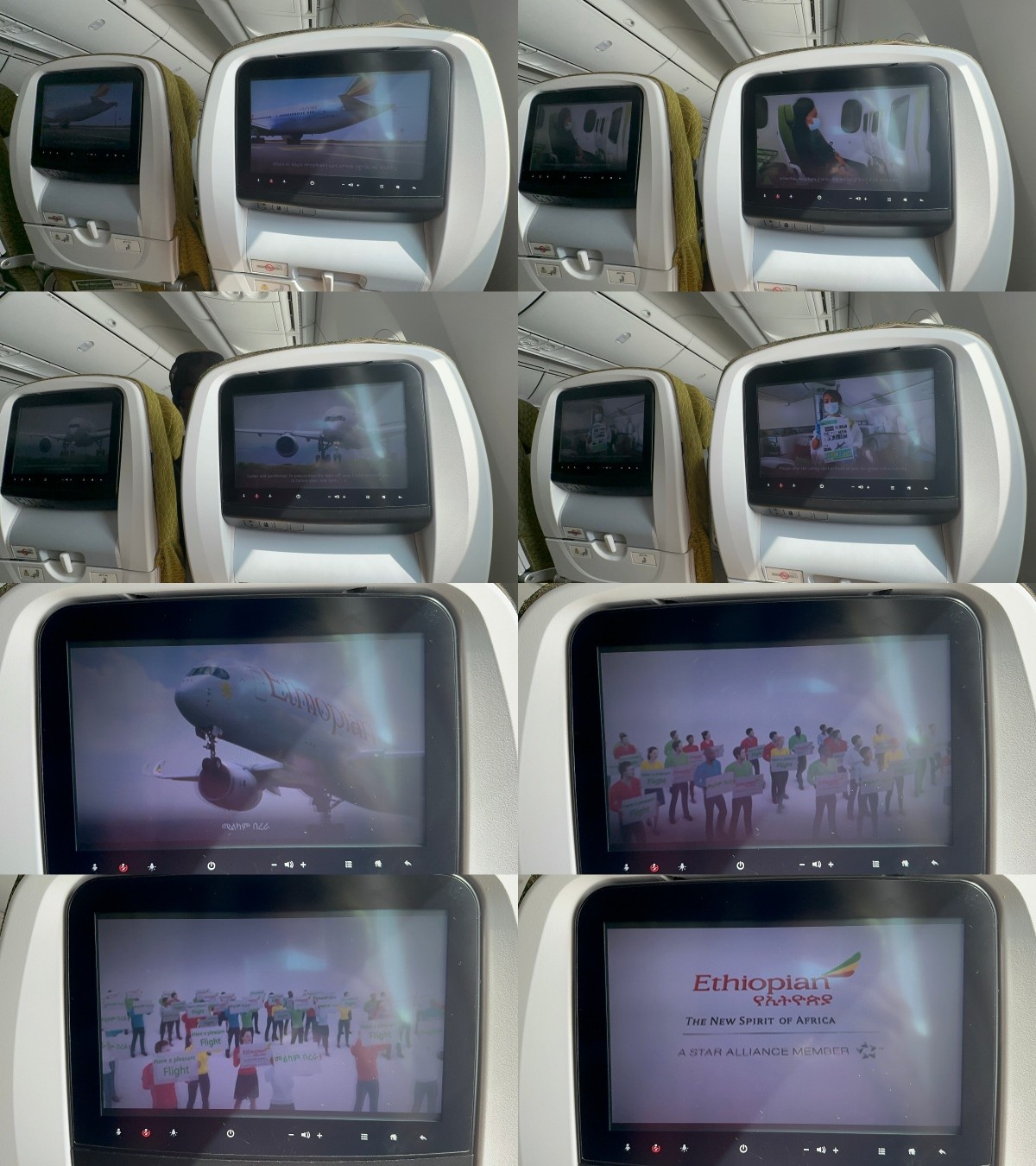
As I took a look at the remote in the armrest, yet another Chinese A321neo appeared: B-300D of Sichuan Airlines, which arrived from Chengdu–Tianfu (TFU) as 3U3909. Meanwhile, an hour after B-MBO departed for Macau, the SQ 737 MAX with the same last three letters — 9V-MBO — showed herself.
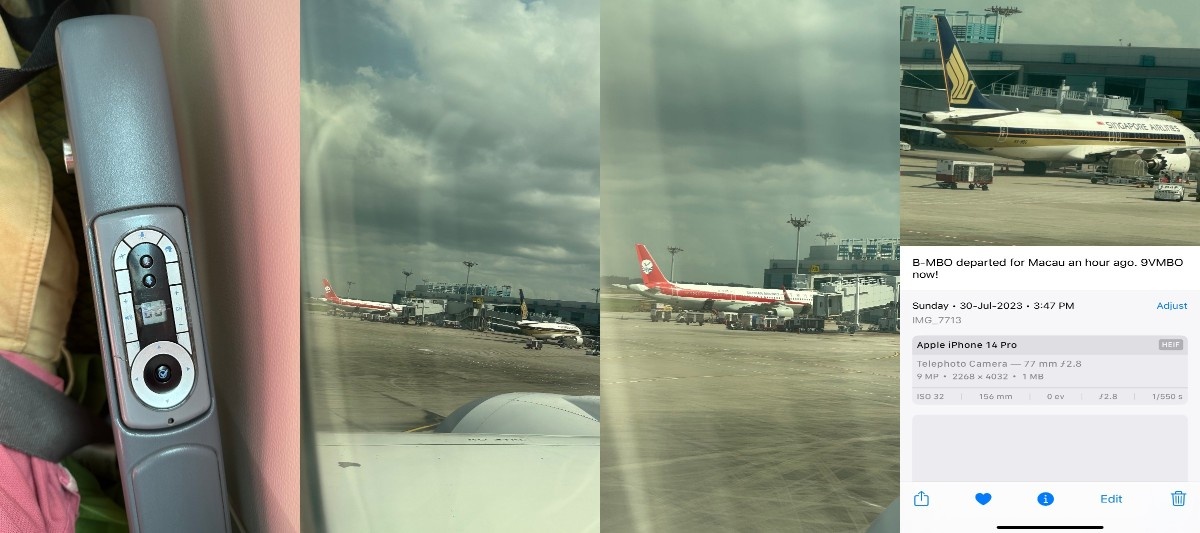
A more familiar neighbour was present too: 9M-MXY, which would depart for KUL as MH624. Before long we had turned onto the runway.

I held the safety card in my hands as the Sichuan and Juneyao A321neos — B-300D and B-324C respectively — gave way to two SkyTeam 737-800s, one Chinese (Xiamen Air’s B-5706, MF874 to Hangzhou) and one not (Garuda Indonesia’s PK-GNM, GA833 to Jakarta).
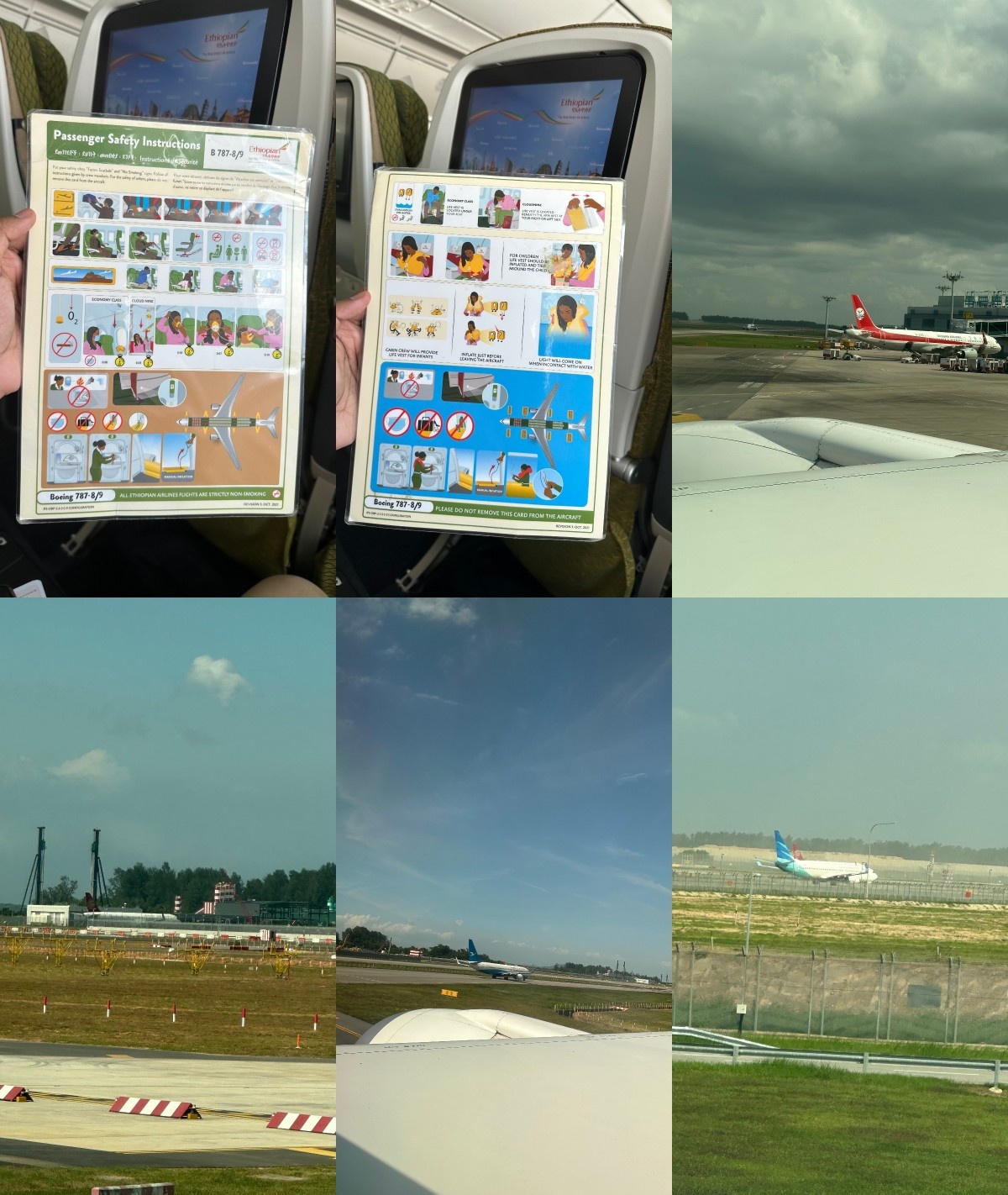
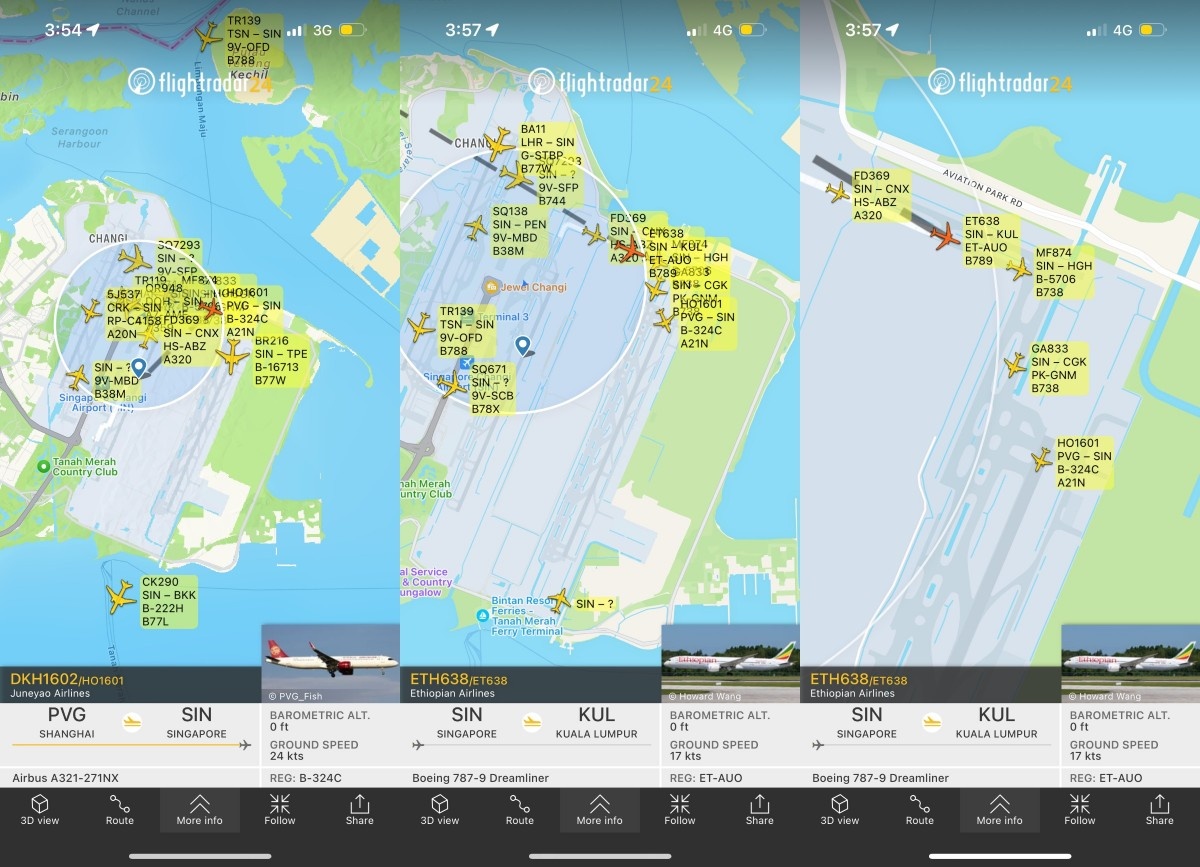
Never in my life have I seen as many Chinese aircraft as I did today, from so many airlines — all the more so since China was closed to the world for three years, until the end of 2022 when it ripped the ‘zero-COVID’ Band-Aid off and swung from one extreme to the other.

I put on Rasiya Reprise from the Bollywood superhero fantasy film Brahmastra - Part I: Shiva (2022) as we hurtled down the runway. I’ve written about this melodious masterpiece before, as it was sung by none other than Arijit Singh, perhaps the most in-demand Hindi singer today. Few songs are as rousing and heart-moving as this one, and the power-packed chorus perfectly matched the rumble of the Dreamliner’s Rolls-Royce engines.
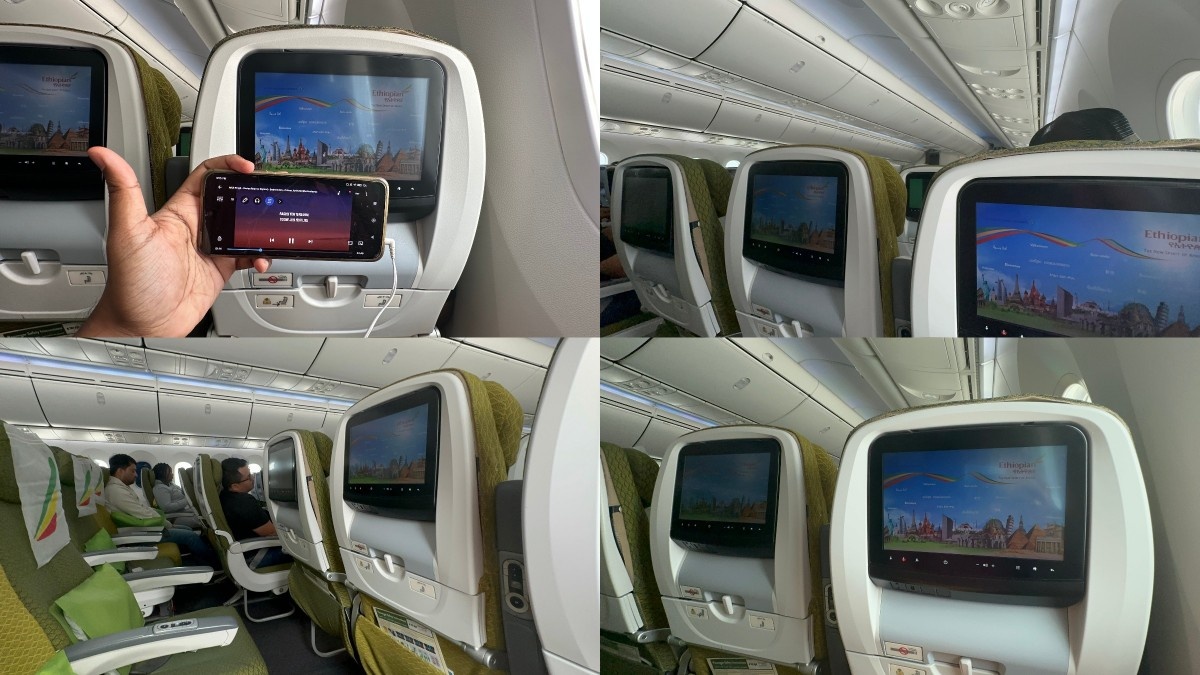
Water sprayed out of the engine as we rose, above the dull grey clouds and into the azul skies beyond, only for me to return to these ships in this sea after a matter of eight hours.

Eth-ertainment
I’m afraid ET’s IFE UI is very outdated and tacky in its appearance on the newer A350s and 787s, with the outdated Univers font, much like fellow Star Alliance members Air India and LOT Polish Airlines on their 787s. In fact I borderline preferred the older UI I’d seen on the 787-8. That said, there was quite the selection of Western, African, Indian, Asian and other movies across regions and genres — enough for the extended journey all the way to Addis Ababa.
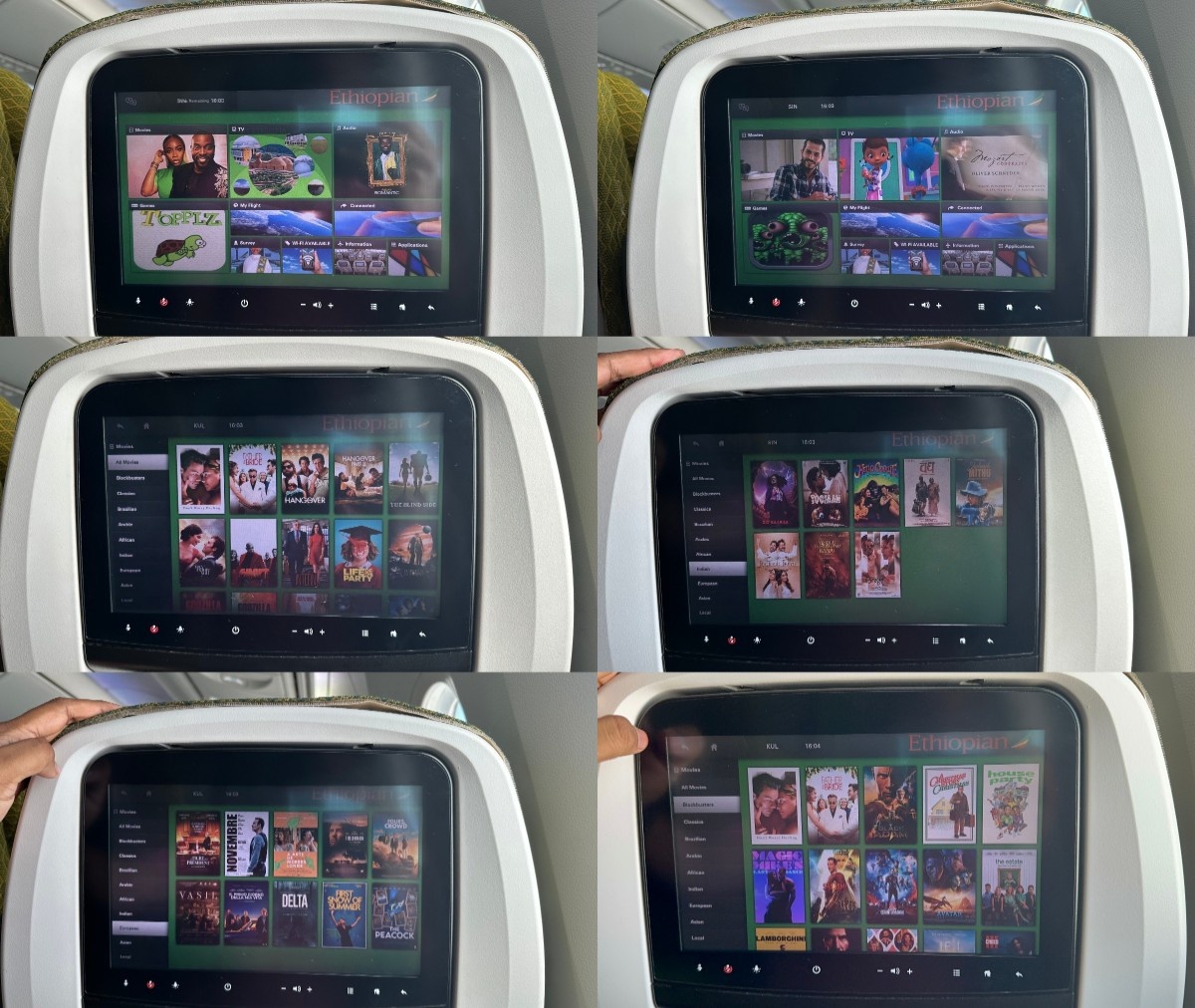
The maps feature was the same 3DMaps by Thales that I’d seen on SQ’s ‘Flight 714 to Bangkok’ in December — and more precisely the older version, also using Univers, not the newer ones on my SQ flights to and from Bengaluru in June/July that included the registration of the aircraft.

There were plenty of videos about the airline and the country, much like what I’ve seen on SriLankan Airlines.
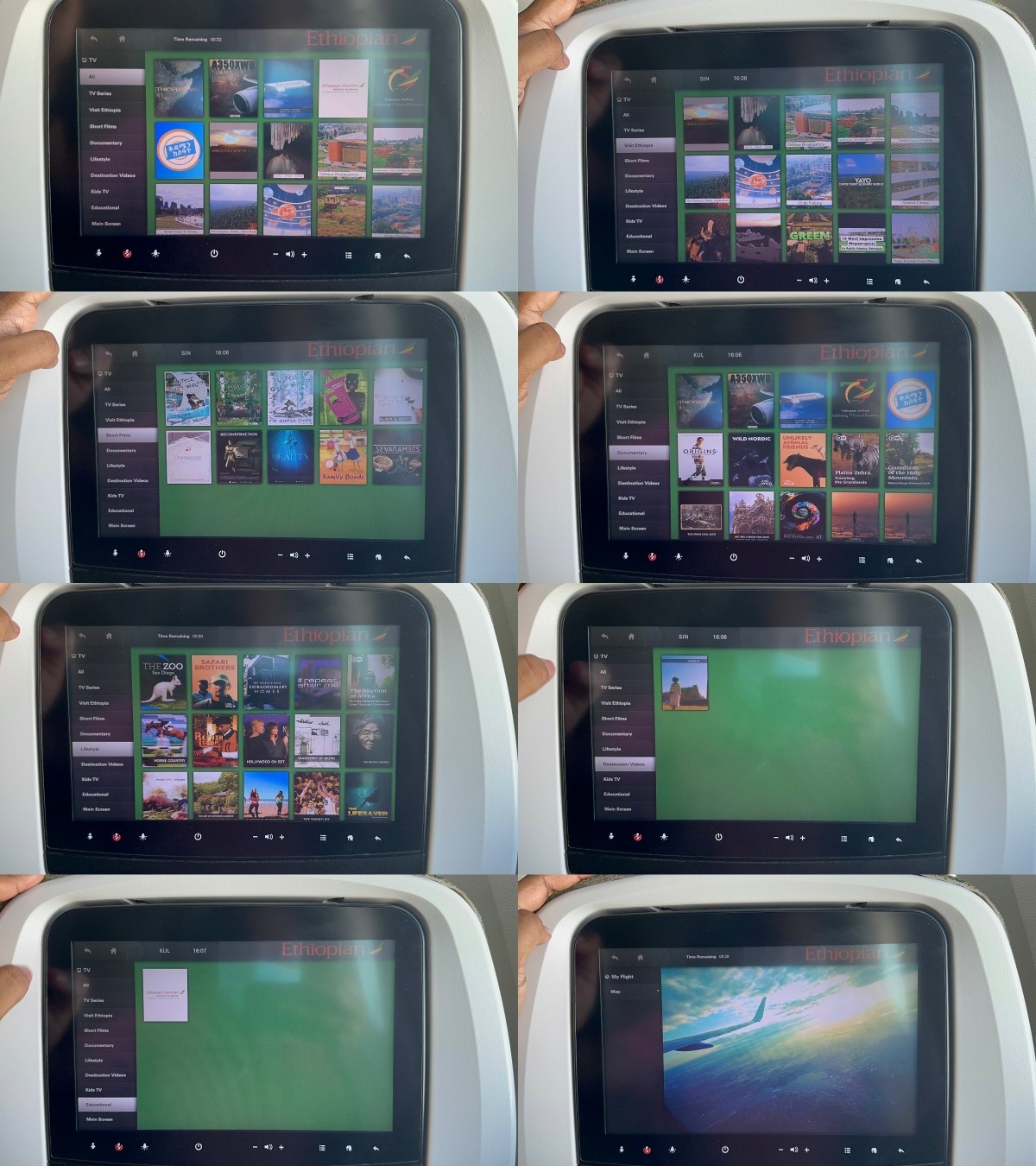
Here was a whole Wikipedia page’s worth of information on Ethiopian’s history, awards, fleet and codeshare partners.
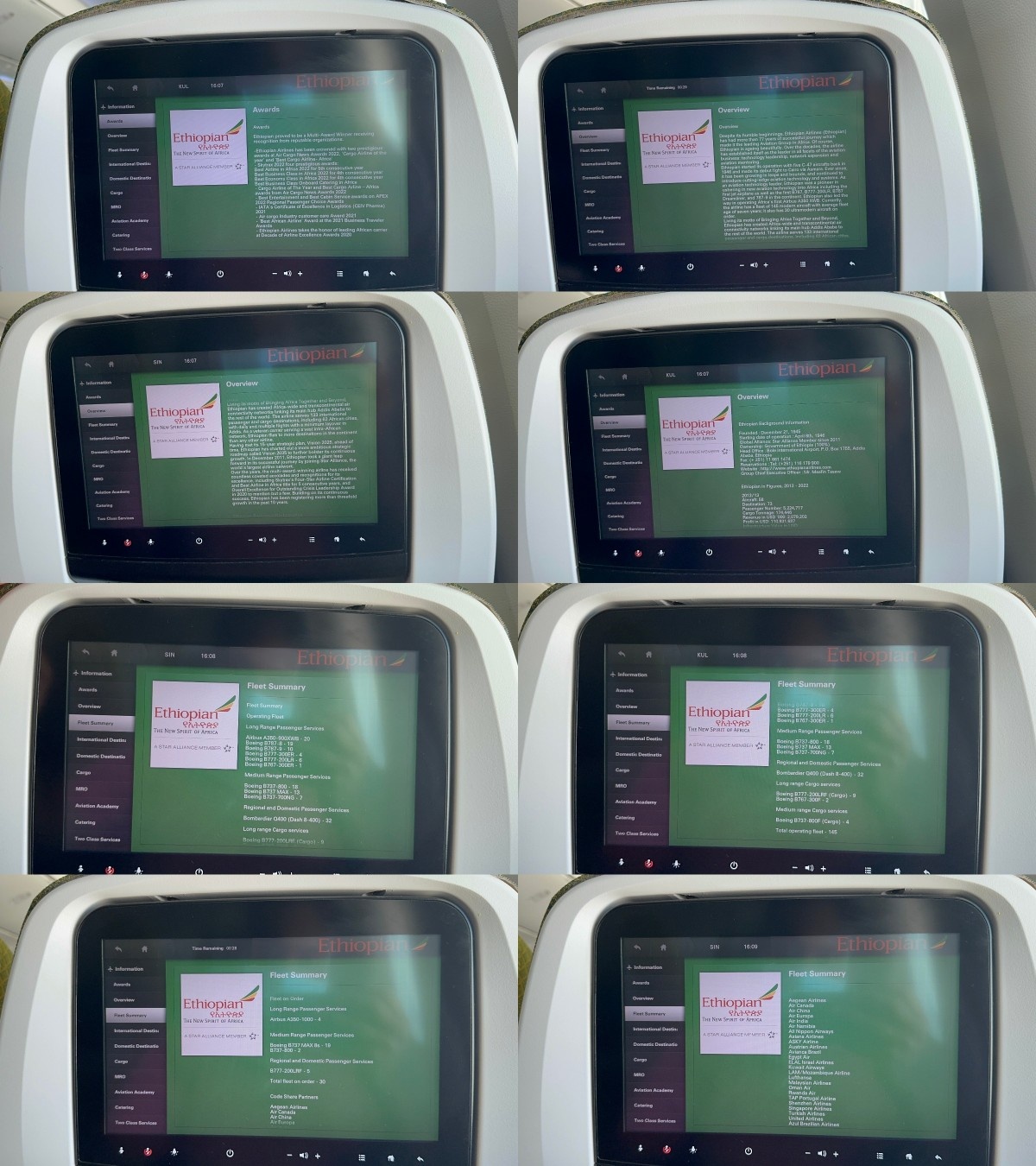
And these were all the destinations it served: a most impressive offering across continents, much like Star Alliance partners Turkish Airlines and to an extent Lufthansa, with only Australia missing. However, TK is all but ready to start service to Sydney and Melbourne, via Singapore for the time being until it gets longer-range aircraft. It would be nice if ET were to do the same, though of course ADD is a high-altitude airport while IST is not — which means only Perth might be feasible nonstop.
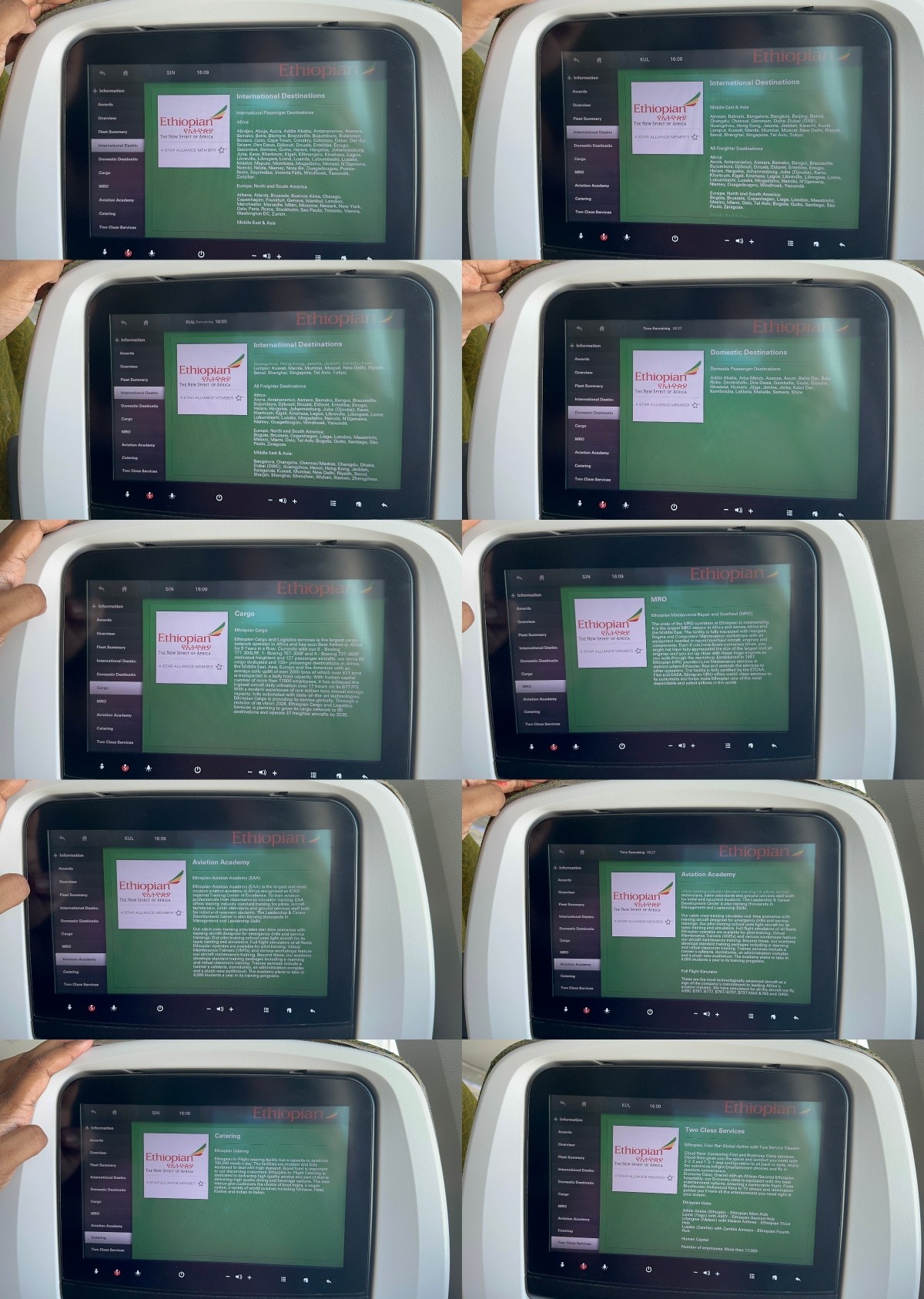
Next up was a feedback survey, which a lot of airlines have, but no one pays any attention to — or has the time for!
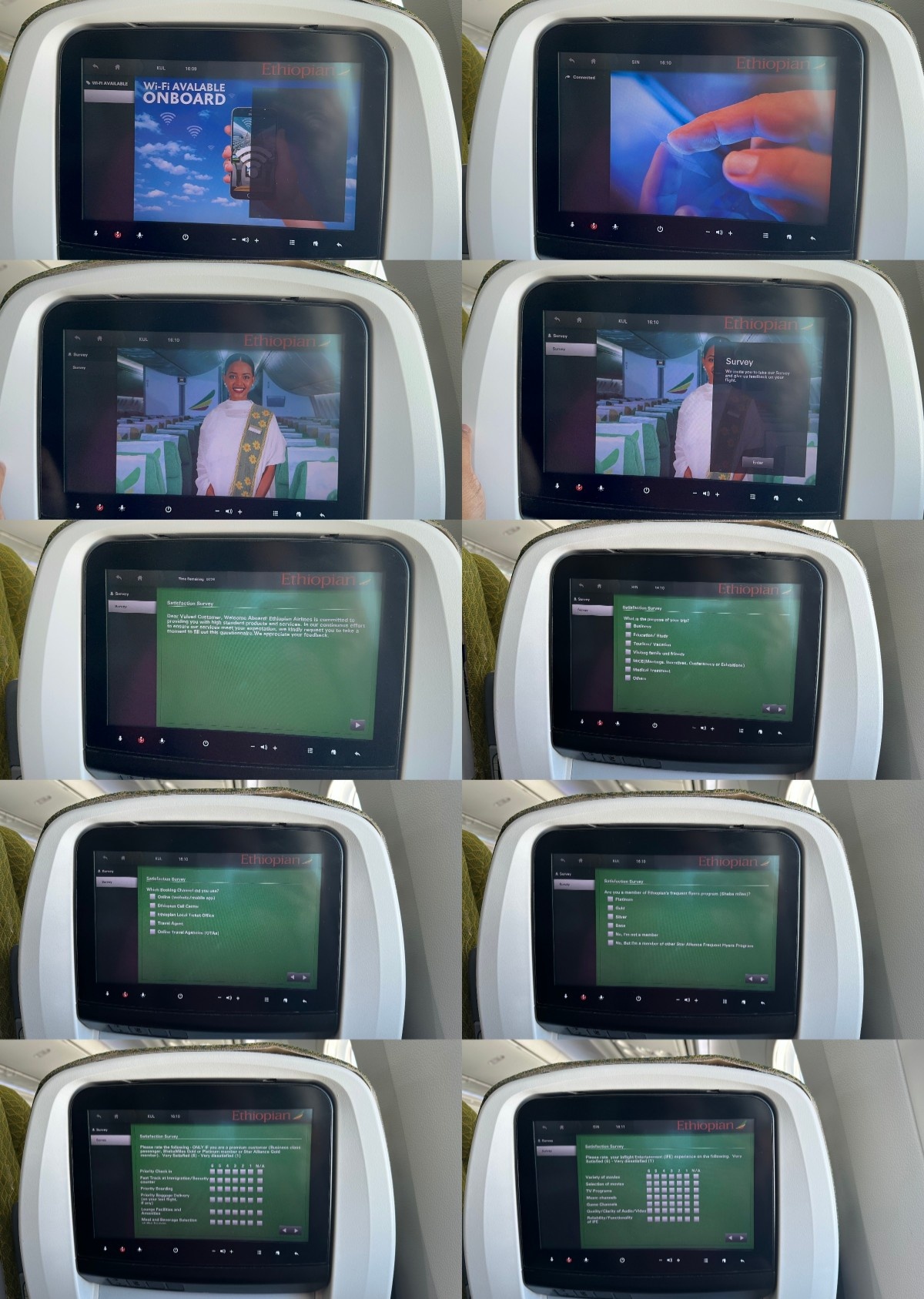
A bit of the music selection, including local artists and international names.

Catering and descent
As I always find to be the case for fifth-freedom flights, the cabin was no more than half full, so the cabin crew — I was served by Rahel B., a woman in a yellow waistcoat and tied-up hair — did not need to hustle in any way to serve their little snack. This was a round sandwich with what I believe was pork, along with a ‘Stopover@Addis’ paper tissue that, of course, I preserved. Then they brought out drinks for everyone, and I, being the stereotypical one, chose Fanta.
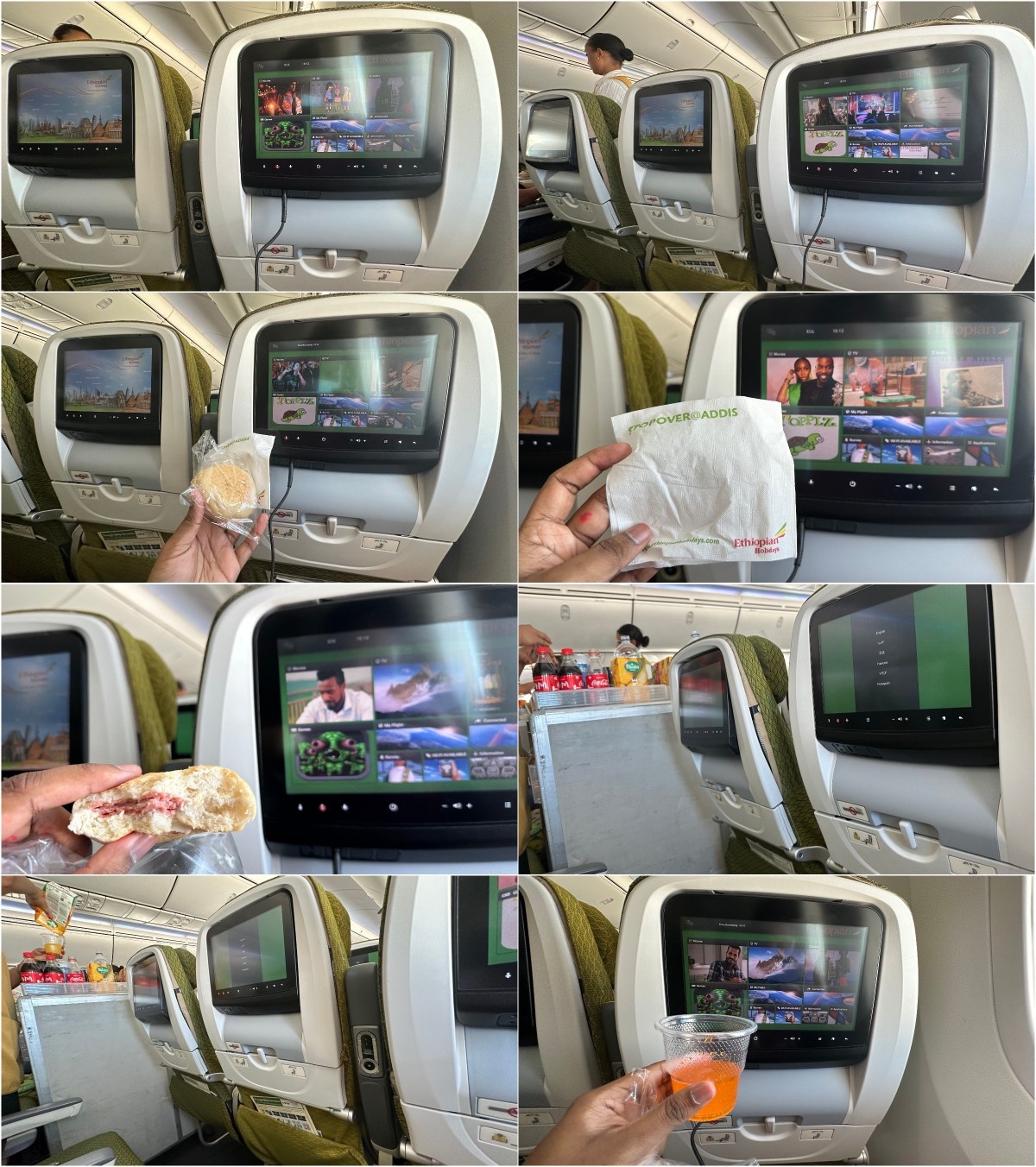
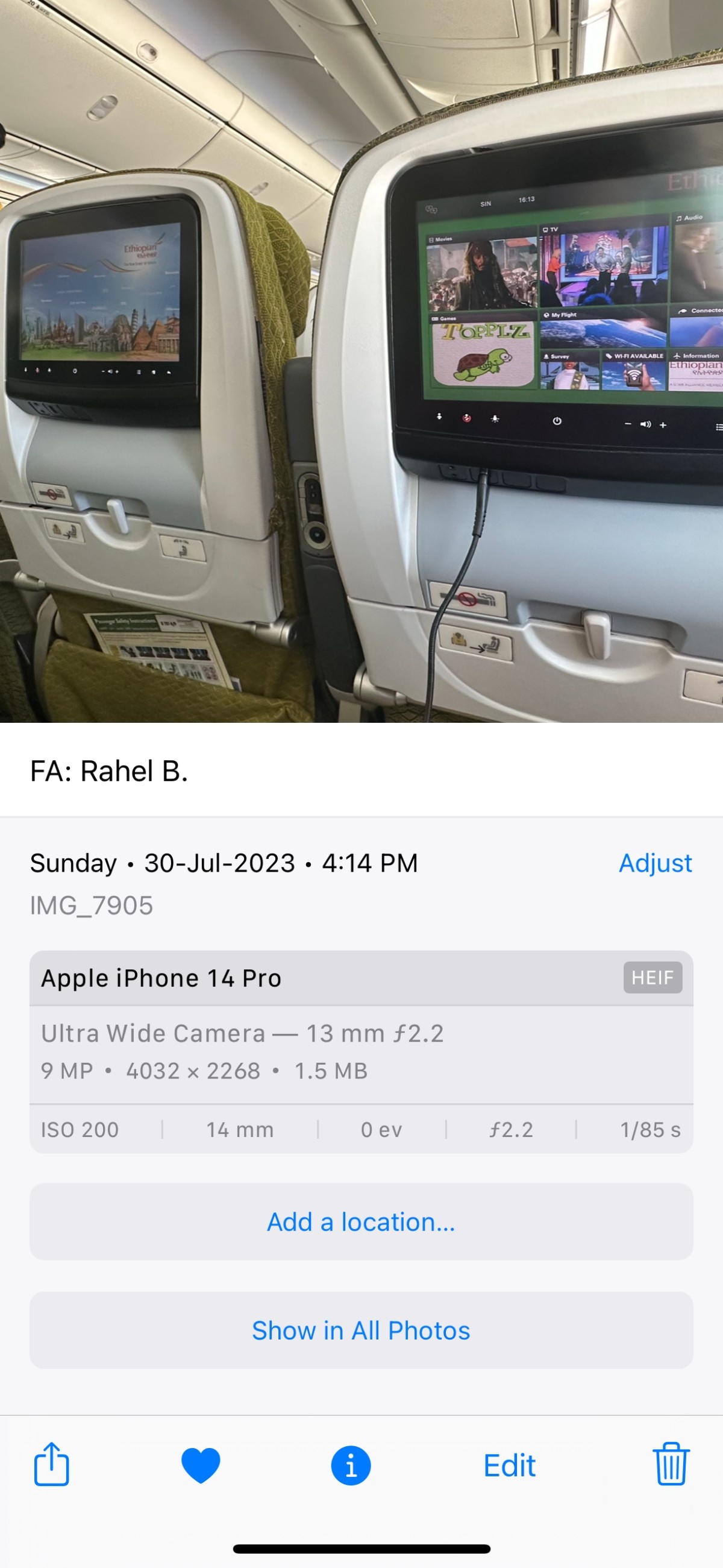
With that being the extent of the meal service on this route, I proceeded with my journal. The snack on this SIN–KUL sector was somewhere in the middle of two full pre-ordered hot meals on AirAsia and a measly cup of apple juice on SQ (oh, how the tables have turned! AirAsia is luxury, Singapore Airlines is stingy!).

I briefly flipped through the duty-free guide, it being of course quite extensive and African.

We were soon on final descent to Kuala Lumpur, whose airport is as far from the city as it is modern and attractive, kind of like the Seoul/Incheon or Malpensa of Southeast Asia.
That’s in contrast to Ho Chi Minh City, where the airport is old and doddering but you can almost see the taxi rank from the apron — very much like the erstwhile Berlin Tegel, known for both its convenience and its antiquity. Like Berlin, HCMC is building a new airport, Long Thanh, to the southeast — though the existing one will remain in use, unlike TXL — but that’s for another day.
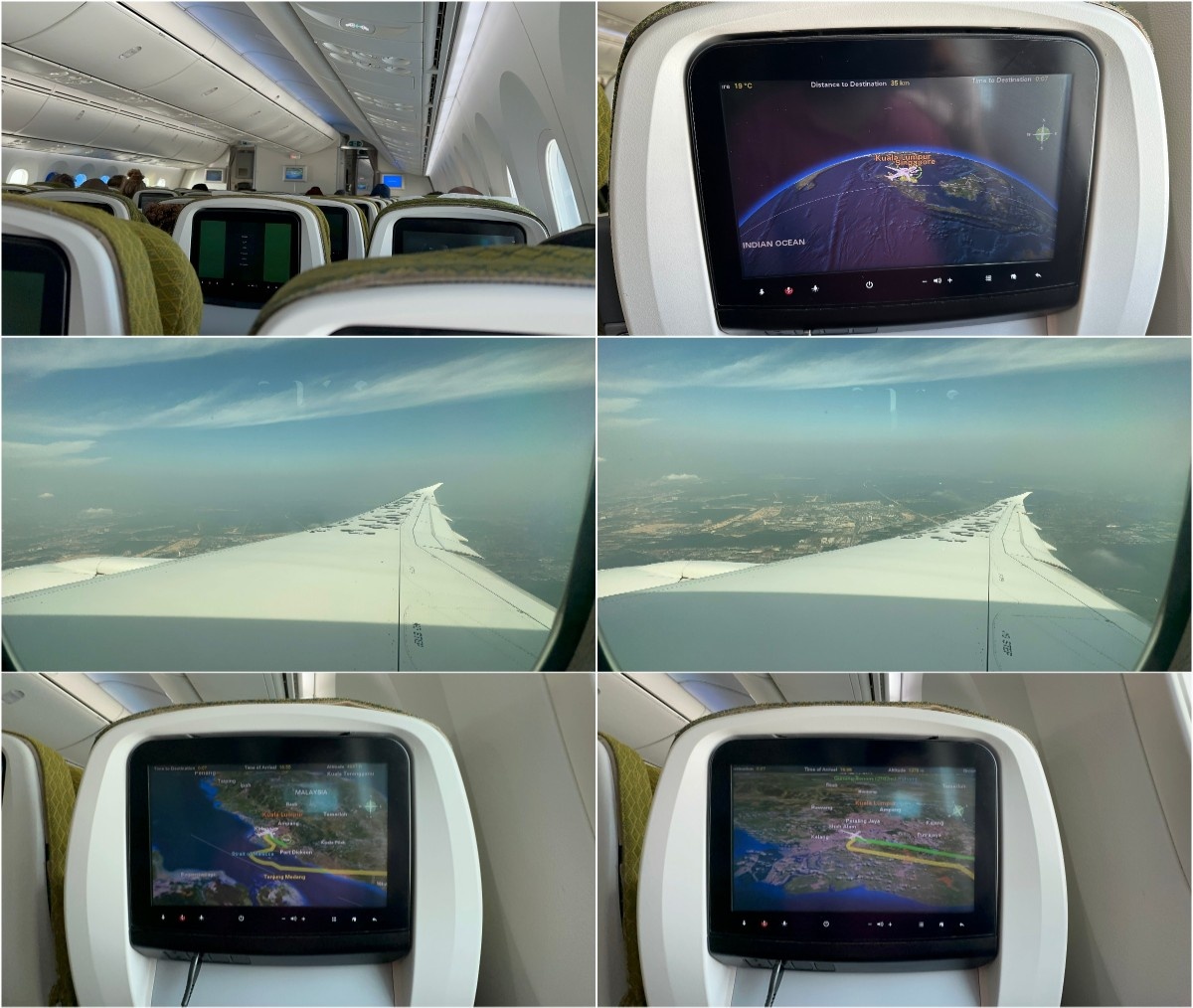
At around five, the Dreamliner made a landing amidst the plantations I so closely associate with KLIA.
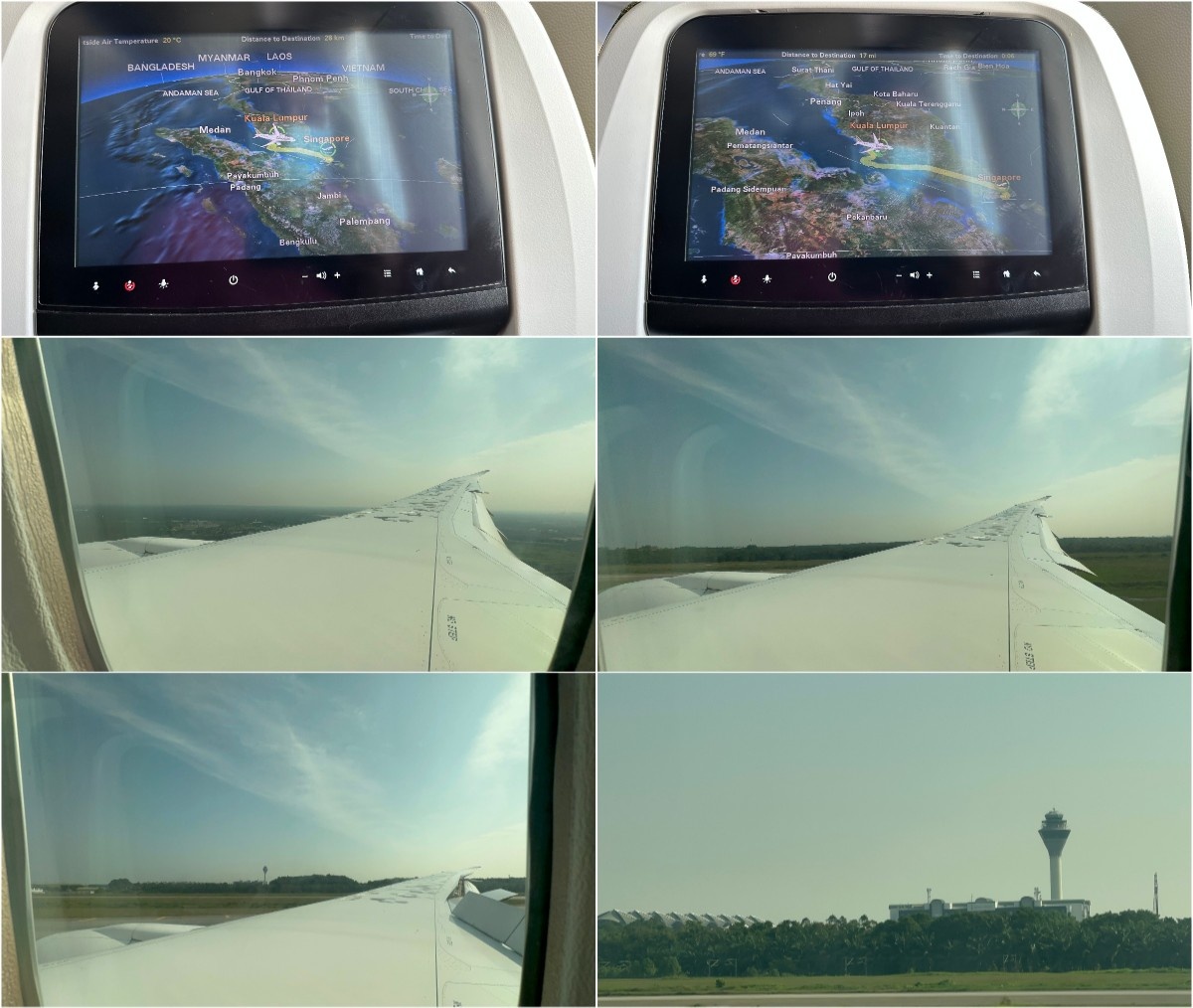
The first thing I saw was a Batik Air Malaysia A330-300 (9M-LFC) with a plain tail, the first Airbus aircraft that this branch of the Lion Group has ever operated. While the intention was to fly it to places like Tashkent, Uzbekistan, in reality it and sister-ship 9M-LFD are operating only Hajj flights to Jeddah — much like the parent Lion Air. But Batik Malaysia’s 737 MAXes fly extremely far afield — nonstop to Sydney and Melbourne, and even to Auckland via Perth — and perhaps the A330s would be better suited for such missions, as they are at Malaysia Airlines.
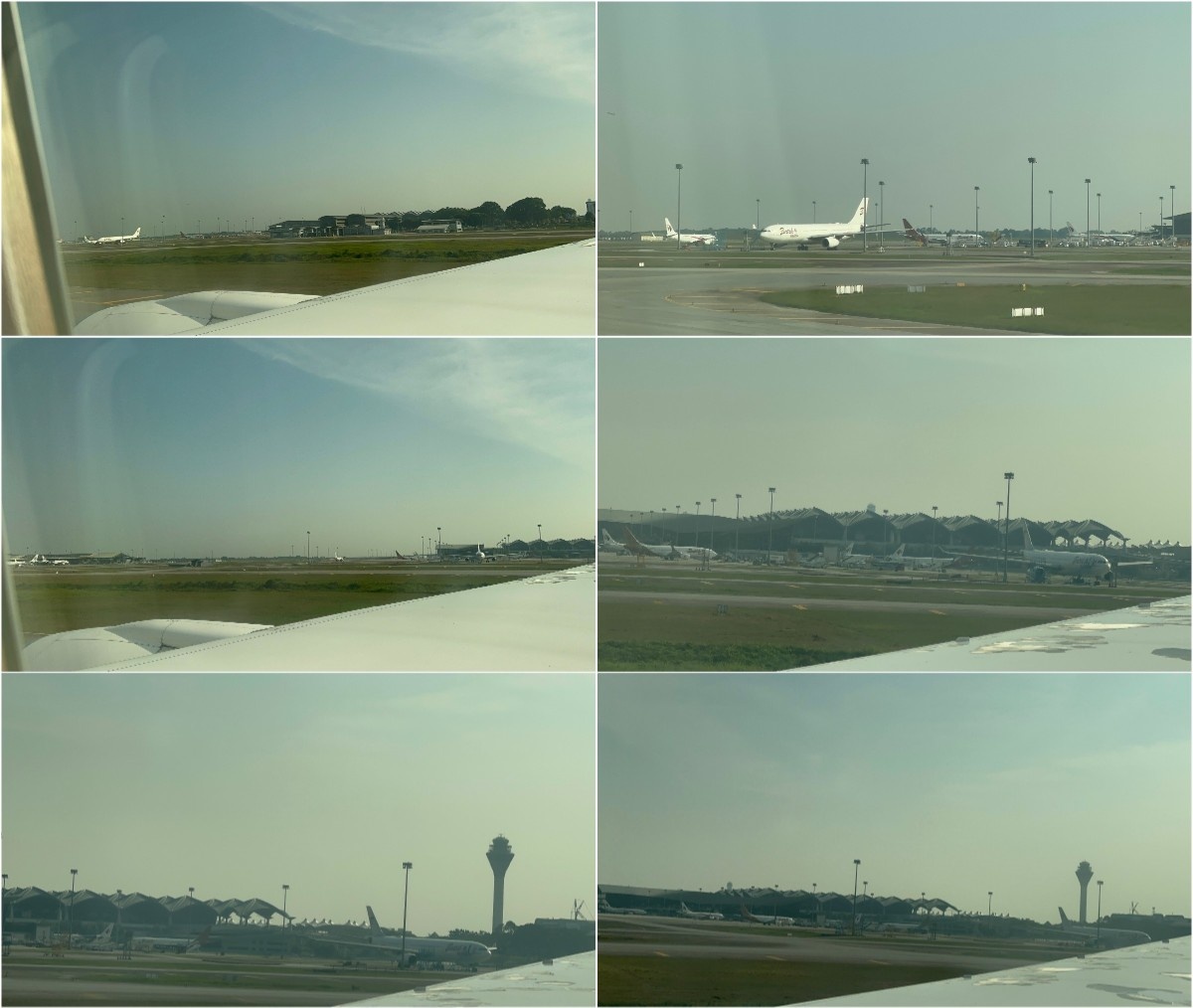
Some more views of 9M-LFC and one of MH’s own A330-300s, 9M-MTM, as we drew closer to the terminal.

Ethiopian displayed a thank-you message in four languages — English, French, Chinese and Arabic — which I had not seen on the previous flight with them in May. While I appreciated the gesture, it looked rather outdated with the 4:3 layout.

People, including several children, started to get off the plane. This being a continuing leg, the question of ‘who will stay on and who will get off’ did not arise — but in Changi, everyone must get off, whether or not you are going all the way to/from Addis Ababa.
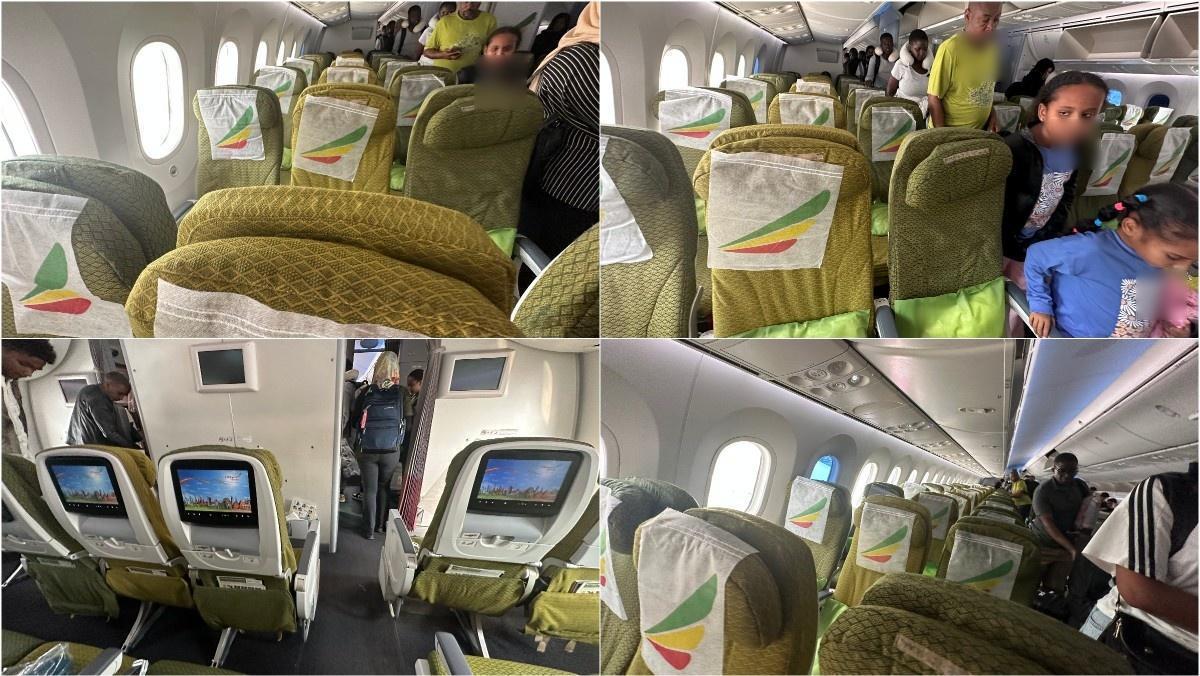
A fellow Star Alliance 787-9, TC-LLP as TK60 from Istanbul, parked close to us as I stepped onto the jetbridge.
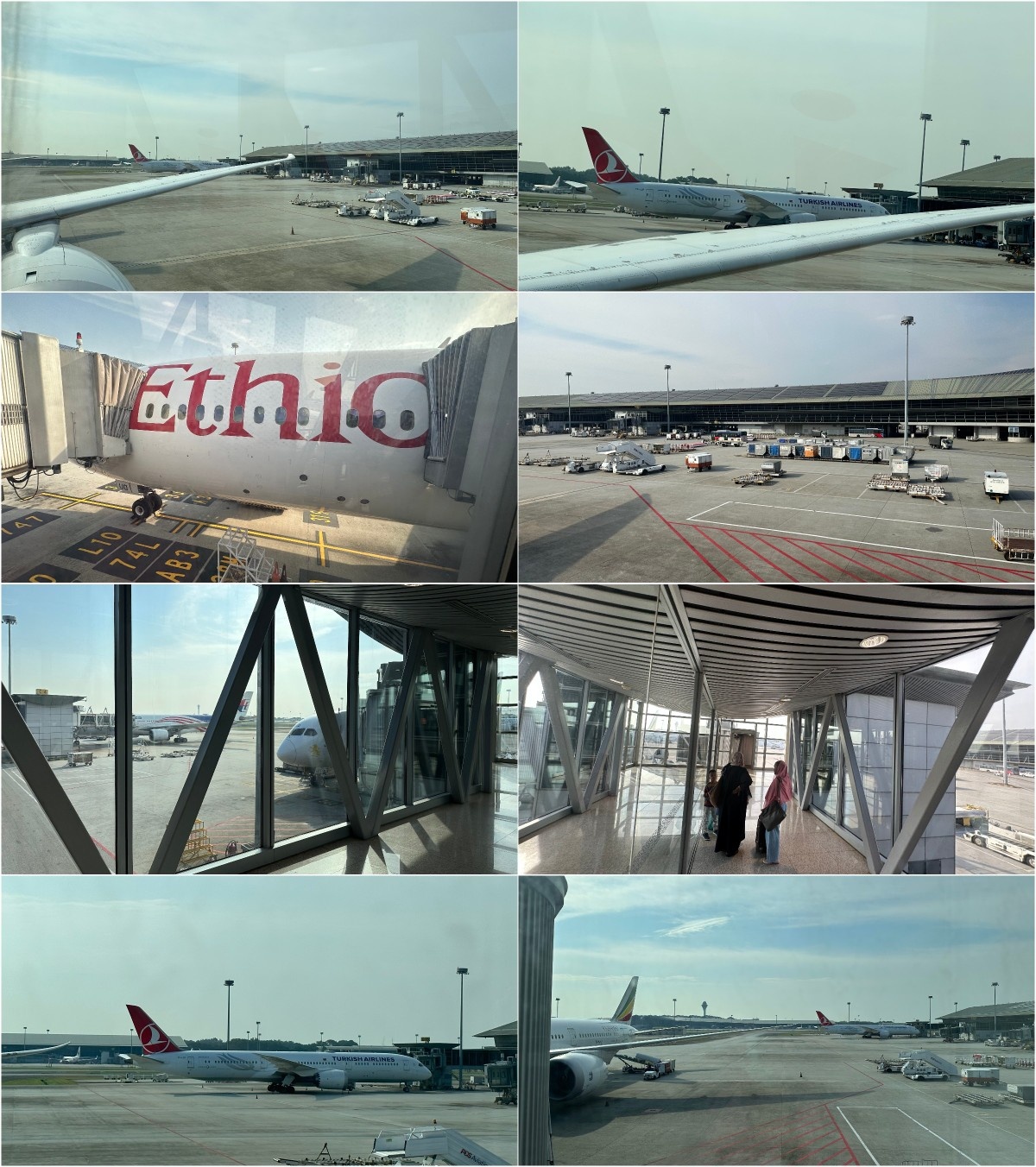
I took a good, long look at Beijing before I headed inside, though the view was covered by this cylindrical-looking object at the top.
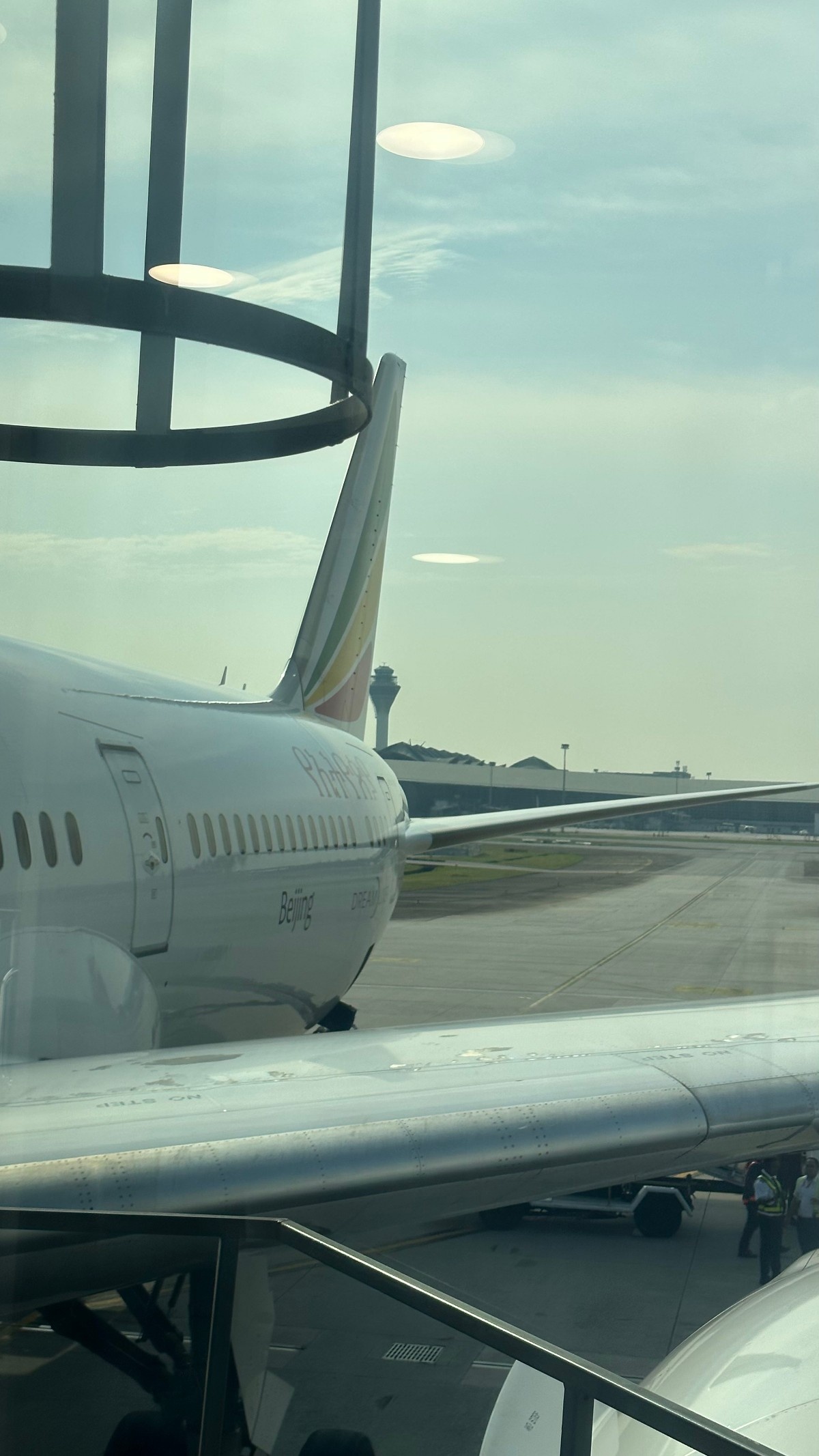
These were some of the aircraft at the ground, with the only other non-9M/9V registration in these screens being Cathay Pacific’s A330-300 B-LBA — no HS (Thai), PK (Indonesian) or VT (Indian) registrations!
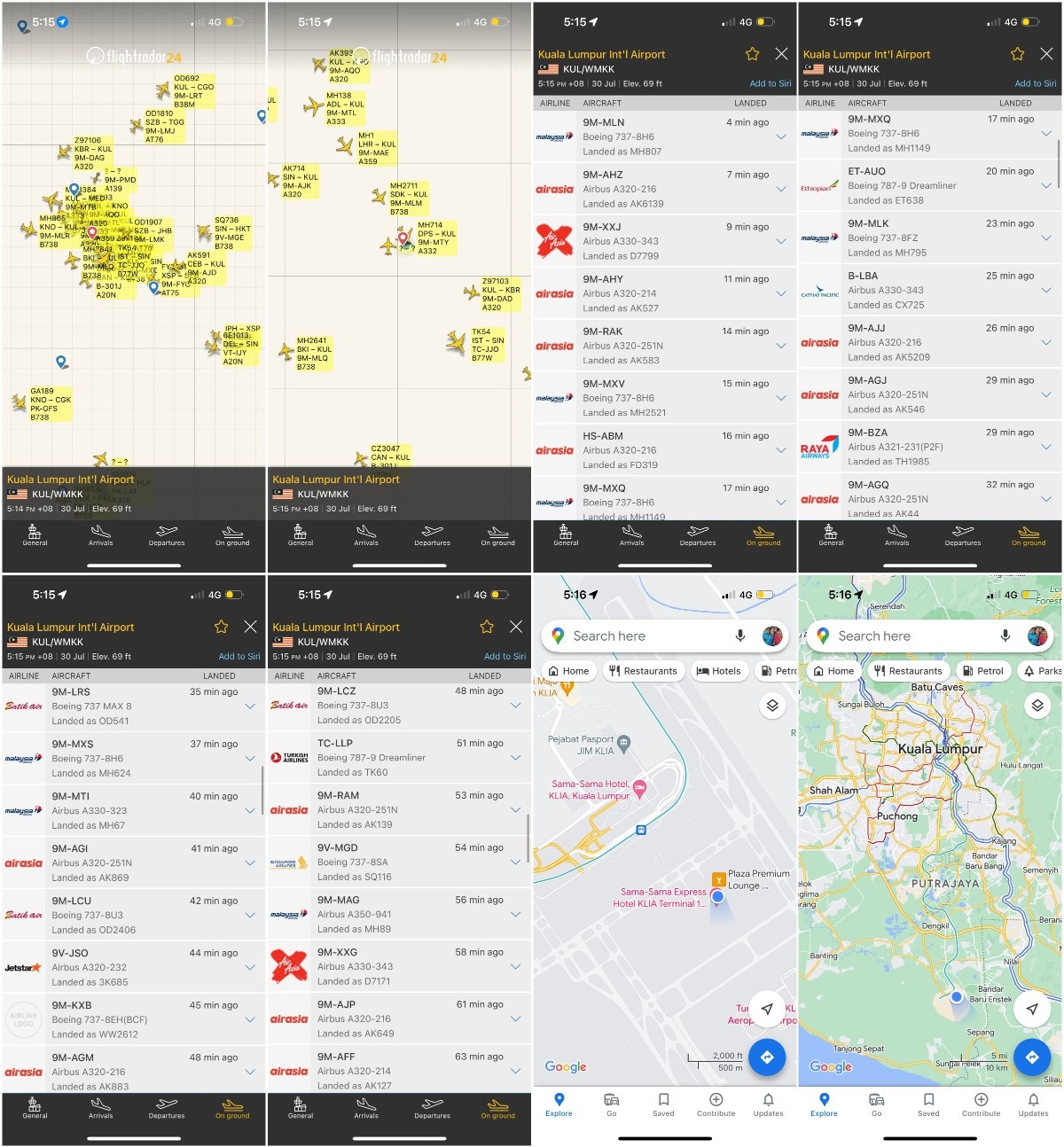
The KLIA apron joyride: Early evening edition
KLIA’s Satellite Terminal is used by all manner of long-haul airlines, from Africa (ours), the Middle East and Northeast Asia — with Turkish and KLM being the only European airlines, as the likes of Air France and Lufthansa do not serve KL or Jakarta. At the next gate, MH190 to Delhi had completed boarding, which was likely operated by 9M-MTM, the above A330-300.
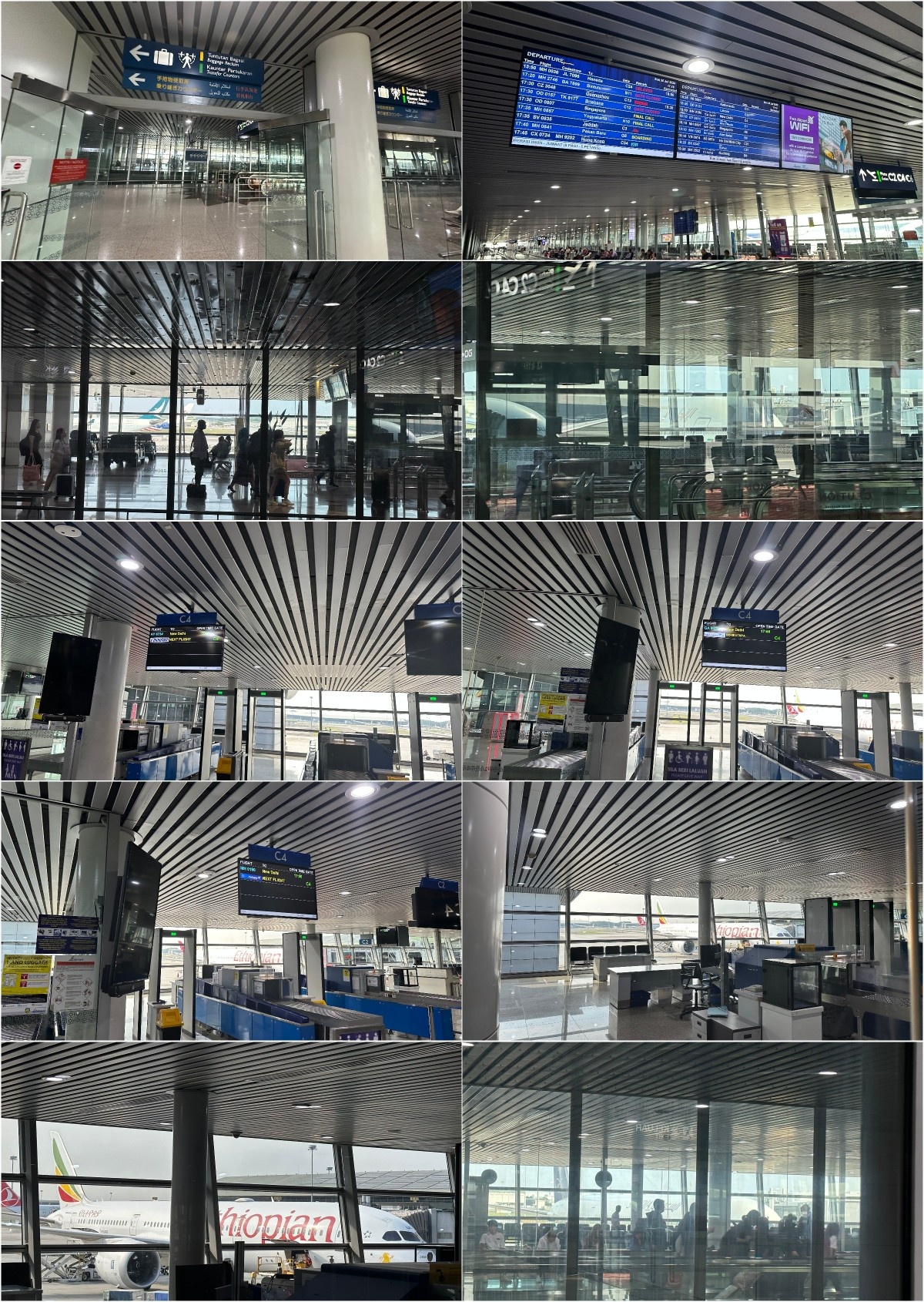
I bypassed a WHSmith on the way to the centre of the terminal, while some more shops were construction, with an expected opening date of July 2024 — a year from that time.
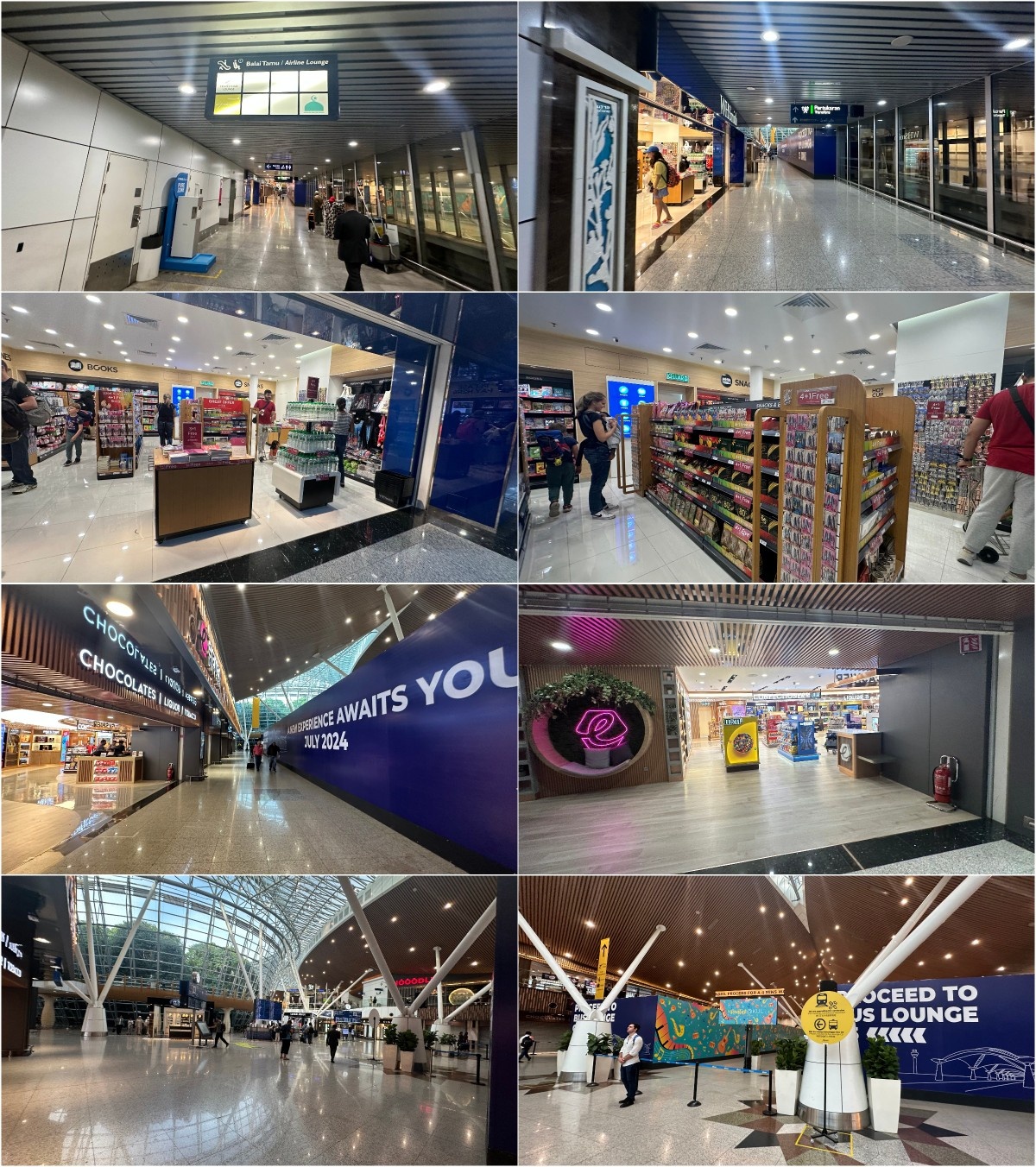
There being no more aerotrains until 2025, I had no choice but to schlep to the bus gates which would take me to the main terminal…

…but not before snapping a few more pretty beauties on the apron: Malaysia A350-900 9M-MAE, Etihad 787-10 A6-BMB and Saudia 787-10 HZ-AR28.

Now I went down a level to the bus gates, where a rickety-looking coach was waiting to whisk me away — but nowhere as ancient and rusty as the one I had at Colombo in November for a connecting redeye flight.
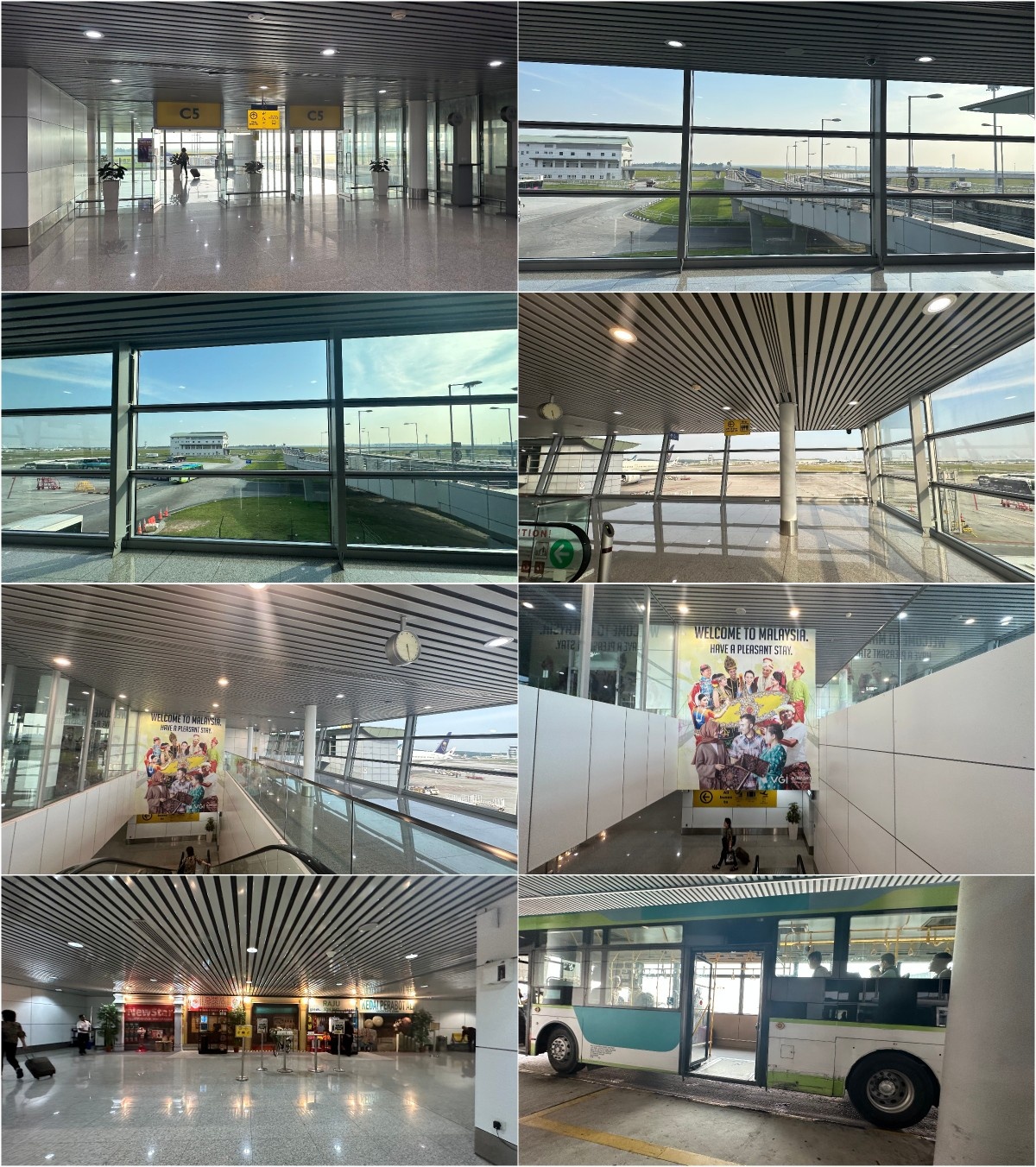
This was the real highlight of the Satellite Terminal: the views of the planes on the apron, now with the added benefit of daylight, as compared to the late-night departure in May. The Etihad and Saudia 787-10s and the Cathay A330-300 and Malaysia A350 presented themselves multiple times for me to enjoy.

As we got closer to the Main Terminal Building, I caught the TK 787-9 and MH A330-300 again, before drawing up close to two Batik Malaysia 737s: one with no paint on the tail and one with the full colours.
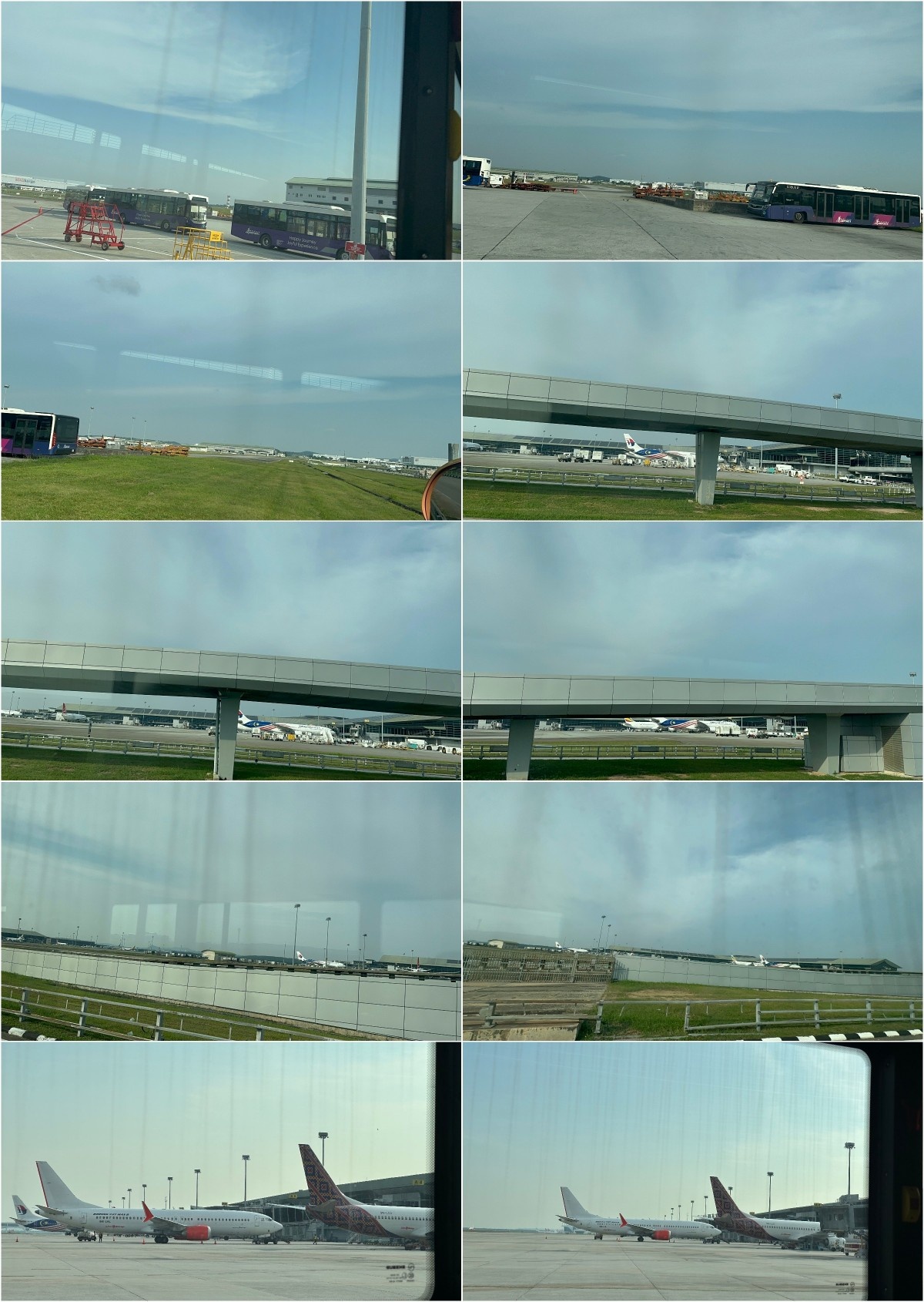
ONE HOUR AT IMMIGRATION OUT OF FOUR HOURS IN KL
On reaching the Main Terminal Building at 5:45, I became part of the serpentine queue that stretched on for a good half-hour before I was told that the multiple-entry visa on my iPad was no good, and I would have to print it out. Fah!
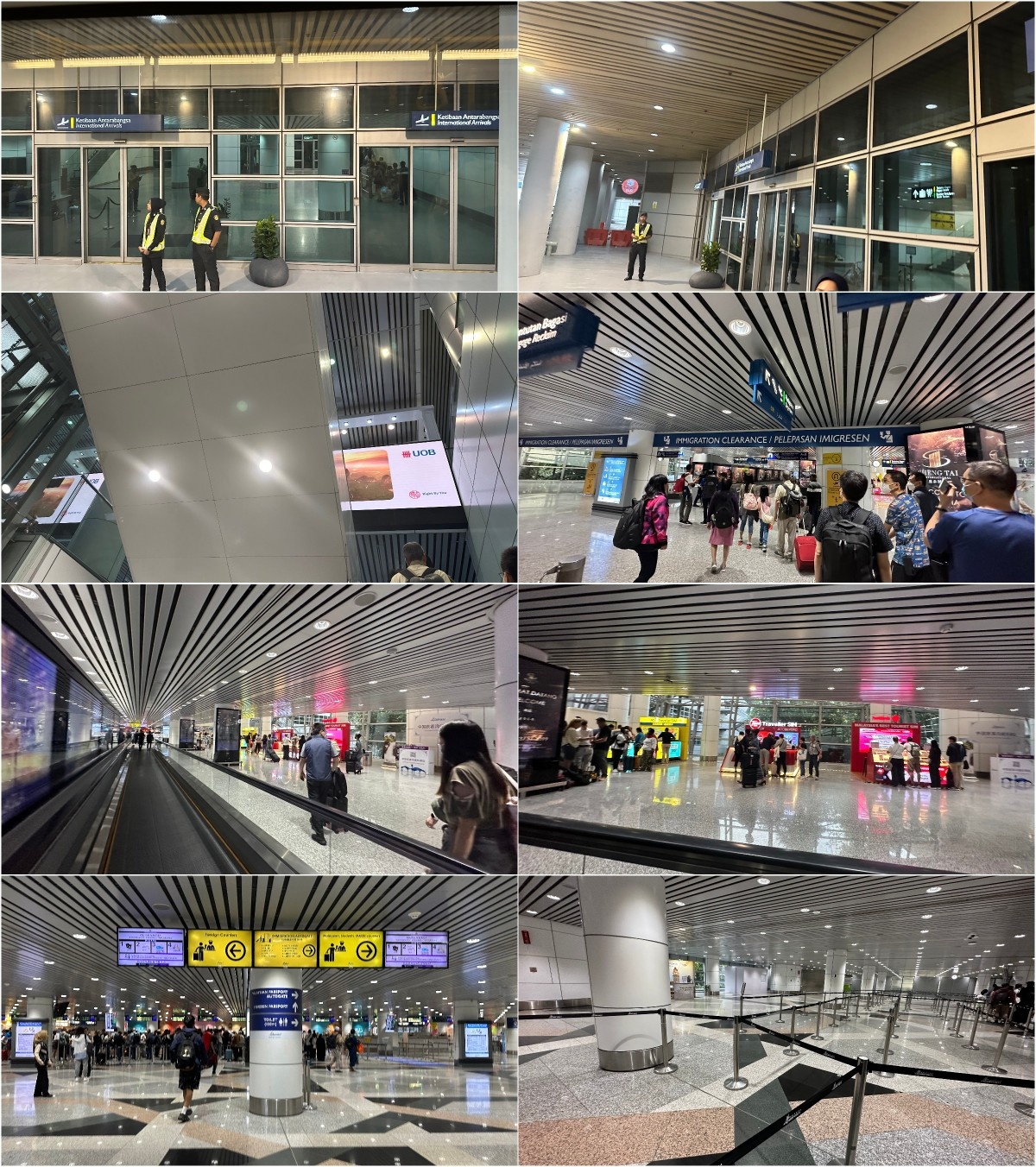
While waiting, a couple more interesting aircraft had landed: an ancient JAL 767-300ER, JA607J, and an A320 of Nepal’s Himalaya Airlines, 9N-ALW — in addition to another Chinese A320neo, China Southern’s B-301J, on a day chock-full of Chinese aircraft.
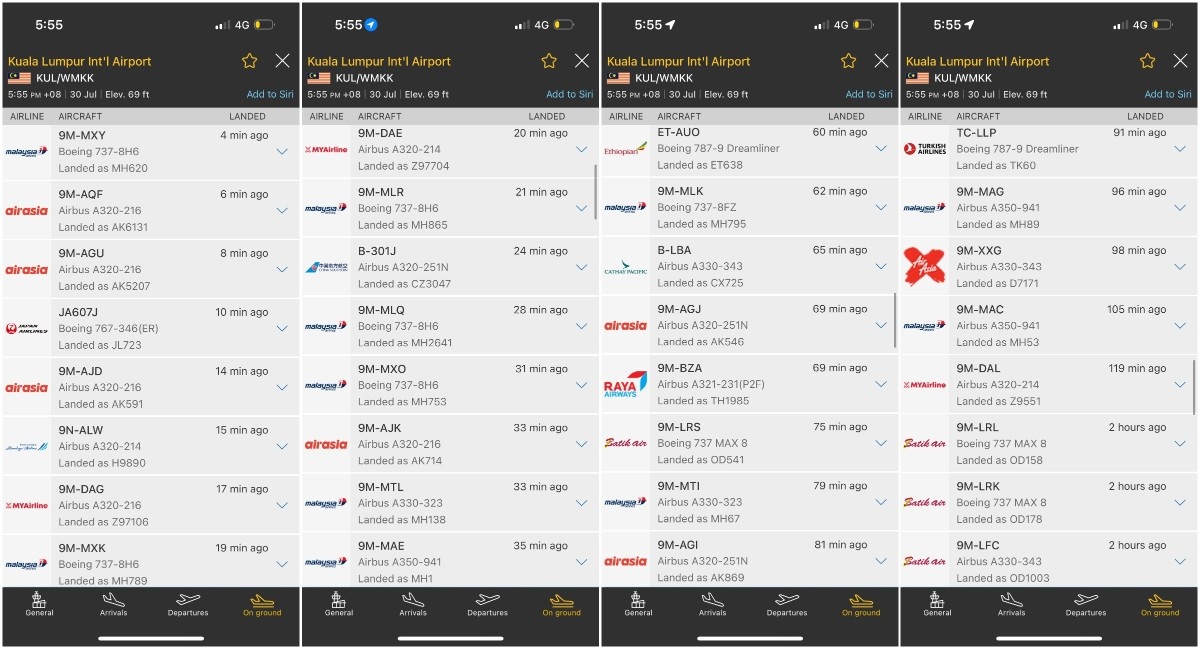
I had no choice but head to the Plaza Premium Lounge upstairs in order to print the e-visa, and en route lay a piano and some gleaming boutique shops, alongside the one and only aircraft display (as I’ve covered for the previous ET flight in May) with its bewildering variety of aircraft. At the elegant, chic lounge I waited a bit, took the print-out, shelled out whatever little ringgit (RM4) I had on me, and made my way down.
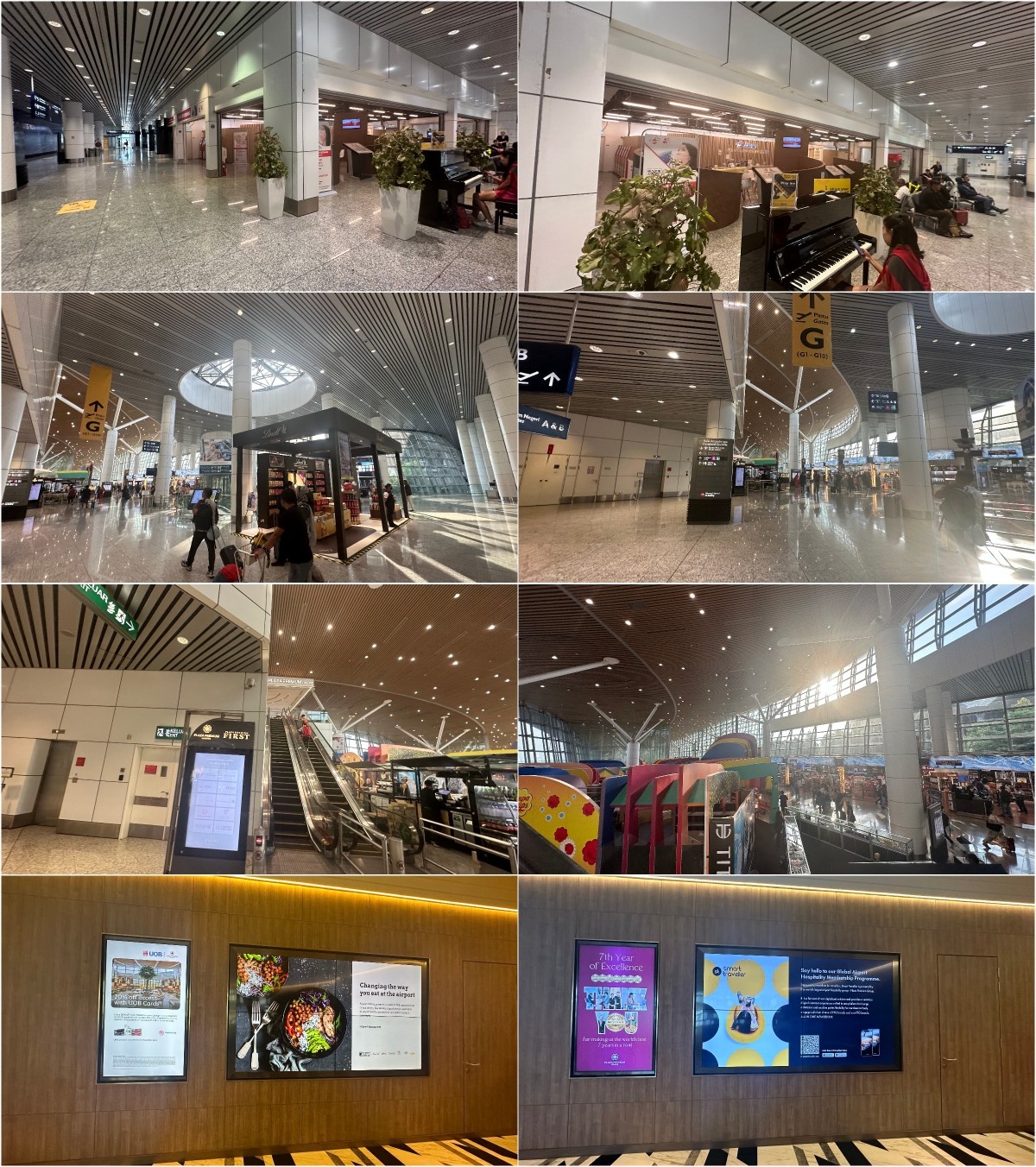
And so, for the first time, I was in the baggage claim area of KLIA’s main terminal — not that I had any to pick up. There was an ad for, among other things, a Coldplay concert in early 2024, as well as one for Malaysia’s CIMB Bank which has a pan-ASEAN presence and shares the same red colours and Open Sans font (the one you’re reading right now) as Singapore’s DBS.
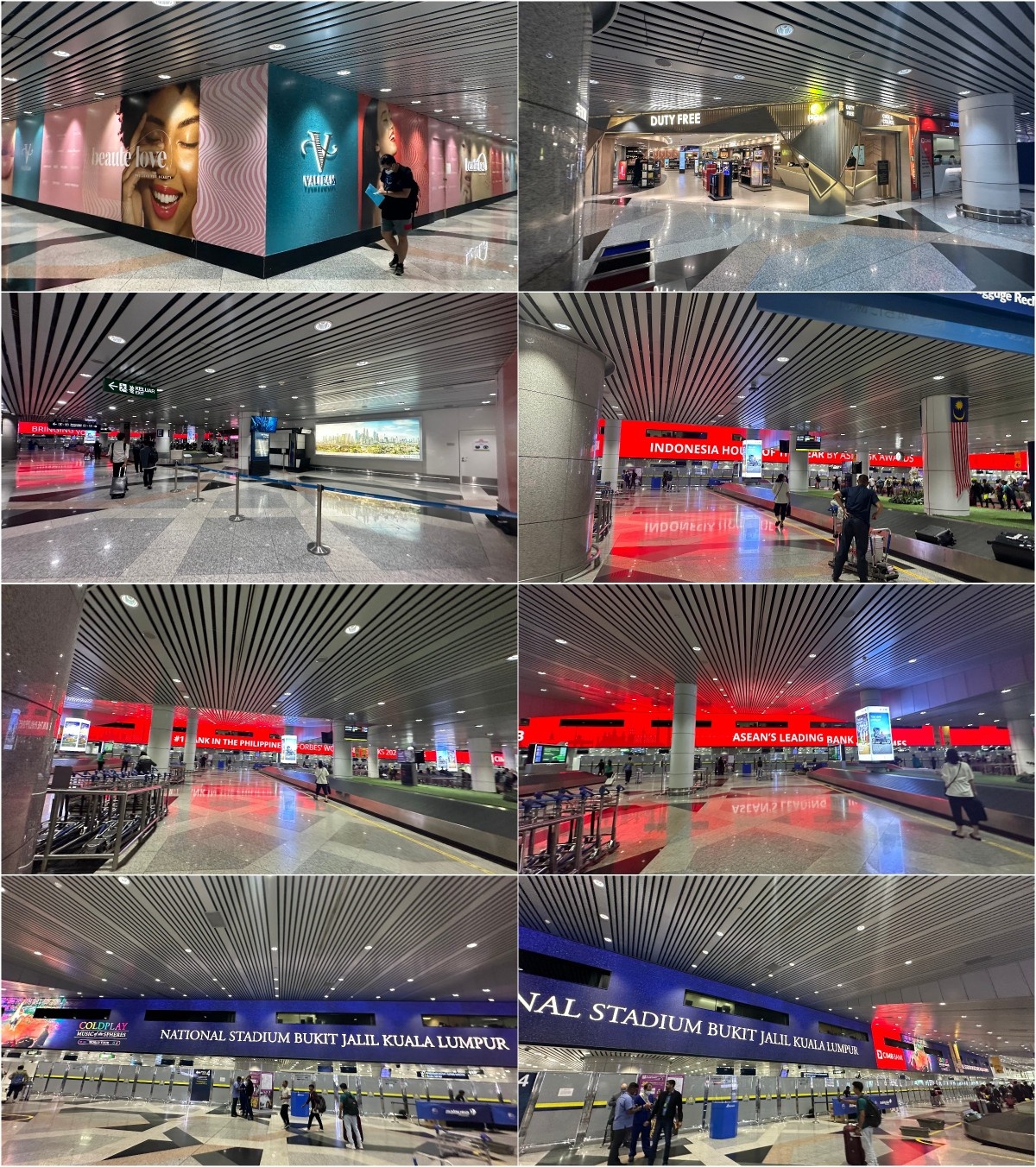
Eventually I found myself at the taxi stand, ready to start my two-hour micro-voyage to the western suburb of Bandar Sunway.
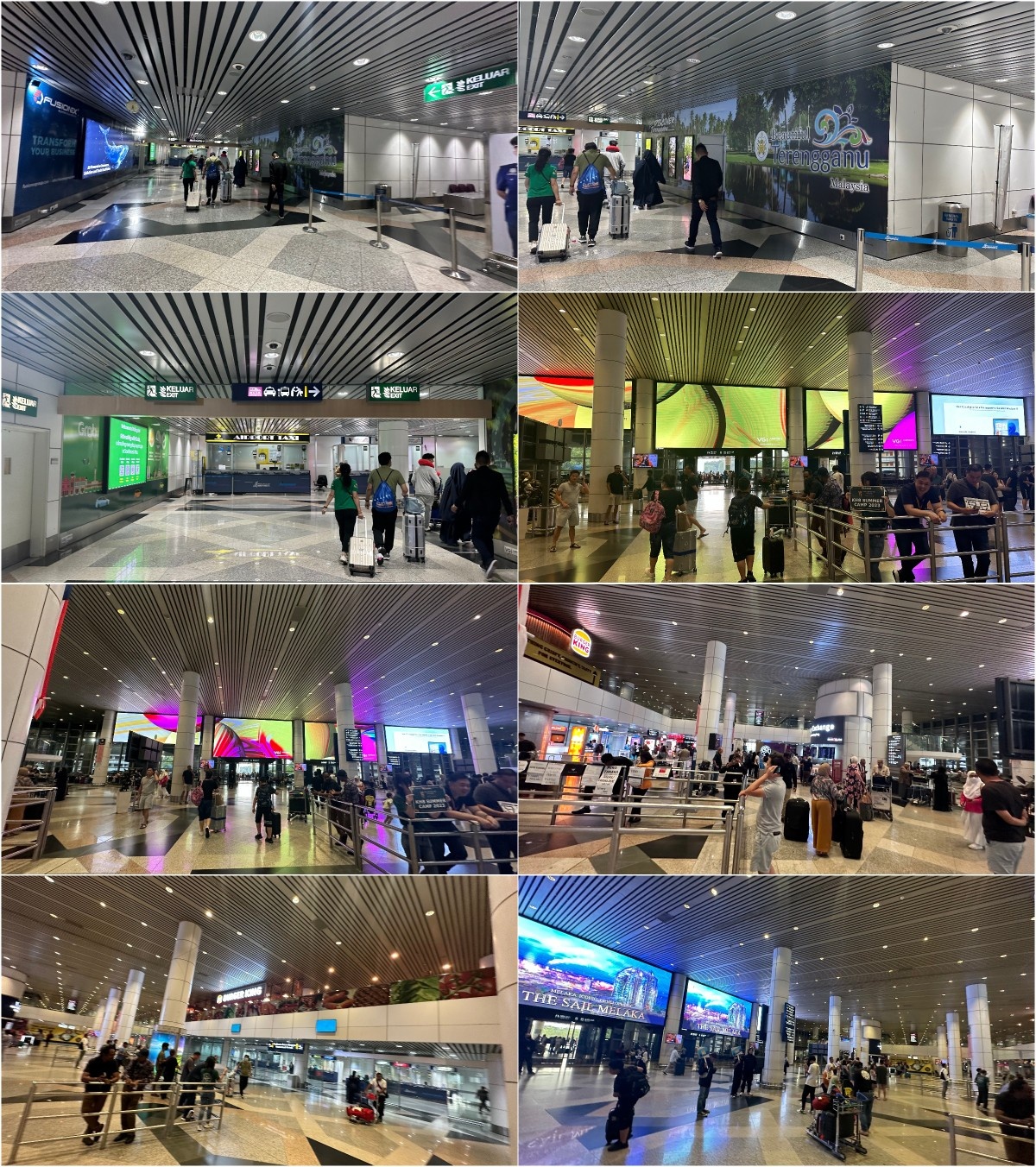
Before I proceeded, I had to buy a power bank from the Tune Talk shop in the first picture below, but — as always happens — ended up losing it within weeks. Not that it matters now, because I’ve discovered that my new iPad Air itself can act as a power bank!
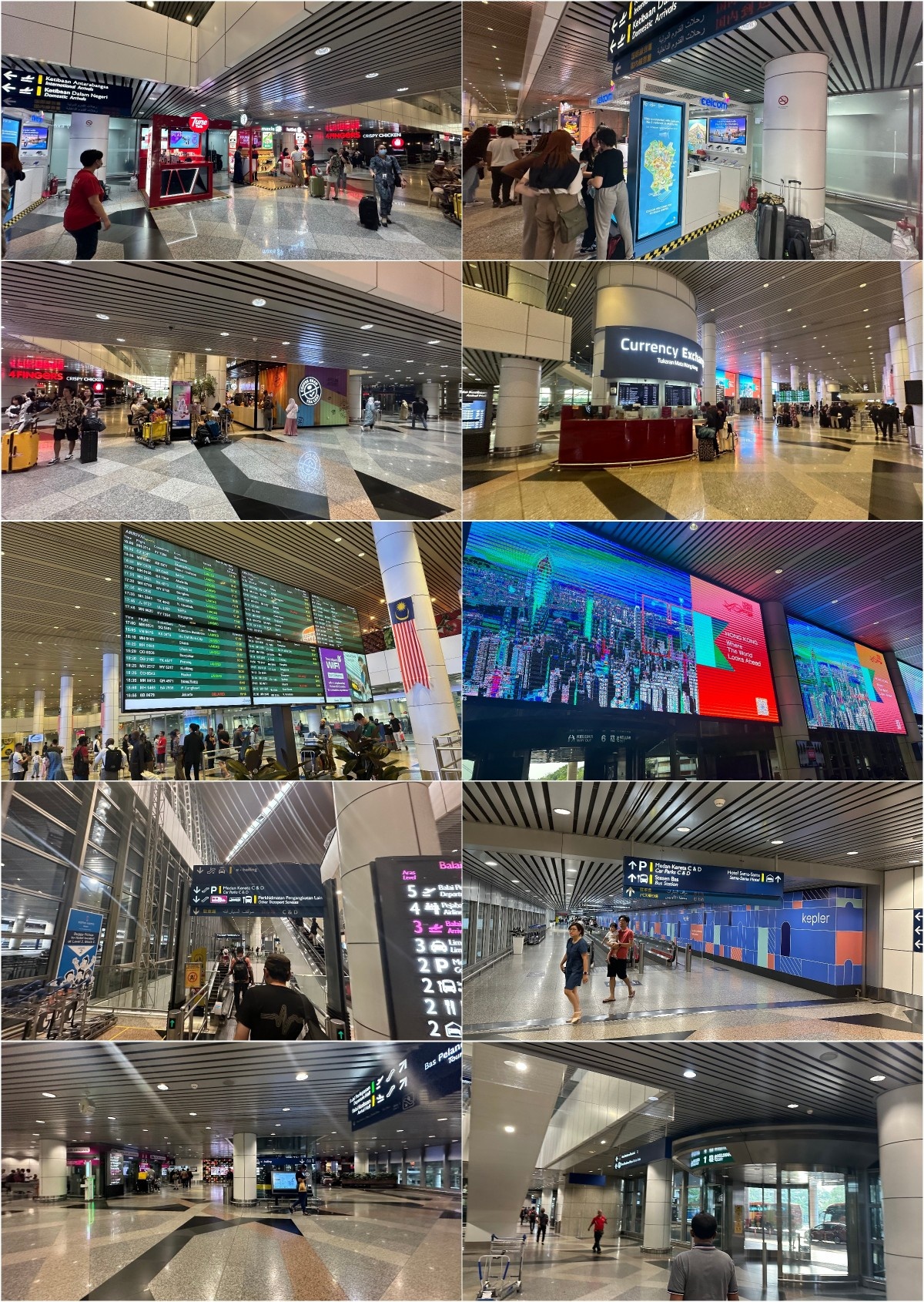
A Perodua Aruz SUV turned up and took me on the hour-long journey to the sprawling Sunway Pyramid mall, inspired by Egyptian sands, pyramids and mummies.
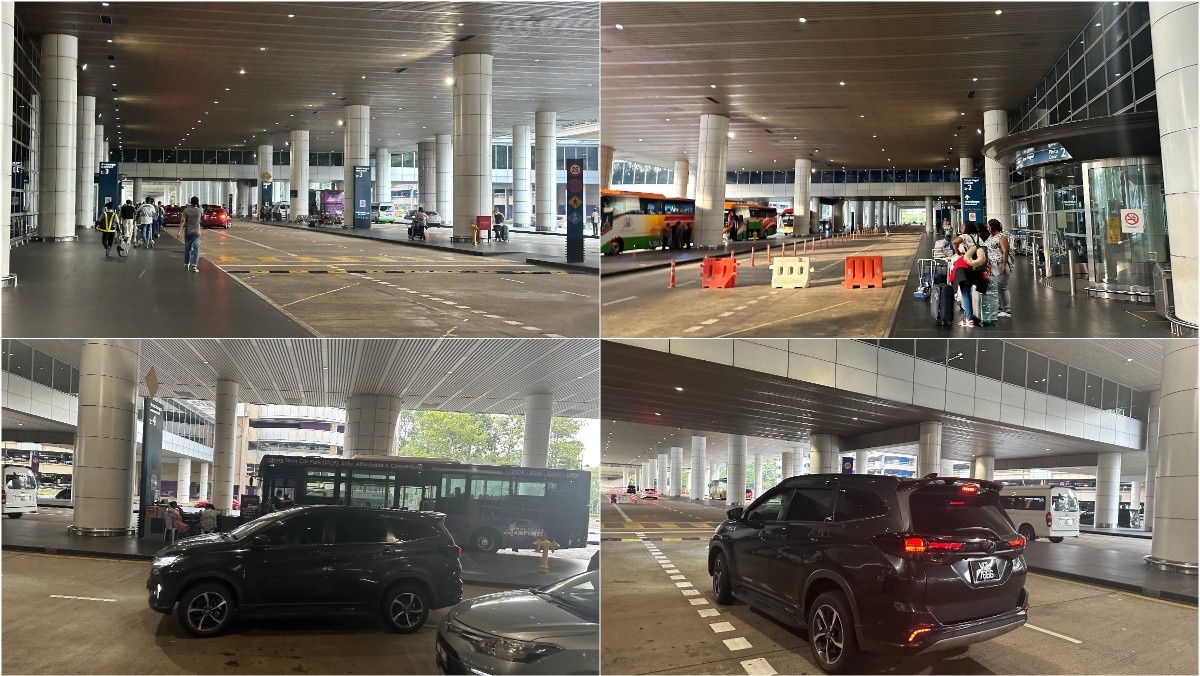
As I started to ascend from Southern Base Camp KLIA into the western fringes of the Malaysian capital, the glowing sunset was lit up further as I approached a Petronas fuel station, by a landing MH A330-200 (9M-MTV) from Jakarta.
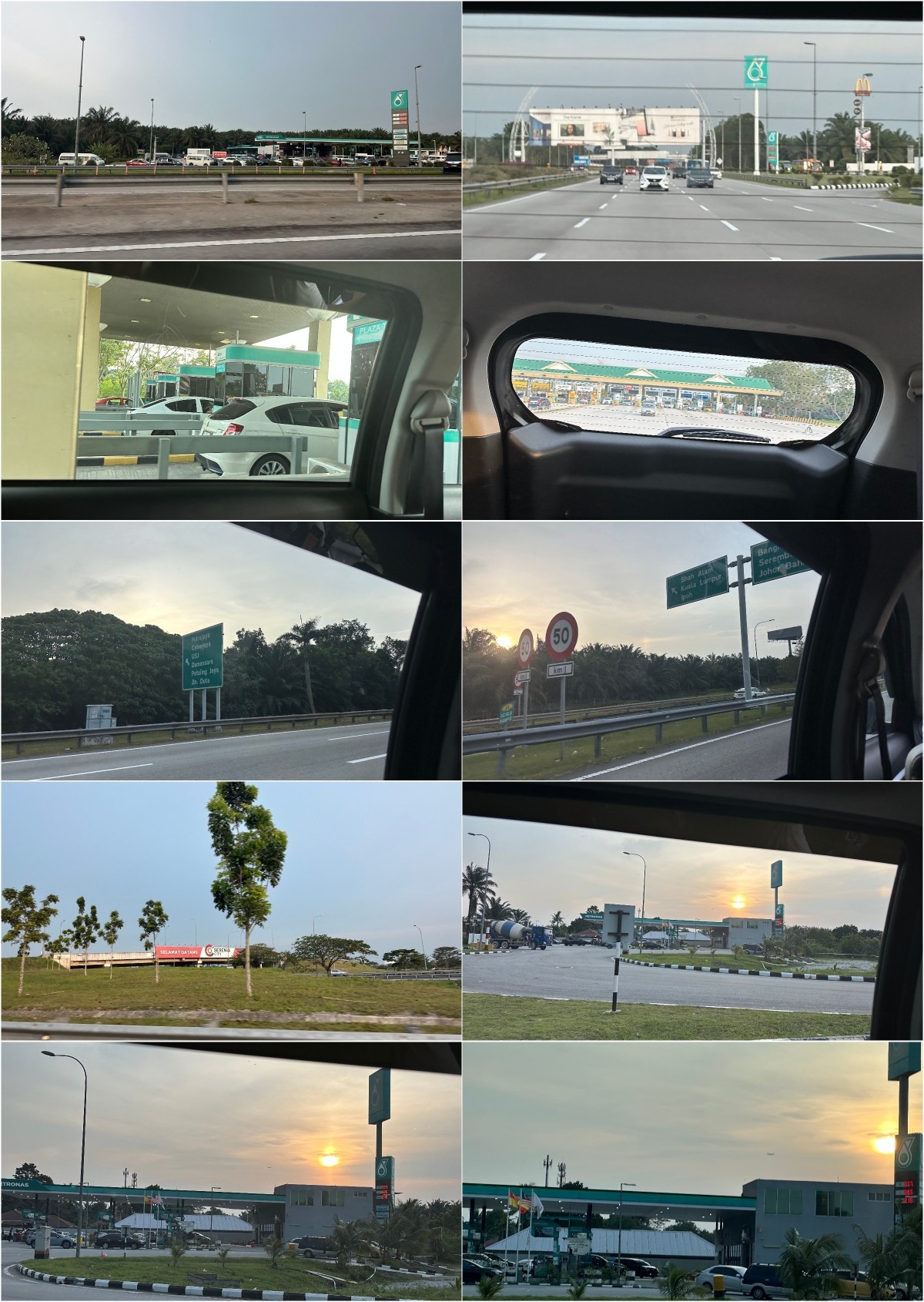
This image’s filename on my iPhone is IMG_8282.JPG, and indeed this is the 82nd and last picture in this somewhat smaller report!
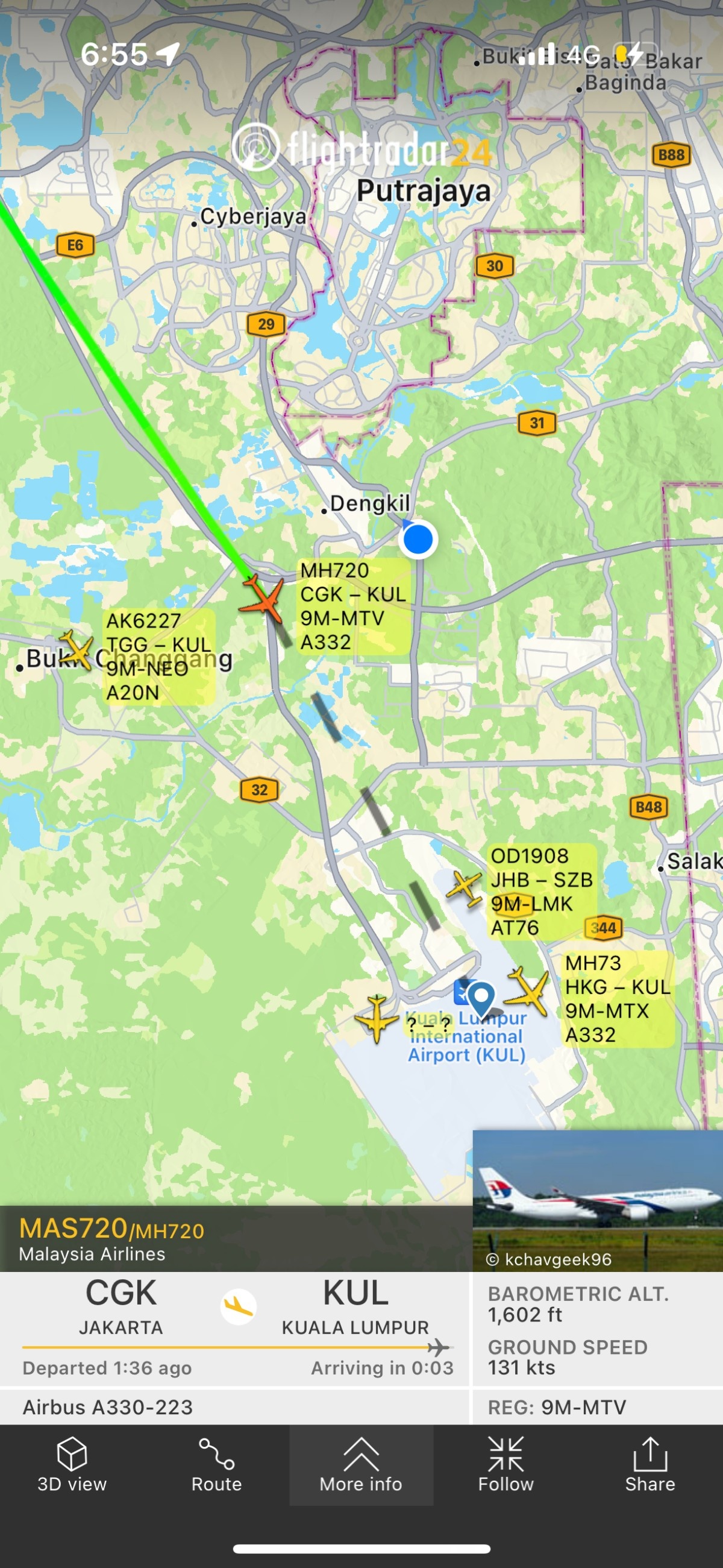
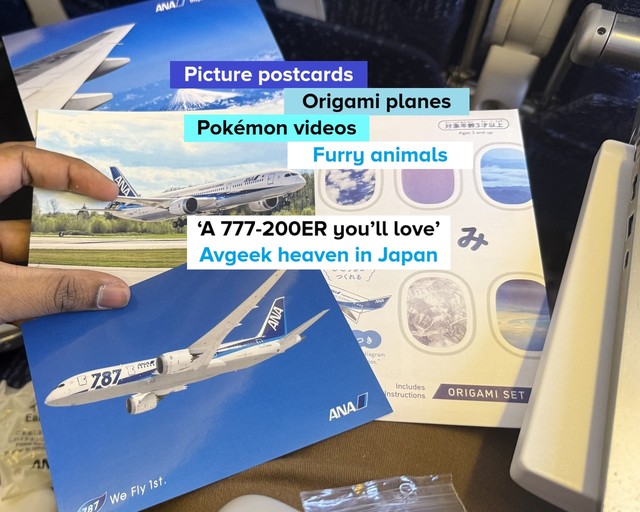




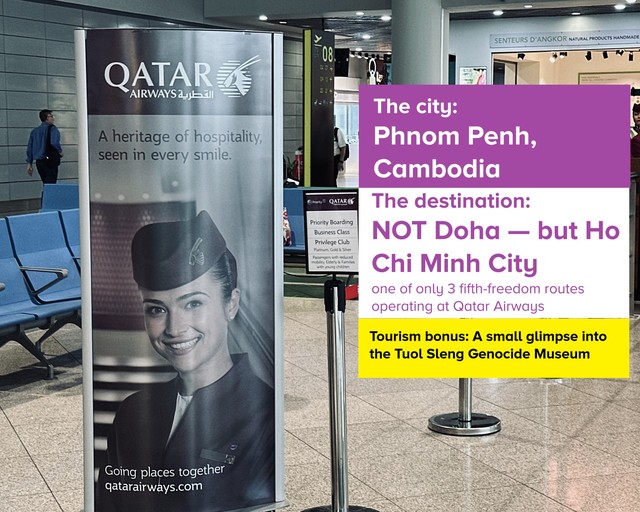

Thanks for the intresting trip report on a boeing 7879 and the newly renovated terminal 2 was nice especially the waterfall as well as interesting city name on the b7879 which is the city i been to recently hope you enjoy taking more star alliance carrier in 2024
Wow, this sure is a crowded route with lots of competition! Interesting choice by ET for a 5th freedom flight considering there are so many flights on this short route. Nice product for a short-haul, though, compared to all the narrowbodies. And also probably one of the more exotic options.
Thanks for sharing!